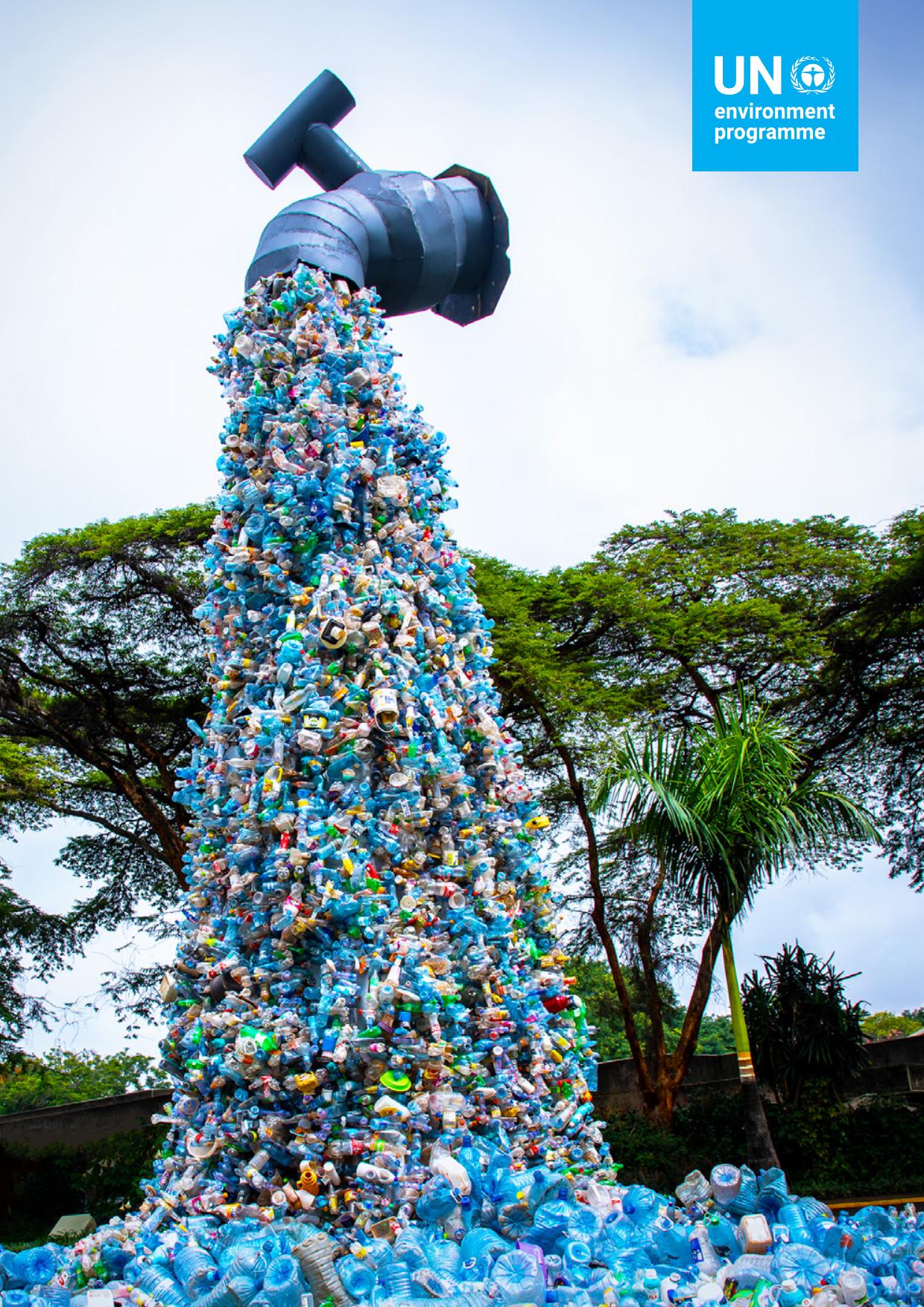TurningofftheTapHowtheworldcanendplasticpollutionandcreateacirculareconomy©2023UnitedNationsEnvironmentProgrammeISBN:978-92-807-4024-0Jobnumber:DTI/2522/NAThispublicationmaybereproducedinwholeorinpartandinanyformforeducationalornon-profitserviceswithoutspecialpermissionfromthecopyrightholder,providedacknowledgementofthesourceismade.TheUnitedNationsEnvironmentProgrammewouldappreciatereceivingacopyofanypublicationthatusesthispublicationasasource.NouseofthispublicationmaybemadeforresaleoranyothercommercialpurposewhatsoeverwithoutpriorpermissioninwritingfromtheUnitedNationsEnvironmentProgramme.Applicationsforsuchpermission,withastatementofthepurposeandextentofthereproduction,shouldbeaddressedtounep-communication-director@un.org.DisclaimersThedesignationsemployedandthepresentationofthematerialinthispublicationdonotimplytheexpressionofanyopinionwhatsoeveronthepartoftheSecretariatoftheUnitedNationsconcerningthelegalstatusofanycountry,territoryorcityorareaoritsauthorities,orconcerningthedelimitationofitsfrontiersorboundaries.MentionofacommercialcompanyorproductinthisdocumentdoesnotimplyendorsementbytheUnitedNationsEnvironmentProgrammeortheauthors.Theuseofinformationfromthisdocumentforpublicityoradvertisingisnotpermitted.Trademarknamesandsymbolsareusedinaneditorialfashionwithnointentiononinfringementoftrademarkorcopyrightlaws.TheviewsexpressedinthispublicationarethoseoftheauthorsanddonotnecessarilyreflecttheviewsoftheUnitedNationsEnvironmentProgramme.Weregretanyerrorsoromissionsthatmayhavebeenunwittinglymade.©Maps,photosandillustrationsasspecifiedCoverphoto:Picture©UNEP.ArtInstallation©VonWongProductions,#TurnOffThePlasticTap.TheGiantPlasticTapwasanartinstallationbyartistBenjaminVonWongattheUNHeadquartersinNairobi.ItwasondisplayduringtheUnitedNationsEnvironmentAssemblyin2022,whendelegatesagreedtoestablishanIntergovernmentalNegotiatingCommitteewiththemandatetoforgeaninternationallegallybindingagreementtoendplasticpollution.Suggestedcitation:UnitedNationsEnvironmentProgramme(2023).TurningofftheTap.Howtheworldcanendplasticpollutionandcreateacirculareconomy.Nairobi.Production:UnitedNationsEnvironmentProgrammehttps://www.unep.org/resources/turning-off-tap-end-plastic-pollution-create-circular-economyAcknowledgements“TurningofftheTap.Howtheworldcanendplasticpollutionandcreateacirculareconomy”istheproductofthegenerousdedicationandextraordinaryinvestmentofnumerousindividuals,whoseknowledge,expertiseandinsighthelpedshapethisimportantbodyofwork.UNEPacknowledgesthecontributionsmadebymanygovernments,individualsandinstitutionstothepreparationandpublicationofthisreport.Specialthanksareextendedto:ThispublicationwasfinanciallysupportedbytheGovernmentsofNorwayandSweden.LeadAuthors:UNEP:LlorençMilàiCanals(leadcoordinator);AlisonCairns;PeggyLefort;AllanMeso;AndrewDavidRaine;AphroditeSmagadi;StevenStone;ElisaTonda.Systemiq:YoniShiran;JosédelaFuente;JuliaKoskella;AnneTitiaBove;ElineBoon.UniversityofPortsmouth:SteveFletcher;AntayaMarch;KeironRoberts.KnowlEdgeSrl:AndreaBassiOverallsupervision:SheilaAggarwal-Khan,AndreaHinwood,UNEP.Contributingauthors:VincentAloysius,SandraAverous,StephanieGerretsen,ClaudiaGiacovelli,TomaIida,PushpamKumar,StéphanieLaruelle,SilvanaLoayzaLeón,EkaterinaPoleshchuk,HeidiSavelli,HimanshuSharma,RanXie,XiaozhenXu(UNEP);NatalieHarms(UNEP–COBSEA);KeiOhnoWoodall(UNEP–BRS);KabirArora(WomeninInformalEmploymentGlobalizingandOrganizing,WIEGO);NaoTakeuchi(UNHabitat);AnjaliAcharya,MilagrosAimé(WorldBankGroup).Reviewers:Thefollowingexpertsaregratefullyacknowledgedforsupportingthepreparationofthereport,includingprovidingcommentsontwoversionsofthedraftreport(July2022andMarch2023):CarstenWachholz,SanderDefruyt(EllenMacArthurFoundation);JohnDuncan,AlixGrabowski,HoHuuHuy,ErinSimon,AnthonyTusino,JessZeuner(WWF);TimothyGrabiel,ThomasGammage,ChristinaDixon,JacobKean-Hammerson,AmyYoungman(EnvironmentalInvestigationAgency);AndrésdelCastillo,GiuliaCarlini(CIEL);ThomasMaes,IevaRucevska(GRID-Arendal);LizzieFuller,DominicCharles,EbonyMinicozzi,EmmaSilver,MargotDons(MinderooFoundation);GonzaloMuñoz,GasparGuevara,CarlaGermani(Manuia);CarolynDeereBirkbeck,MaheshSugathan,SimonArdila(TESS);KabirArora(WIEGO);LarkeWilliams,RossAlliston,EricDavidson,So-JungYoun(U.S.DepartmentofState,OfficeofEnvironmentalQuality);PattiPedrus(FederatedStatesofMicronesia);GordanaTopic(EuropeanCommission);GoKobayashi(MarinePlasticPollutionOffice,MinistryofEnvironmentJapan);SiljeRem(NorwegianEnvironmentAgency);CarmenZuloagaMarín,ClaudiaAlejandraGuerreroAlvarado(MinistryofEnvironment,Chile);AndrewBrown,ElenaBuzzi,FrithjofLaubinger,GiuliaGalli(OECD);KristinHughes,ChristianKaufholz,MadeleineBrandes(WEF-GlobalPlasticActionPartnership);AnjaliAcharya,MilagrosAimé(WorldBankGroup);MoustaphaKamalGueye,TahminaMahmud,SarahGondy,YasuhikoKamakura(InternationalLabourOrganization);GerganaKiskinova,DanielRamos(WorldTradeOrganization);HenriqueSilvaPaciniCosta(UnitedNationsConferenceonTradeandDevelopment);DesireeRaquelNarvaez(UNICEF);BernardBarth,VoltaireAcosta(UNHabitat)BingZhu(TsinghuaUniversity);KarenRaubenheimer(UniversityofWollongong);ParomitaChakraborty(SRMInstituteofScienceandTechnology);RichardThompson(UniversityofPlymouth);SabinePahl(UniversityofVienna);RosalindMalcom(UniversityofSurrey);RachelKarasik(DukeUniversity);VikasChhajer(GeminiCorporationNV);JodieRoussell,JochenHertlein(SociétédesProduitsNestléS.A.);VincentColard(CITEO);Anne-GaelleCollot(PlasticsEurope/WorldPlasticsCouncil);StewartHarris(AmericanChemistryCouncil/WorldPlasticsCouncil);EdShepherd(Unilever);WillemijnPeeters(SeariousBusiness);RolandWeber(POPsEnvironmentalConsulting);SvenSaura(Veolia).iReviewers(UNEP):TheexpertreviewfromthefollowingUNEPcolleaguesisalsoacknowledged:JacquelineAlvarez;KatyAyres;JuanBello;AtifIkramButt;BeatrizMartinsCarneiro;GarretteClark;LudgardeCoppens;JostDittkrist;KamalaErnest;BeatrizFernández;HilaryFrench;TessaGoverse;BettinaHeller;MijkeHertoghs;MariaHughes;TomaIida;JoyKim;BrendaKoekkoek;PaoloMarengo;AlexanderMangwiro;DavidMarquis;PatriciaMbote;MushtaqMemon;LauraMesias;SvitlanaMikhalyeva;SusanMutebi-Richards;IyngararasanMylvakanam;KakukoNagatani-Yoshida;TakehiroNakamura;FatouNdoye;FabiennePierre;JoséPineda;JordiPon;HelenaRey;AmélieRitscher;DavidRubia;MalgorzataAlicjaStylo;CallumSweeney;ClaireThibault;GinaTorregroza;FengWang;AlisonWatson;YingZhang;MariaCristinaZucca;TabeaZwimpfer.Productionandlaunchsupport:UNEPCommunicationDivisionEditor:AmandaLawrence-BrownDesignandlayout:BeverleyMcDonald,withcontributionfromMuratOzoglu.iiAcronymsBAU-Business-as-usualBPA-BisphenolACapex-CapitalexpenditureCEN-EuropeanCommitteeofStandardisationDEHP-Di(2-ethylhexyl)phthalateEIA-EnvironmentalInvestigationAgencyEMF-EllenMacArthurFoundationEOL-End-of-LifeEPR-ExtendedProducerResponsibilityEPS-ExpandedpolystyreneESM-EnvironmentallysoundmanagementEU-EuropeanUnionG20-TheGroupofTwenty(thepremierforumforinternationaleconomiccooperation)GDP-GrossdomesticproductGESAMP-JointGroupofExpertsontheScientificAspectsofMarineEnvironmentalProtectionGHG-GreenhousegasGIZ-GermanAgencyforInternationalCooperationHDPE-High-densitypolyethyleneHI-High-incomeeconomiesICAO-InternationalCivilAviationOrganizationIFC-InternationalFinanceCorporationILO-InternationalLabourOrganizationIMO-InternationalMaritimeOrganizationINC-IntergovernmentalNegotiationCommitteeIRP-InternationalResourcePanelISO-InternationalOrganizationforStandardizationISWA-InternationalSolidWasteAssociationIUCN-InternationalUnionforConservationofNatureLCA-LifeCycleAssessmentLDPE-Low-densitypolyethyleneLI-Low-incomeeconomiesLiFE-LifestylesforEnvironmentLLDPE-Linearlow-densitypolyethyleneMMt–MillionmetrictonsNIVA-NorwegianInstituteforWaterResearchNPV-NetPresentValueOECD-OrganisationforEconomicCo-operationandDevelopmentOpex-OperationalexpenditureP2F-Plastic-to-fuelP2P-Plastic-to-plasticPBDE-PolybrominateddiphenylethersPCDD/F-poly-chlorinateddibenzo-p-dioxinsanddibenzofurans(dioxinsandfurans)PCR-Post-consumerrecycledcontentPE-PolyethylenePET-PolyethyleneterephthalatePFASs-PolyfluoroalkylsubstancesPOPs-PersistentorganicpollutantsPP-PolypropylenePPA-PowerpurchaseagreementsPS-PolystyrenePVC-PolyvinylchlorideR&D-ResearchandDevelopmentRDF-Refuse-derivedfuelRPET-RecycledPETSAPEA-ScienceAdviceforPolicybyEuropeanAcademiesSCscenario-SystemschangescenarioSDG-SustainableDevelopmentGoalsUMI-Uppermiddle-incomeeconomiesUNEP-UnitedNationsEnvironmentProgrammeUNIDO-UnitedNationsIndustrialDevelopmentOrganizationWEEE-WastefromElectricalandElectronicEquipmentWEF-WorldEconomicForumWWF-WorldWideFundforNatureiiiAdditives-plasticisusuallymadefrompolymermixedwithacomplexblendofchemicalsknownasadditives.Theseadditives,whichincludeflameretardants,plasticizers,pigments,fillersandstabilisersareusedtoimprovethedifferentpropertiesoftheplasticortoreduceitscost(ThePewCharitableTrustsandSystemiq2020).Business-as-usual(BAU)-seedefinitionunder‘Scenarios’.Bio-basedplastic-plasticderivedfullyorpartiallyfromplantmaterials,suchascellulose,potatoorcornstarch,sugarcane,maizeandsoy,insteadofpetroleumornaturalgas.Bio-basedplasticcanbeengineeredtobebiodegradableorcompostable,buttheycanbedesignedtobestructurallyidenticaltopetroleum-basedplastics,inwhichcasetheycanlastintheenvironmentforthesameperiodoftime(UNEPLawandEnvironmentAssistancePlatformn.d.)Bio-benign(materials)-amaterialharmlesstonaturalsystemsincaseitunintentionallyescapescollectionandrecoverysystems.Biodegradable(materials)-amaterialthatcan,withthehelpofmicroorganisms,breakdownintonaturalcomponents(e.g.water,carbondioxideorbiomass)undercertainconditions(ThePewCharitableTrustsandSystemiq2020).Capex(capitalexpenditures)-fundsusedbyanorganisationtoacquireorupgradeassetssuchasproperty,buildings,technology,orequipment.Chemicalconversion-processthatbreaksdownpolymersintoindividualmonomersorotherhydrocarbonproductsthatcanthenserveasbuildingblocksorfeedstocktoproducepolymersagain(ThePewCharitableTrustsandSystemiq2020).Circulareconomy-oneofthecurrentsustainableeconomicmodels,inwhichproductsandmaterialsaredesignedinsuchawaythattheycanbereused,remanufactured,recycledorrecoveredandthusmaintainedintheeconomyforaslongaspossible,alongwiththeresourcesofwhichtheyaremade,andthegenerationofwaste,especiallyhazardouswaste,isavoidedorminimized,andgreenhousegasemissionsarepreventedorreduced,cancontributesignificantlytosustainableconsumptionandproduction(UNEP/EA.4/Res.1).Circularinfrastructure-forthepurposesofthisreport,circularinfrastructureisunderstoodasthatwhichcontributestocircularity,e.g.collectionandreverselogisticsschemes,washingsystemsforreuseschemes,recyclinginfrastructure,etc.Infrastructureforenddisposal(e.g.landfillsandincinerationwithorwithoutenergyrecovery)areexcludedfromthisworkingdefinition.Circularplasticproducts-aredesignedtobereusedsafelymanytimes,andtheirmaterialrecycledorcompostedattheendofuse,inpracticeandatscale,minimizingtheiradverseenvironmentalimpactsandrespectingtherights,healthandsafetyofallpeopleinvolvedacrosstheirlifecycle(UNEP/PP/INC.1/7),includingproductusers(adaptedfromUNEP/PP/INC.1/7toincludehealthconsiderations).Closed-looprecycling-istherecyclingofplasticintoanynewapplicationthatwilleventuallybefoundinmunicipalsolidwaste,essentiallyreplacingvirginfeedstock(i.e.plasticbottle,penetc.)(See‘Recycling’)(ThePewCharitableTrustsandSystemiq2020).Compostable(materials)-materials,includingcompostableplasticandnon-plasticmaterials,thatareapprovedtomeetlocalcompostabilitystandards(forexample,industrialcompostingstandardEN13432,whereindustrial-equivalentcompostingisavailable)(ThePewCharitableTrustsandSystemiq2020).Designforrecycling-theprocessbywhichcompaniesdesigntheirproductsandpackagingtoberecyclable.(See‘Recycling’).Downcycling–recyclingprocesseswheretherecoveredmaterialisoflowerqualityorfunctionalitythantheoriginalmaterial,duetoe.g.structuralstrength,composition/impurities,colourorotherproperties.Downstreamactivities–involveend-of-lifemanagement–includingsegregation,collection,sorting,recyclinganddisposal.Recyclingisaprocessthatstartsdownstreamand‘closestheloop’byconnectingwithupstream(i.e.startinganewlifecyclefornewplasticproductswitholdmaterials).Similarly,repair/refurbishprocessesprovideanotherwaytoclosetheloopbybringingproductsbackintothemidstream(UNEP/PP/INC.1/7).GlossaryivDumpsites-placeswherecollectedwastehasbeendepositedinacentrallocationandwherethewasteisnotcontrolledthroughdaily,intermediateorfinalcover,thusleavingthetoplayerfreetoescapeintothenaturalenvironmentthroughwindandsurfacewater(ThePewCharitableTrustsandSystemiq2020).Durableplastics-plasticmaterialsoftenselectedforapplicationsrequiringresistance.Referstotheplasticswithaverageusecyclesabovethreeyears.Theseplasticsarefrequentlyusedforindustrialandconstructionapplications(Geyer,JambeckandLaw2017).End-of-Life(EOL)–ageneralisedtermtodescribethepartofthelifecyclefollowingtheusephase.Essential(plasticproducts)use–usesthatareconsiderednecessaryforhealth,safetyorotherimportantpurposesforwhichalternativesarenotyetestablished(GarnettandVanCalster2021).ExtendedProducerResponsibility(EPR)–isanenvironmentalpolicyapproachinwhichaproducer’sresponsibilityforaproductisextendedtothewastestageofthatproduct’slifecycle.Inpractice,EPRinvolvesproducerstakingresponsibilityforthemanagementofproductsaftertheybecomewaste,including:collection;pre-treatment,e.g.sorting,dismantlingordepollution;(preparationfor)reuse;recovery(includingrecyclingandenergyrecovery)orfinaldisposal.EPRsystemscanallowproducerstoexercisetheirresponsibilitybyprovidingthefinancialresourcesrequiredand/orbytakingovertheoperationalaspectsoftheprocessfrommunicipalities.Theyassumetheresponsibilityvoluntarilyormandatorily;EPRsystemscanbeimplementedindividuallyorcollectively(UNEP/PP/INC.1/6).Feedstock–anybulkrawmaterialthatistheprincipalinputforanindustrialproductionprocess.Flexiblemonomaterialplastics-seedefinitionunder‘Plasticcategories’.Geographicarchetype-partsoftheworldwithsimilarcharacteristicswhenitcomestoplasticwaste.Thearchetypesaredividedintogroupsdependingoncountryincome,accordingtoWorldBankdefinitions:high-incomeeconomies;upperandlowermiddle-incomeeconomies;andlow-incomeeconomies.Theruralandurbansettingsforeachofthefourincomegroupsarealsoanalysedseparatelytocreateeightgeographicarchetypes(ThePewCharitableTrustsandSystemiq2020).Incineration-destructionandtransformationofmaterialtoenergybycombustion.Informalwastesector–whereworkersandeconomicunitsareinvolvedinsolidwastecollection,recoveryandrecyclingactivitieswhichare–inlaworinpractice–notcoveredorinsufficientlycoveredbyformalarrangements.Leakage–materialsthatdonotfollowanintendedpathwayand‘escape’orareotherwiselosttothesystem.Litterisanexampleofsystemleakage(ThePewCharitableTrustsandSystemiq2020).Legacy(plastic)-plasticsthatcannotbereusedorrecycled,includingplasticsthatarealreadyintheenvironmentasexistingpollution,orarestockedorwillenterintheeconomye.g.inshort-livedordurableproductsdesignedwithoutconsideringtheircircularityorlong-termuseintheeconomy.Managedlandfill-aplacewherecollectedwastehasbeendepositedinacentrallocationandwherethewasteiscontrolledthroughdaily,intermediateandfinalcover,thuspreventingthetoplayerfromescapingintothenaturalenvironmentthroughwindandsurfacewater(ThePewCharitableTrustsandSystemiq2020).Maritimesources-allplasticsthatentertheenvironmentfromseagoingvessels(includingfromfishingactivities)(ThePewCharitableTrustsandSystemiq2020).Mechanicalrecycling-processingofplasticswasteintosecondaryrawmaterialorproductswithoutsignificantlychangingthechemicalstructureofthematerial(ISO:472:2013).Microfibres-microsizefragments(<5mm)releasedviatextilessheddingtoair,waterorwastewaterduringproductionoruse.Microplastics–referstoplasticparticleslessthanfivemillimetresdiameter,includingnano-sizedparticles(UNEP/EA.2/Res.11).Midstreamactivities–involvethedesign,manufacture,packaging,distribution,use(andreuse)andmaintenanceofplasticproductsandservices.Keepingplasticproductsatmidstreamaslongaspossibleisidealforcircularity,becausethisiswhereplasticproductshavetheirhighestvalue(UNEP/PP/INC.1/7).Mismanagedwaste-collectedwastethathasbeenreleasedordepositedinaplacefromwhereitcanmoveintothenaturalenvironment(intentionallyorotherwise).Thisincludesdumpsitesandunmanagedlandfills.Uncollectedwasteiscategorisedasunmanaged(ThePewCharitableTrustsandSystemiq2020).vMonomaterials-seedefinitionunder‘Plasticcategories’.Multimaterials-seedefinitionunder‘Plasticcategories’.Multilayerplastics-seedefinitionunder‘Plasticcategories’.MunicipalSolidWaste(MSW)-includesallresidentialandcommercialwastebutexcludesindustrialwaste.Newdeliverymodels-servicesandbusinessesprovidingutilitypreviouslyfurnishedbysingle-useplasticsinnewways,withreducedmaterialdemand(ThePewCharitableTrustsandSystemiq2020).Nurdles-see‘Pellets’.Openburning-wastethatiscombustedwithoutemissionscleaning.Open-looprecycling-processbywhichpolymersarekeptintact,butthedegradedqualityand/ormaterialpropertiesoftherecycledmaterialisusedinapplicationsthatmightotherwisenotbeusingplastic(i.e.benchesandasphalt)(ThePewCharitableTrustsandSystemiq2020).Opex(operatingexpenses)-operatingexpensesincurredduringthecourseofregularbusiness,suchasgeneralandadministrativecosts,salesandmarketing,orresearchanddevelopment.Oxo-degradable-productscontainingapro-oxidantthatinducesbreakdownoftheplasticproductintosmallerpiecesunderfavourableconditions(e.g.heat,UV-lightandmechanicalstress).Pathway-acourseofactionthatcombinessysteminterventionsacrossgeographicarchetypestoachieveadesiredsystemoutcome(ThePewCharitableTrustsandSystemiq2020).Pellets-microsize(≤5mm)granulesusuallywithashapeofcylinderoradisk,producedasarawmaterial(alsofromplasticrecycling)andusedinthemanufactureofplasticproducts(ThePewCharitableTrustsandSystemiq2020).Plasticcategories-modelledasflowingseparatelythroughthesystem:rigidmonomaterialplastics,flexiblemonomaterialplastics,multilayerplasticsandmultimaterials(ThePewCharitableTrustsandSystemiq2020).•Rigidmonomaterialplastics-Anitemmadefromasingleplasticpolymerthatholdsitsshape,suchasabottleortub•Flexiblemonomaterialplastics-Anitemmadefromasingleplasticpolymerthatisthin,suchasplasticwrapsandbags•Multilayerplastics-Anitem,usuallypackaging,madeofmultipleplasticpolymersthatcannotbeeasilyandmechanicallyseparated•Multimaterials-Anitem,usuallypackaging,madeofplasticandnon-plasticmaterials(suchasthinmetalfoilsorcardboardlayers)thatcannotbeeasilyandmechanicallyseparated.Plasticpollution-definedbroadlyasthenegativeeffectsandemissionsresultingfromtheproductionandconsumptionofplasticmaterialsandproductsacrosstheirentirelifecycle.Thisdefinitionincludesplasticwastethatismismanaged(e.g.open-burnedanddumpedinuncontrolleddumpsites)andleakageandaccumulationofplasticobjectsandparticlesthatcanadverselyaffecthumansandthelivingandnon-livingenvironment(UNEP/PP/INC.1/7).Plastic-to-Fuel(P2F)-processbywhichtheoutputmaterialofchemicalconversionplantsisrefinedintoalternativefuelssuchasdiesel(ThePewCharitableTrustsandSystemiq2020).Plastic-to-Plastic(P2P)-severalchemicalconversiontechnologiesarebeingdevelopedthatcanproducepetrochemicalfeedstockthatcanbereintroducedintothepetrochemicalprocesstoproducevirgin-likeplastic(ThePewCharitableTrustsandSystemiq2020).Plasticutility-thevaluableservices(includingprotection,foodpreservationetc.)thatareprovidedbyplasticunderaBusiness-as-usualscenario.Inalternativescenarios,servicesofequivalentvaluecouldbeprovidedinotherwayswithlessplastic(ThePewCharitableTrustsandSystemiq2020).viPolymers:•PET-Polyethyleneterephthalate•HDPE-High-densitypolyethylene•LDPE-Low-densitypolyethylene•LLDPE-Linearlow-densitypolyethylene•PP-Polypropylene•PVC-Polyvinylchloride•EPS-Expandedpolystyrene•PS-Polystyrene•PA6-Polyamide6(Nylon)Recyclable-forsomethingtobedeemedrecyclable,thesystemmustbeinplaceforittobecollected,sorted,reprocessed,andmanufacturedbackintoanewproductorpackaging—atscaleandeconomically.Recyclableisusedhereasashort-handfor‘mechanicallyrecyclable’.See‘mechanicalrecycling’definition(ThePewCharitableTrustsandSystemiq2020).Recycling-meansprocessingofwastematerialsfortheoriginalpurposeorforotherpurposes,excludingenergyrecovery(ISO:472:2013).Resin-anaturalorsyntheticsolidorviscousorganicpolymerusedasthebasisofplastic,adhesives,varnishesorotherproducts.Reusable-productsandpackaging,includingplasticbags,thatareconceivedanddesignedtoaccomplishwithintheirlifecycleaminimumnumberofusesforthesamepurposeforwhichtheywereconceived(adaptedfromtheLEAPUNEPPlasticGlossary).Intermsof‘minimumnumberofuses’,thePR3Standardssuggestthatreusable(containers)shouldbedesignedtowithstandatleast10reusecycles.Reuse-meansuseofaproductmorethanonceinitsoriginalform(ISO:472:2013).Reverselogistics-activitiesengagedtorecapturethevalueofproducts,parts,andmaterialsoncetheyhavereachedend-of-useorend-of-life.AllValueRetentionProcesses(suchasreuse)maybeconsideredtobepartofareverse-logisticssystem,andinadditionactivitiesincludingcollection,transportation,andsecondarymarketsprovideessentialmechanismsforfacilitatingreverse-logistics(IRP2018)Rigidplastics-seedefinitionunder‘Plasticcategories’.Ruralvs.Urban-seedefinitionunder‘Urbanvs.Rural’.Safedisposal-ensuringthatanywastethatreachesitsend-of-lifeisdisposedinawaythatdoesnotcauseleakageofplasticwasteorchemicalsintotheenvironment,doesnotposehazardousriskstohumanhealthand,inthecaseoflandfills,iscontainedsecurelyforthelong-term(ThePewCharitableTrustsandSystemiq2020).Secondarymicroplastics-smallparticlepiecesthathaveresultedfromthefragmentationandweatheringoflargerplasticitems(UNEPPlasticGlossary:https://leap.unep.org/knowledge/toolkits/plastic/glossary).Scenarios-forthepurposeofthisreport,wedefinethescenariosas:•Business-as-usual(BAU)scenario:Definedas‘nointervention’scenario;inotherwords,assumesthatthecurrentpolicyframework,marketdynamics,culturalnorms,andconsumerbehavioursdonotchange.•Systemschangescenario:Assumesallsystemoutcomesareactionedconcurrently,ambitiouslyandimmediately.Short-livedplasticproduct-plasticswithinpackagingandconsumerproducts.Thesearethetwocategoriesofplasticproductswithshortestaverageusecycles–0.5and3yearsrespectively(Geyer,JambeckandLaw2017).Notethatthecategorisationisbasedonaveragelifespan,thereforesomeproductsinthiscategorywillinpracticehavelongerlifespansthanthreeyears.Single-useplasticproducts-oftenreferredtoasdisposableplastics,arecommonlyusedplasticitemsintendedtobeusedonlyoncebeforetheyarethrownawayorrecycled,e.g.grocerybags,foodpackaging,bottles,straws,containers,cups,cutleryetc.(UNEPPlasticGlossary:https://leap.unep.org/knowledge/toolkits/plastic/glossary).viiSystemschange-capturestheideaofaddressingthecauses,ratherthanthesymptomsofasocietalissuebytakingaholistic(or‘systemic’)view.Systemicchangeisgenerallyunderstoodtorequireadjustmentsortransformationsinpolicies,practices,powerdynamics,socialnormsormindsets.Itofteninvolvesadiversesetofplayersandcantakeplaceonalocal,nationalorgloballevel(AshokaDeutschlandgGmbHandMcKinsey&CompanyInc.2021);systemschangerequiresmodificationsinmanyofthesystemstructures,suchasthemindsetortheparadigmthatcreatesthesystemorthesystem’sgoalsorrules(Meadows1999).Systemschangescenario-seedefinitionunder‘Scenarios’.Tyredust-consistsofmicrosizeparticleswithaspectrumfromairborne(>10μm)tocoarsefraction(>1mm)releasedthroughmechanicalabrasionoftyres,withchemicalcompositiondependingonrubbertype(ThePewCharitableTrustsandSystemiq2020).Upstreamactivities-includeobtainingtherawmaterialsfromcrudeoil,naturalgasorrecycledandrenewablefeedstock(e.g.biomass)andpolymerization.Plasticleakageintotheenvironment(e.g.pelletsandflakes)alreadyhappensatthisstage(UNEP/PP/INC.1/7).Urbanvs.Rural-theclassificationofurbanversusruralisinalignmentwiththeUnitedNationsStatisticsDivision,whichallowscountriestousetheirownapproachesfordistinguishingurbanandruralareasaccordingtotheirindividualcircumstances(ThePewCharitableTrustsandSystemiq2020).viiiTableofContentsAcknowledgementsiAcronymsiiiGlossaryivForewordxiiExecutiveSummaryxiii1.Theneedforacompasstoendplasticpollution011.1Purposeofthisreport021.2Scopeandmethodology041.3Theeconomiccaseforcircularityinplastics051.4Thesystemschangescenario:Aneconomicopportunity081.5Abetterplasticsfuture142.Markettransformations:Creatingthemarketplaceforthenewcircularplasticseconomy182.1Marketshiftone:Acceleratereuse202.2Marketshifttwo:Acceleraterecycling252.3Marketshiftthree:Reorientanddiversifythemarketforsustainableandsafeplasticalternatives342.4Addressingdemandfordurableplasticproducts393.Dealingwiththelegacy413.1Preventmicroplasticsattheirsource423.2Identifyorbuildsafewastedisposalfacilities443.3Eliminateplasticwasteexportsexceptinspecificsituations473.4Dealwiththeexistingpollution484.Policyandlegislativechangesrequired504.1Regulatoryinterventions514.2Aharmonisedapproachtomeasuresandobligations584.3Establishaglobalmonitoringandreportingsystem595.Conclusion60References62Annex1:MethodologyTopicsheets:•ReuseSchemes•MaterialsandProductsSubstitutions•ExtendedProducerResponsibility•CriteriaforChemicalsinPlastics•DesignGuidelinesforCircularity•ChemicalRecycling•JustTransition•ThinkGlobal,ActLocal,NOWixTable1:06Damageestimatesofplasticpollutionacrossthelifecycleofplastics(inbillionUSDperyear).Table2:08Summaryofthecoefficientsusedinthestudy.Table3:16Thesystemschangescenariooutcomesandscaleofchangeinthenext5yearsandby2040.Table4:22Implicationsofthereuseshiftfordifferentactorsacrossthevaluechain.Table5:27Implicationsoftherecyclingshiftfordifferentactorsacrossthevaluechain.Table6:33Innovationopportunitiestounlockgreaterimpactfromrecycling.Table7:36Implicationsofthereorientanddiversifyshiftfordifferentactorsacrossthevaluechain.Table8:53Policyandlegislativeoptionstosupportthemarkettransformation.Table9:58Aharmonisedapproachtomeasuresandobligations.ListoffiguresFigureES1:xivThesystemschangetowardsanewcircularplasticseconomy.FigureES2:xviPossibleplasticfutures.Figure1:02Short-livedplasticflowsin2020.Figure2:04Totalplasticwastein2019bycategory,millionmetrictons(MMt).Figure3:05Relativevalueofsocialcostsandlikelihoodofconsensusonplasticpollutionrelatedexternalities.Figure4:07Wedgesshowingshareoftreatmentoptionsforplasticsfromshort-livedproductsenteringthesystemunderasystemschangescenariofrom2016to2040.Figure5:09Totalsystemcostsforshort-livedplasticsforthebusiness-as-usualandsystemschangescenarios(2021–2040).Figure6:10Netchangeinannualcostsbetweenthebusiness-as-usualandsystemschangescenarios(SC-BAU),2021-2040(inconstant2020USDbillion).Figure7:12Totaljobsindifferentpartsoftheshort-livedplasticsvaluechaininthecurrentmarket,andunderbusiness-as-usualandsystemschangescenarios.ListoftablesxFigure8:14Thecompasstoendplasticpollution.Figure9:15Top:Modelledshort-livedplasticflowsin2040underabusiness-as-usualscenario.Bottom:Modelledshort-livedplasticflowsin2040underasystemschangescenariotodeliverthenecessarymarkettransformation.Figure10:24Utilitydemandin2016and2040,andhowitismetbyeliminatesolutionsandthereuseshiftinthesystemschangescenario.Figure11:28Pollutionvs.productionbyplastictype.Figure12:29Collectionratesrequiredtoachievesystemschange.Figure13:30Mechanicalrecyclingcapacity(MMt/year).Figure14:31Chemicalconversioncapacityin2040(MMt/year)byregion.Figure15:34TheroleofreorientinganddiversifyinginasystemschangescenariocomparedtoBAU2040.Figure16:43MicroplasticpollutionunderBAUandreductionfromfoursourcesunderthesystemschangescenarioin2040.Figure17:44Volumes(MMt)tobesafelydisposedbyregion.Figure18:47Volumes(MMt)exportedinsystemschangescenariovs.business-as-usual.xiTurningofftheTapPlastics,inmanyways,contributepositivelytosociety.Thereis,however,adarkside:thewayweproduce,useanddisposeofplasticsispollutingecosystems,creatingrisksforhumanandanimalhealthanddestabilizingtheclimate.Forthesereasons,theinternationalcommunityisnegotiatingadealtoendplasticpollution,whichisdueby2024.Thisreport,TurningofftheTap:Howtheworldcanendplasticpollutionandcreateacirculareconomy,isdesignedtoinformnegotiationsandhelpendthispervasiveandgrowingthreat.Thereportshowsthatonlyanintegrated,systemicshiftfromalineartoacirculareconomycankeepplasticsoutofourecosystemsandbodies,andintheeconomy.Thereportlaysoutkeyelementsoftherequiredmarkettransformation–rethinkingandredesigningproducts;reusing,recycling,reorientinganddiversifyingmarkets;andaddressingdemandfordurableplastics.Thereportsalsolooksathowtomanagethelegacyofplasticpollutionalreadyintheenvironment,anditdefinesthepolicyandlegislativechangesthatcandrivethetransformation.Crucially,thereportdemonstratesthatthetransformationwouldprovideeconomicandsocialwins.Governmentsandtheprivatesectorwouldsavemoneyandhundredsofthousandsofnewjobswouldbecreated,contributingtopovertyalleviationandajusttransitionforworkers.Everybodyhasaroletoplay.Governmentscancreatetheregulatoryenvironmenttoincentivizetheshifttoacirculareconomy–andthepoliticalwilltodosoisthere,backedbybroadsocialsupport.Thepetrochemicalindustry,municipalities,informalwastepickers,plasticconvertersandkeyusers–suchaspackaging,textile,transport,fisheriesandagricultural–canacceleratereuseandrecyclingandensurethesustainabilityofalternativesintroducedinthemarket.Thefinanceindustrycanplayacentralrolebyaligningcapitalflowswithacircularplasticseconomy.UNEP,ashostoftheIntergovernmentalNegotiatingCommitteeandalong-termactoronplastics,isfullycommittedtoworkingwithallrelevantpartiestoendplasticpollution.Thisreportprovidesclearguidanceasweundertakethisnecessaryjourneytoahealthierandmoreprosperousdestination.Wemustallfollowthisguidancetostartturningoffthetaponplasticpollution.IngerAndersenExecutiveDirector,UNEPForewordxiiExecutiveSummaryInahistoricdecisionatthefifthUnitedNationsEnvironmentAssemblyinMarch2022,all193UNMemberStatesdecidedtoendplasticpollution.Withnegotiationsonabindinglegalagreementby2024nowunderway,thequestionishowtorealisethatgoal.Whilemanytechnicalsolutionsforacircularplasticseconomyareknown,theeconomic,fiscalandbusinessmodelstoaddresstheassociatedimpactswhilealsosafeguardinglivelihoodsarelessclear.Thisreportexaminestheseissuesandproposesasystemschangescenario-addressingthecausesofplasticpollution,ratherthanjustthesymptoms.Suchasystemschangewillenablecountriestoturnoffthetapandendplasticpollutionwhileatthesametimetransitioningtowardssaferandmorestablejobsforthosecurrentlyworkingintheinformalsector,andcreatebusinessandjobopportunities.Thereportanalysestheopportunitiesandimpactsofasystemschangescenario.Thescenariocombinesreducingthemostproblematicandunnecessaryplasticuseswithamarkettransformationtowardscircularityinplasticsbyacceleratingthreekeyshifts-Reuse,Recycle,andReorientandDiversify–andactionstodealwiththeplasticpollutionlegacy(FigureES1).xiiiFigureES1:Thesystemschangetowardsanewcircularplasticseconomy.EndingPlasticPollutionREDUCEthesizeoftheproblemRECYCLEREORIENT&DIVERSIFYREUSEDealwiththeLEGACYMarkettransformationtocircularitythrough3MARKETSHIFTSPoliciesandRegulatoryFrameworkShift1:ReuseAcceleratingthemarketforreusableproducts,totransformthethrowawayeconomytoareusesociety,bycreatingtheenablingenvironmenttoensurethereusemarkethasastrongerbusinesscasethanthesingle-useplasticsmarket.Studiesshowthatreusesystemsprovidethehighestopportunitytoreduceplasticpollution(areductionof30percentby2040)byreplacingsomeofthemostproblematicandunnecessaryproducts(ThePewCharitableTrustsandSystemiq2020).Shift2:RecycleAcceleratingthemarketforplasticsrecyclingbyensuringrecyclingbecomesamorestableandprofitableventurecouldreducetheamountofplasticpollutionbyanadditional20percentby2040(ThePewCharitableTrustsandSystemiq2020).Thiswillrequireanadequateavailabilityoffeedstockthatcanberecycledandthatrecycledmaterialscancompeteonalevelplayingfieldwithvirginmaterials.Shift3:ReorientandDiversifyShapingthemarketforplasticalternativestoenablesustainablesubstitutions,thusavoidingreplacingplasticproductswithalternativesthatdisplaceratherthanreduceimpacts.Sustainablealternativescouldreducepollutionby17percentby2040(ThePewCharitableTrustsandSystemiq2020),butstruggletocompeteinmarketswithproductsmadeofvirginfossilfuel-basedpolymersowingtoanumberofchallenges:costofproduct,consumerdemandandlackofappropriateregulations.Evenwiththemarkettransformationapproach,asignificantvolumeofplasticscannotbemadecircularinthenext10to20yearsandwillrequiredisposalsolutionstopreventpollution.Thisreferstocollectingandresponsiblydisposingofplasticsthatcannotbereusedorrecycled,includingplasticsthatarealreadyintheenvironmentasexistingpollution,orarestockedorwillenterintheeconomye.g.inshort-livedordurableproductsdesignedwithoutconsideringtheircircularityorlong-termuseintheeconomy.Italsoreferstonewwaysoffinancingcollectionanddisposaloflegacyplasticsandpreventingmicroplasticsfromenteringtheeconomyandtheenvironment.Globalplasticproductionandusehasgrownexponentiallysincethe1950s,witharoundninemillionpeopleemployedgloballyinpolymerproductionandplasticprocessingindustries(UnitedNationsIndustrialDevelopmentOrganization(UNIDO)DataPortal-ISICcodes2013and2220).Light,strongandseeminglyinexpensiveplasticshavepermeatedourlives,oursocietiesandoureconomies–butatapacethathasescalatedintosignificantcoststotheenvironment,humanhealthandtheeconomy.Currently,theworldproduces430millionmetrictonsofplasticseachyear(OrganisationforEconomicCo-operationandDevelopment[OECD]2022),ofwhichovertwo-thirdsareshort-livedproductswhichsoonbecomewaste,andagrowingamount(139millionmetrictonsin2021[Minderoo2021])afteronesingleuse.Plasticproductionissettotripleby2060if‘business-as-usual’continues(OECD2022).Agrowingnumberofresearchersarequantifyingthesocial,economicandenvironmentalcostsofplasticpollution.Scientificliteratureislinkingchemicalsinplasticandxivdamagetohumanhealthateverystageoftheplasticlifecycleincludingworkersand‘fence-line’communitiesthatlivenextdoortoplasticproductionandwastedisposalsites(Landriganetal.2023;MerklandCharles2022;UNEP2021c).Aswellasthepotentialforecosystemimpacts,microplasticshavebeenfoundinthedeepestrecessesoftheocean,inpristinemountainglaciers,inbreastmilkandhumanbodies(Braunetal.2021;Ragusaetal.2021;Jenneretal.2022;Horvatitsetal.2022).Researchalsoshowsthatunderabusiness-as-usualscenario,plasticcouldemit19percentofglobalgreenhousegasGHGemissionsallowedundera1.5°Cscenarioby2040,essentiallymakingthegoaloutofreach(ThePewCharitableTrustsandSystemiq2020).Significantly,thecostsandimpactsarebornebyallbutfalldisproportionallyonpeopleinsomeoftheworld’spoorestnations.ThisreportindicatesaheavytollarisingfromthecurrentlinearplasticseconomywithpreliminaryestimatesoftheannualsocialandenvironmentalcostslinkedtoplasticpollutionrangingbetweenUSD300-600billionperyear,withsomeestimatesaboveUSD1.5trillionperyear(Landriganetal.2023).DatashowspotentiallitigationstemmingfromplasticpollutionisestimatedtoexceedUSD20billionincorporateliabilitiesinonecountryaloneintheperiod2022to2030(MerklandCharles2022).Theselawsuitsexpressthetensionbetweendifferentpartsofsocietybasedontheprofitsreceivedbytheplasticindustryandthecostsbornebysocietyatlargebutparticularlybythemostvulnerable,particularlywithintheframeworkofauniversallyrecognizedhumanrighttoaclean,healthyandsustainableenvironment(UNGeneralAssemblyResolution76/300of28July2022).Aneconomicallyviablesolutionforallstakeholdersdoesexisttoachieveanendtoplasticpollution.Thetransitiontoanewplasticseconomyisthemostcost-effectivewaytoensureplasticpollutionissubstantiallyreducedby2040,withsolutionsathandthatrequirevigilance,determinationandcreativity.Whilesignificant,theinvestmentcostsofthesystemschangearelessthanthecurrentinvestmenttrajectory,aroundUSD65billionperyearthrough2040asopposedtoUSD113billionperyear.Buttimeisoftheessence:A5-yeardelaycouldleadtoanincreaseof80millionmetrictonsofplasticpollution(ThePewCharitableTrustsandSystemiq2020).Atransformedplasticseconomywillintroduceneweconomicbenefitsbybringingnewbusinessopportunitiesparticularlyforthosewhoadaptfaster.By2040,itisestimatedanewplasticseconomycould:•Createopportunitiesforjobs,incomeandinnovation:700,000additionaljobs;improvedlivelihoodsformillionsofworkersininformalsettings;closetoUSD1.3trillion(10.3percent)savingsindirectpublicandprivatecostsbetween2021and2040.•Reducedamagetohumanhealthandtheenvironmentbyreducingexposurethroughan80percentreductionofplasticpollution;0.5GtCO2-eqGHGemissionspreventedannually;avoidingUSD3.3trillionofenvironmentalandsocialcostsbetween2021and2040(32.5percentcostsavings).•Reduceliabilities,risksandlitigationassociatedwithdamagefromplasticspollution.•Whenthedirect,environmentalandsocialcostsavingsareaddedup,morethanUSD4.5trillionaresaved,or20.3percentreductionincostsoverall.Thesystemschangecannotbedoneinisolationduetothecross-borderflowsofplastics,liabilitiesandrisks:itrequiresharmonisedinternationalaction.Alignedandcoordinatedmeasuresandobligationsbetweennationsandacrossvaluechainswillbuildsynergiesandcreateamajorshiftintheplasticspolicylandscape.Aharmonisedknowledgebase,drivenbystrongnationalreportingrequirements,fromwhichtotakeinformedaction,measureprogressandrefineregulatoryinterventions,dependsonagloballycoherentapproachtomonitoringandreporting.However,itisrecognisedthatcountrieswillstartfromdifferentplacestoimplementmarkettransformationsandthespecificpolicymixappropriatetoaparticularcountrywillneedtoconsiderthetrade-offsbuiltintopolicychoicesandoptions.Theanalysisinthisreportexaminesthepotentialimpactsofthesystemschangenotedabove.FigureES2,showstheplasticflowsintheeconomyin2040inabusiness-as-usuallineareconomy(top)versusthatprojectedinthesystemschangescenario(bottom).Underthesystemschangescenario,theinflowofnew(virgin)materialintotheeconomyofshort-livedplasticsismorethanhalvedwhiletheutilityisunchanged,byincreasingtheflowsofmaterialsthatarereusedorrecycledintotheeconomyto27percentofthetotal.Asaresult,theoutflowofmismanagedplasticwasteendingintheenvironmentdecreasesbyover80percent.Turningoffthetapofplasticpollutioniswithinreach.Thiscompasspointstoanintegratedpackageofpolicymeasures,clearpathwaysandnewbusinessmodelsthatareavailabletoenablecountriesindividuallyandcollectively,toachievethatambition.Whatwillthisfuturelooklike?xv380MMtFossil-basedplastics52MMtSecondaryplastics408MMtTotalwastegenerated73MMtSortedforrecycling129MMtDisposalUSE227MMtMismanaged3.5MMtBio-basedplastics80MMtSecondaryplastics216MMtTotalwastegenerated111MMtSortedforrecycling95MMtDisposalUSE41MMtMismanaged95MMtReuse2.4MMtBio-basedplastics149MMtFossil-basedplasticsFigureES2:Possibleplasticfutures.Top:modelledplasticflowsofshort-livedplasticsin2040underabusiness-as-usualscenario;Bottom:modelledplasticflowsofshort-livedplasticsin2040underasystemschangescenario.Source:UNEPmodellingbuildingonThePewCharitableTrustsandSystemiq(2020)andOECD(2022).Business-as-usualscenarioSystemschangescenarioxviPhoto:GettyImagesTheneedforacompasstoendplasticpollution1Thisreportisdesignedtoinformdecision-makersandstakeholdersacrossthewholevaluechainofplasticsaboutthenecessaryactions-includingmarketshiftsandtheassociatedpolicies-thatcouldbetakentoachievetheirstatedambitiontoturnoffthetapandendplasticpollution.Groundedinscienceandeconomicanalysis,thereportaimstostrengthenanunderstandingofthemagnitudeandnatureofthechangerequiredintheplasticseconomytoachievethisgoal.Ultimatelythisreportprovidesstakeholdersacompasstoimplementchange.Buildingonpreviousanalyses(EllenMacArthurFoundation[EMF]etal.2016;ThePewCharitableTrustsandSystemiq2020;UnitedNationsEnvironmentProgramme[UNEP]2021c;InternationalResourcePanel[IRP]2021;OrganizationforEconomicCooperationandDevelopment[OECD]2022;WorldBankGroup[WBG]2022a;UNEP2022a;EconomistImpact2023),aswellasconsultationswithleadinginternationalexperts,theproblemswiththecurrentplasticseconomyareidentified(Box1)andwhatisneededtotransitiontoacircular1.1Purposeofthisreportplasticseconomygloballyisoutlined(Box2).Ananalysisisprovidedofthissystemicchangeandhowitcanbeimplemented:theregulatoryandfiscalpolicychanges,theincentivestodrivenewmorecomprehensivebusinessmodelsandthepracticalapproachestomanagethejobtransition,amongothers.Crucially,theeconomicanalysisusedinthisreportshowsthatdeliveringthesystemschangescenario–addressingthecausesofplasticpollution,ratherthanjustthesymptoms-couldsave10.3percentofthedirectcostsoftheplasticslifecycle,avaluethatincreasesto20.3percentwhenincludingindirectcostsaswellasaddressingthebenefittotheenvironmentandhealth.Thereportiscomplementedbytopicsheetsonarangeofissuesincludingdesignguidelines,chemicalrecycling,extendedproducerresponsibility,materialandproductssubstitutes,reuse,ensuringaninclusivetransitiontoacirculareconomyandimplementationinlocalsettings.33MMtSecondaryplastics238MMtTotalwastegenerated46MMtSortedforrecycling98MMtDisposal2MMtBio-basedplasticsUSE219MMtFossil-basedplastics107MMtMismanagedFigure1:Short-livedplasticflowsin2020.Source:UNEPmodellingbuildingonThePewCharitableTrustsandSystemiq(2020)andOECD(2022).2Thecurrentuseofplasticisalineareconomybecausematerialisextracted,producedandusedonlyoncebeforebeingdisposedorendingintheenvironment;averysmallcircularflowofplasticiscycledbackintonewuses(Figure1).Problemswiththecurrentplasticseconomyinclude:•structuralflaws:Forexample,95percent1oftheaggregatevalueofplasticpackagingislosttotheeconomyafterasingleusecycle.Inaddition,manyplasticproductsareplacedinmarketsthatlackthecapacitytocollectandsafelydisposeofthem.Asystemicapproachcanleadtoafundamentaltransformationoftheglobalplasticseconomy.•weakwastemanagementsystems:Capacitiesforthecontroloftransboundarymovements,environmentallysoundmanagementofplasticwaste,includingthenecessaryinfrastructure,areoftenlackingandhavenotkeptpacewiththesharpriseinplasticconsumption,particularlyinlow-andmiddle-incomecountries(UNEPandInternationalSolidWasteAssociation[ISWA]2015).Collectionofwasteischronicallyunderfundedand,despiteoftenbeingthesinglehighestiteminthebudgetsofmunicipalities,formalcollectioncoverageremainspatchy(UNEPandISWA2015).Asignificantshareofplasticwastecollectioniscarriedoutbytheinformalrecyclingsector,involvingexposuretoundignifiedlabourconditionsandsignificanthealthrisks(UN-HabitatandNorwegianInstituteforWaterResearch[NIVA]2022).Scalingthisasplasticconsumptiongrowsisdifficultastheinformalsectortypicallyonlycollectshigh-valueplastics.Evenwhencollectioniseffective(e.g.inmanyhigh-incomecountries)therateofplasticwastebeingrecycledbackintotheeconomyisverylow(approximately15percentforplasticsinshort-livedproductsor10percentforallplastics[UNEP2021c]).Gender-relatedaspectsofwastemanagementwithinvaluechainsalsoneedstobeaddressedbecausewhenjobsbecomeformalisedtheyareoftentakenupbymenthusleavinglocalwomenwithoutasourceofincome(UNEP2015a;InternationalEnvironmentalTechnologyCentre[IETC]2015).•alackofincentivestoencouragetheadoptionofnewsolutions:Today’smarketsarestructuredaroundtheubiquitoususeofplasticproducts,particularlyinpackaging.Newbusinessmodelsthatmeetoverallneedswithlessenvironmentalimpactshaveproveneffective(UNEP2021a)buthavenotreachedthescaleofimpactneeded.Therearecurrentlyfewpolicyincentivesfornewbusinessmodelsortopromotetheadoptionofsafeandsustainablealternativematerials,ornewdeliverymodelssuchasreusableorrefillablepackaging(PotočnikandTeixeira2022).•designandpackagingchoicesthatdonotaccountforlocalinfrastructure:Manyplasticproductsaredesignedforaglobalmarket,withmarketingandsalesasprimarydriversofproductdesign.Globalisedsupplychainsofconsumergoodsfailtoaccountfortherealitiesofthelocalwastemanagementinfrastructureavailabletodealwiththem,whichcanvarygreatlyfromonemunicipalitytoanother.Fastinnovationcyclesinproductdesignoutpaceslowerinnovationdownstream(wasteinfrastructure),whichexacerbatestheproblemfurther(ThePewCharitableTrustsandSystemiq2020).•insufficientdataandreporting:Consistentdefinitionsandstandardsforplasticdataandmetricsarelacking,andthereisinsufficienttransparencyregardingtheplasticbeingplacedontheglobalmarket,includingitscomposition(polymers,chemicalsandadditives),demandandwhatdrivesit,tradeflows,wasteproduction,consumption,post-usepatternsandimpactsonhumanhealthandmarinelife.Thislackofdataandtransparencycurrentlylimitseffectiveandsafemanagementofplasticsthroughouttheirlifecycle.Inaddition,thereisalackoffielddatameasuringplasticstocksandflowsthroughoutthevaluechain,andmanyparametershavehighuncertainty(ThePewCharitableTrustsandSystemiq2020).Box1:Characteristicsofthecurrentglobalplasticseconomy1Shareofactualclosedlooprecyclingforplasticinshort-livedproductsis~5percent3Thisreportcoversallplastics:short-livedproducts(includingbothhouseholdandcommercialwaste),mainsourcesofmicroplastics(tyreabrasion,textilemicrofibres,personalcareproducts,pelletsandpaints2)anddurableplastics(includingtheuseofplasticsinautomotive,construction,textiles,electronics,agricultureandfishing).Modellingisfocusedonplasticflowsandrelatedinterventionsonshort-livedplasticproductsandmicroplastics,asthesecategorieshavethehighestlikelihoodtoendupasplasticpollution.Theseplasticproductsrepresentapproximately67percentofthetotalvolumeofplasticswastegenerationintheeconomy(Figure2).1.2Scopeandmethodology238MMt(67%)39MMt(11%)40MMt(11%)16MMt(5%)14MMt(4%)6MMt(2%)Short-livedplastics(i.e.municipalsolidwaste)AutomotiveTextilesBuildingandconstructionElectrical/electronicsOtherFigure2:Totalplasticwastein2019bycategory,millionmetrictons(MMt).Source:OECD2022b3.2Microplasticsfrompaintsareaddressedprimarilyinqualitativeform,constrainedbygapsindata.3DataarederivedfromOECDGlobalPlasticsOutlook2022,whichestimates353MMttotalwaste,withthefollowingadaptations:theestimatedtotalof238MMtofshort-livedplasticproductsin2019isextractedfromtheBreakingthePlasticWavemodel,andrepresentsannualmunicipalsolidwaste.TheOECDcategoriesofPackaging,ConsumerandInstitutionalProducts,PersonalCareProducts,andaportionofthe‘other’categorywereallallocatedintothese238MMt.OECDsub-categoriesfortextiles(clothingvsother)andautomotive(transportation-tyresvs.transportation-other)werecombined,andOECDcategorieswith<0.5%oftotalwastewerecombinedwith‘other’.Thereportbuildsonthemodelofthesystemschangescenario(Box2)describedinthereport‘BreakingthePlasticWave’(ThePewCharitableTrustsandSystemiq2020),anddeliverstheeconomicanalysisandnarrativeonhowsuchascenariocanbeachievedinpracticewhilestrengtheningitsambition.Thesystemschangescenariocombinesactionstoreducethesizeoftheplasticpollutionproblemwithamarkettransformationtowardcircularityinplasticsthroughthreekeyshifts-Reuse,Recycle,andReorientandDiversify-andactionstodealwiththeplasticpollutionlegacy.Thisscenarioassumesnochangeinutilitydeliveredbyplastics,althoughsomeofthisutilitymaybedeliveredwithlessmaterial(e.g.eliminatingunnecessaryuseorthroughreusableproducts).Hence,thesolutionsdonotincludechangingcurrentdemand,throughbehaviourchange,whichcouldbringadditionalopportunitiestoreduceplasticproduction.FurtherdetailsofthemethodologyusedandtheunderlyingmodelareprovidedinAnnex1.1.4Producingplasticsisimmenselyprofitable,asitsexponentialgrowthovertimedemonstrates,andcreatesutilityandsocialwelfareinitsmanyusesthroughouttheeconomy.However,itisprofitableprimarilybecausetheexternalcostsitgenerateshavebeenshiftedtoothersandintothefuture.WhiletheprimaryplasticssectorofpolymersandadditivesaccountsforaroundUSD600-700billionperyearinrevenues4,italsoinflictsaheavyburdenonhumanhealthandenvironmentaldegradation,withthepoorestinsocietyfacingthehighestimpactswhilstcontributingtheleasttoplasticover-consumptionandwaste(UNEP2018).1.3TheeconomiccaseforcircularityinplasticsItiskeytofactoringenderequalityandsocio-economicissuesinplasticsolutionstoensurea‘justtransition’.Anumberofstudieshavesoughttoquantifytheeconomicvalueofsocialandenvironmentalcostsofplasticsovertheirlifecycle(GrandjeanandBellanger2017;MerklandCharles2022;Landriganetal.2023).Thisliteraturedetailsthelikelyburdenofhealtheffectsfromexposuretochemicalsusedalongthelifecycleofplasticsproductionanduse,withassociatedimpactsonhumandevelopment,endocrineandimmunesystemsandtheriskofcancers,amongothers(Figure3).HighMediumLowHighMediumLowScientificconsensusthatharmiscausedbyplastic-relatedexposureLikelihoodthatconsensusoncausation(andsize)remainsstaticinnear-termMNPindirect-foodsourcesMacroplastics-foodsourcesMacroplastics(production)Macroplastics(end-of-life)MacroplasticsPhthalatesClimatechangeMarinenaturalcapitalOther&unidentifiedchemicalsMNPPFASChemicals-foodsourcesMNPdirect-watersanitationMNPindirectMNPdirectMNPdirect-foodMacroplastics-tourismChemicalsBisphenolsFlameretardantsEstimateofsocialcostReceptors>US$100BNp.a.US$10-100BNp.a.<US$10BNp.a.HumanHealthEconomy&EcosystemservicesNatureAllsocietalcostsEstimateofsocialcost,andcurrentandfutureconsensusoncausationFigure3:Relativevalueofsocialcostsandlikelihoodofconsensusonplasticpollutionrelatedexternalities.Source:MerklandCharles2022.4AccordingtoPrecedenceResearch,theglobalpolymersmarketsizewasvaluedatUSD713.9billionin2021.However,accordingtoareportfromGrandViewResearchtheglobalplasticmarketsizewasvaluedatUSD593billionin2021.5Table1presentsestimatesforselectedexternalitiesavailableintheliterature,comparingtheresultsofstudiesthatmakeuseofdifferentmethodologiesforvaluingthesocialcostsofplasticpollution.Thisreportusesestimatesthatcoverbothlocalandglobalimpactsofplasticsvaluechaindynamics,basedontheflowofplasticwaste.Otherstudies(MerklandCharles2022;Landriganetal.2023)useestimatesofhealthimpactsresultingfromplasticspollution,andestimatedcostsbasedonwelfareeconomics(e.g.usingDisability-AdjustedLifeYearsasopposedtousingcoefficientsonthecostoftreatinghealthdamageoravoidingtheemergenceofhealthimpacts).Whiletheestimatesvary,duetoeithertheuseofdifferentunderlyingflowsofplasticwasteorthedifferentmethodsandcostcoefficients,itisworthnotingthatthesocialandenvironmentalcostsassociatedwithplasticpollutionconvergearoundtherangeofUSD300–600billionperyear.Asthedataonecologicalandhealtheffectsacrossthelifecyclearefurtherrefinedandvalidated,theaccuracyoftheestimateswillincrease.Fornow,thisreportadoptsaconservativeapproachandusesthelowerboundestimatesofcostsassociatedwithharmstohumanhealthandtheenvironment.Note:SourcesandmethodologyprovidedinSection1.4.1(Table2)andAnnex1.2.Table1:Damageestimatesofplasticpollutionacrossthelifecycleofplastics(inbillionUSDperyear)ThisstudyGrandjeanandBellanger(2017)Landriganetal.(2023)MerklandCharles(2022)Business-as-usualLowerBoundBusiness-as-usualUpperBoundCarbondioxide60.5121.1341.0180Airpollution31.362.5211.854Oceancleanup0.71.4Marineecosystemservices70.2143.7>100Exposuretohazardouschemicals130.8130.8920.6(USAonly,relatedtouseofthreechemicalsonly:PBDE,BPAandDEHP)Bisphenols,PhthalatesandFlameRetardantseachmorethan100Micro-andNano-Plasticsandbodilyinjury10to100TotalExternalitiesinbillionUSDperyear$293.5$459.5$4,500(coversexposuretoallchemicals)$552.8(Ifglobaloccupationalhealthcostsareincluded,thefigureisoverUSD1.5trillion/yr)>$500(UpperboundofrangecouldreachUSD800bn/yr)6Thevisionofacircular,zero-pollutionplasticseconomyisonethateliminatesunnecessaryproductionandconsumption,avoidsnegativeimpactsonecosystemsandhumanhealth,keepsproductsandmaterialsintheeconomyandsafelycollectsanddisposeswastethatcannotbeeconomicallyprocessed.Thisresultsinpermanentlyincreasingmaterialcircularity,reducinggreenhousegasemissionsandstoppingplasticpollution.Achievingthisvisionrequiresafundamentalshifttoensurethatpeopleresponsiblyconsume,produceandmanageplasticglobally.Thiscanbeachievedwithasystemschange.Systemschange“capturestheideaofaddressingthecauses,ratherthanthesymptoms,ofasocietalissuebytakingaholistic(or‘systemic’)view.Systemicchangeisgenerallyunderstoodtorequireadjustmentsortransformationsinpolicies,practices,powerdynamics,socialnormsormindsets.Itofteninvolvesadiversesetofplayersandcantakeplaceonalocal,nationalorgloballevel;systemschangerequiresmodificationsinmanyofthesystemstructures,suchasthemindsetorparadigmthatcreatesthesystemorthesystem’sgoalsorrules”(UNEP/PP/INC.1/7).Asystemschangeinvolves:1.simultaneousactionacrossthelifecycletotriggerthechange.Forinstance,investmentinincreasedrecyclingcapacity(downstream)iscoupledwithincentivestouserecycledplasticinnewproducts(upstream)andthemanufactureofproducts(midstream)thatareeconomicallyrecyclable.2.internationalactiontocreateaflourishingcircularplasticseconomygloballythatbenefitsallcountries.Forinstance,eliminatingthemanufactureofaproblematicproductinonecountryislesseffectiveifthatproductcanstillbeexportedtoaneighbouringcountry.ThesystemschangescenarioisafeasiblesolutionThePewCharitableTrustsandSystemiq(2020)identifiedascience-basedroadmaptosignificantlyreducetheamountofannualplasticpollutionintheenvironmentby80percentversusabusiness-as-usualscenario;whileaccountingforarangeoftechnical,economic,socialandenvironmentalconstraintsthatimpactthescaleandspeedofchangeintheglobalplasticseconomy(seealsoLauetal.2020).Thesystemschangescenarioistechnicallyfeasiblewithinexistingtechnologies,iseconomicallyandsociallyviable(humanrightsforallandgenderequality)andcreatesco-benefitsforclimate,health,jobsandtheeconomy.Toachieveit,upstream,midstreamanddownstreamsolutionsaredeployedtogetherthroughambitious,immediateandglobalaction,asshowninFigure4andTable3.Box2:Whatisacircularplasticseconomy?4504003503002502030204020162020200150100500Reduce:130(30%)Substitute:71(17%)Recycle:84(20%)Dispose:101(23%)Mismanaged:44(10%)MillionmetrictonsperyearBusiness-as-UsualRECYCLEEliminateReuse(consumer)Reuse(newdeliverymodels)PaperCoatedpaperCompostablesMechanicalrecycling–closedloop(CL)Mechanicalrecycling–openloop(OL)Chemicalrecycling–plastictoplastic(P2P)Chemicalconversion–plastictofuel(P2F)LandfillIncinerationOpenburningTerrestrialpollutionOceanpollutionFigure4:Wedgesshowingshareoftreatmentoptionsforplasticsfromshort-livedproductsenteringthesystemunderasystemschangescenariofrom2016to2040.Source:ThePewCharitableTrustsandSystemiq(2020).7Tounderstandbetterthefulleconomicimplicationsofthesystemschangescenario,anassessmentoftheplasticwasteandpollutionflowswasundertaken.Thissectionprovidesanoverviewofthemethodologyusedto(i)estimatethecapital,operationsandmanagementcosts,aswellastherevenuesgeneratedintheplasticsvaluechainviarecyclingprocesses;(ii)evaluatethemostsignificanthealthandenvironmentexternalities;(iii)assesstheextenttowhichthisscenarioimpactscosts,revenuesandthevalueofexternalities.Theestimationofcostsandrevenuesisbasedonthedetailedestimationofplasticflowsalongthevaluechain,withconsiderationofspecificcapitalandoperationandmanagementcostsforeachstageconsidered.ThisanalysisbuildsondatafromthemodeloftheseflowsandcostsdescribedinThePew1.4Thesystemschangescenario:AneconomicopportunityCharitableTrustsandSystemiq(2020)andLauetal.(2020)andisfurtherdetailedinAnnex1.2.TheeconomicvaluationofexternalitiesquantifiedthecostofCO2,airpollution,oceanclean-up,marineecosystemservicesandexposuretohazardouschemicals.Thiseconomicvaluationhasbeenperformedbyusingestimatedcoefficientsfromtheliterature(SeeTable2belowandfurtherdetailisprovidedinAnnex1.2)andmultiplyingbytherelevantwasteflow(e.g.annualamountofwastereachingtheocean,multipliedbytheestimatedeconomicdamagecausedbytheimpactofplasticpollutiononmarineecosystemservices).TheresultsofthesecalculationsarepresentedinFigure5andFigure6.Table2:Summaryofthecoefficientsusedinthestudy.Thenumericalvaluesareexpressedinconstantterms(inflationadjusted),sothatallvaluesarepresentedinUSDollars(with2020baseyear)permetricton.IndicatorLowerbound(USD/ton)UpperBound(USD/ton)ReferenceCarbondioxide50100Bondetal.2020Airpollution250500Bondetal.2020Oceanclean-up(pertondisposedinwater)1,8383,676UNEP2014Ecosystemservicecosts5,74911,771WWF2021Exposuretohazardouschemicalsfromincineration0.050.95Nzihouetal.(2012);ChengandHu(2010)Exposuretohazardouschemicalsfromopenburning487Martínez-Sánchezetal.2017;Zhangetal.2017;Smeaton2021;Atabayetal.2022Exposuretohazardouschemicalsfromdumpsite180Martínez-Sánchezetal.2017;UNEP(2012)Exposuretohazardouschemicalsfrommicroplastics16,500Atabayetal.2022Note:Thecostofairpollutionfocuseson(macro)plasticwasteandconsidersairpollutantsfromproduction.ThecostofCO2emissionslinkedtoplasticproductionisusedasaproxyforhealthimpactsfromplastic(Bondetal.2020).Thecostofexposuretohazardouschemicalsfocusesontheimpactofmicroplasticsand,inaddition,totheend-of-lifedamageemergingfrommacroplastics(specificallyfromopenburningandfiresindumpsites).FullmethodologydescribedinAnnex1.2.81.4.1Estimatingthebenefitsfromthesystemschangescenarioby2040Theresultsindicatethatthesystemschangescenarioiseconomicallyviableandcreatesimmediateannualsavingsascomparedtothatofabusiness-as-usual(BAU)scenario.Whenconsideringthetimeframe,theavoidedcostsaresignificant,reachingbetweenUSD130billionandUSD200billionperyearby2040.Thismagnitudeofsavingsandavoidedcostisalargepartofthe‘sizeoftheprize’.By2040thesystemschangescenarioresultsinanetcostreductionof10percentwhenconsideringthedirectcostsofreducedinvestment(capex),operationandmanagementcosts(opex)andincreasedrevenues(e.g.fromrecycledmaterials)(Figure5).Thesesavingsresultfromreducedplasticproductionandprocessingandreduceddemandoncapacitiesrequiredtoproducethem;aswellasincreasedrevenuesfromrecycledmaterials.Notethatwhileoperatingcostsincreasesomewhatovertheprojectedtimeframe,theseincreasesaremorethanoffsetbysavingsinthecapitalcosts.Anadditionalsavingof33percentinavoidedcostsispossibleovertheperiod2021–2040.Thesavingsinexternalized(indirect)costsareconsiderable:thetotalcostoftheplasticslifecycleisestimatedatUSD22.3trillionbetween2021and2040intheBAUscenario,and45percentofthatvalueisrepresentedbyexternalities.Thepercentagerelatedtoexternalitiesdeclinesto38percentinthesystemschangescenario,whichcarriestotalcumulativecostsofUSD17.8trillionby2040(allvaluesarepresentedinconstant2020USD).Takentogether,thecostsavoidedinthesystemschangescenariorepresentanoverallsavingsof20percentofthetotal.Overall,thesystemschangescenarioresultsinUSD1.3trillioninsavingsconsideringinvestment,operationsandmanagementcostsandrecyclingrevenues.AfurtherUSD3.3trillionissavedfromavoidedexternalities.Theseresultspointtoaconsiderablesocietalvalueemergingfromincreasingthesustainabilityoftheplasticseconomy:foreachdollarofconventional(direct)costsavedafurthertwodollarsofsocietaldamage(indirectcost)arealsoavoided.Figure5:Totalsystemcostsforshort-livedplasticsforthebusiness-as-usualandsystemschangescenarios(2021–2040).Note:MarineES=Marineecosystemservices;Exp.hazard.chem.=Exposuretohazardouschemicals.9Theforecastevolutionoftheplasticsvaluechainovertime,especiallyunderthesystemschangescenario,offersvaluableinsights(Figure6).Evenwhenusinglowerboundestimates,thesavingsaresubstantial,andexternalitiesinparticulardecreasewithasystemschange.ThepotentialsavingsintermsofavoidedcostsanddamagesareillustratedovertimeinFigure6alongwithreducedinvestmentcosts.Theavoidedcostofpollutionrepresentthelargestcostsavingsintheplasticsvaluechainunderthesystemschangescenario,wherecontinuedprogresstoincreasecircularityresultsinannualavoidedcostsofplasticspollutionintherangeofUSD412billionperyearby2040usingthelowerboundcoefficients(thisgrowstomorethanUSD602billionperyearwhenusingtheupperboundcostcoefficients).Toputthesenumbersintocontext,USD100billionperyearisroughlyequaltotheamountcommittedbytheWorldBankGroupin2022foralldevelopmentlending(WBG2022b).Ofnote,bothprivatesectorandgovernment/municipaloperatorsinthevaluechaincanrealizesavingsincapitalcostsasaresultofmoreeffectivemanagementofwasteandreducedwasteflows.Operatingandmaintenancecostsmayincreaseintheshortterm,withcollection,sortingandmanagingwastetoincreaserecyclingandreuse–butthisincreaseissmallerthanthecostsavingrealizedoncapitalcost.Further,opexisforecasttodeclinefrom2030,becauseofreducedwasteflowsenteringtheeconomy.Figure6:Netchangeinannualcostsbetweenthebusiness-as-usualandsystemschangescenarios(SC-BAU),2021-2040(inconstant2020USDbillion).Ininterpretingtheseresults,itisimportanttohighlightthedifferencebetweendirectandindirectavoidedcosts.Theformerarecoststhattranslateincashflows(e.g.avoidedinvestment,maderedundantbythereductioninthegenerationanduseofplastics).Thelatterreferinsteadtoimpactsthatdonotnecessarilycarryamarketprice,andarehencenotdirectlyconvertedintocashfloweventhoughtheyposerealcosts(e.g.lossofmarineecosystemservices).Yeteveniftheydonotimposedirectcosts,externalitiescanbevaluedeconomicallybyconsideringindirectandinducedimpacts(e.g.thelossintourismrevenueemergingfromthereductionofmarineecosystemservices).Finally,itshouldbementionedthatseveraladditionalexternalities,aswellasco-benefits,couldandshouldbeincludedintheanalysis.Anexampleisrepresentedbyemploymentandincome,whereaportionoftheincomecreated(estimatedusingcountryorregion-specificincomemultipliersforupstreamanddownstreamactivities),forinstancediscretionaryimpact(e.g.30percentofthetotalsalary)couldbeconsideredasocietalbenefit.Section1.4.3furtherexplainsthejobimplicationsofthesystemschangescenario.101.4.2BridgingthefinancegapofsystemschangethroughpublicandprivatefinancialflowsMaintainingthestatusquoisfarfromwhatiseconomicallyorsociallyoptimal,andsupportisrequiredtotransitiontoamoresustainablepathintheplasticsvaluechain.First,supportmaybeprovidedtogeneratebehaviouralandsystemschange.Atriggerisrequired,forinstancetoreduceplasticsuseupstreambyacceleratingreuse,sothatsavingscanbeaccrueddownstream,onthewastemanagementside.TherecentpushbytheG20PresidencyofIndiatofocusonlifestylesforenvironment(‘LiFE’forshort)isanindicatorthatbehaviouralchangeandpersonalchoicedecisionsareontheagendaformanycountries.Actionsthatpromotepositivebehaviouralchangeareimpactfulwhentheyconsidergenderroles,consumptionandwastegenerationpreferences;thisalsohelpsdesigninggender-responsiveinitiativesthusacceleratingprogresstowardssustainableplasticmanagement(OECD2020).Second,certaininvestmentsmayrequireaconsiderableamountofupfrontcapital.Challengesmayincludethehighcostoffinancing,alackofcollateraltoqualifyforfinancingfortheprivatesectororastretchedfiscalbalanceforthepublicsector.Third,theinvestormaynotnecessarilybethemainbeneficiaryofimprovedsustainabilityinthecontextoftheplasticsvaluechain.Forinstance,ifataxischargedonplasticsconsumption,mostoftheindirectsavingswillbeaccruedbythegovernment(orbytheorganisationsandinstitutionsmanagingplasticwaste),andonlyindirectlybyallcitizens(e.g.viathereductionofCO2emissions,airpollution,marineecosystemdegradationandexposuretohazardouschemicals).Suchtaxesmayalsohavesignificantimpactsonthepoorestinsociety,andfurtheramplifyimpoverishment.Whilethesystemschangescenariogeneratespositiveoutcomessystems-wide,onlyacarefuldesignoftheinterventionsensuresthatthetransitioniseconomicallyandfinanciallyviableforallactorsinvolved:producers,consumers,citizensandthegovernment.Considerthecaseofavirginplastictaxorlevyinthesystemschangescenario:if500USD/metrictonwaschargedonvirginplasticproducedforshort-livedproducts5,anadditionalcumulativerevenueofUSD1.1trillionwouldbegeneratedfrom2025until2040,higherthanthetotalcapexinthesameperiodandcirca16percentofthecostofexternalitiesbetween2021and2040.If,forinstance,suchlevywastobeinvestedintoaninternationalcircularityfund,toleverageprivatefinancing,itcouldthusfinancethecapitalexpenditureaswellaspartoftheoperationsexpenditurerequiredforthesystemschangescenarioandgreatlyacceleratethetransition.Thisfundingcouldalsobeusedasanincentive(e.g.a4:1typeofincentive,wherethegovernmentprovidesa20percentcontributionandtheprivatesectorbringsintheremaining80percent),whichwoulddeliverfivetimesasmanyresources(i.e.USD5.5trillionmoreofinvestmentavailable).Highertaxesof1,000and2,000USD/metricton(assuggestedinOECD2022c)would‘recover’33percentand66percentoftheexternalitycostsincurredbetween2021-2040.InitialanalysessuggestthatataxatUSD500/metrictonwouldbefinanciallyviablefortheindustry.Additionally,Figure5clearlyshowsthatthehighestcostsinbothscenariosarerelatedtooperationalexpenditure.Well-designedExtendedProducerResponsibility(EPR)schemescancoverthefullcostsofensuringthesystem’scircularity,asshowninsuccessfulexamplesaroundtheworld(seetopicsheeton‘ExtendedProducerResponsibility’).IntheEuropeanUnion,forexample,EPRschemesplacetheresponsibilityonproducersforthefinancingofcollection,recyclingandresponsibleend-of-lifedisposalofpackaging,wastefromelectricalandelectronicequipment,batteries.InFrance,thefeescollectedthroughtheEPRschemesforpackagingreducethewastemanagementburdenofmunicipalitiesbyover50percent(UN-HabitatUrbanAgendaPlatform2022).BelgiumisalsooftencitedashavingoneofthemostsuccessfulEPRschemeswithratesofover80percentrecyclingforpackaging(EXPRA2023).Overall,theemergingliteraturesuggeststhatacombinationofpoliciesarerequiredtoshiftdemandand‘bendtheconsumptioncurve’(OECD2022c;EconomistImpact2023).PriceinstrumentssuchasleviesandevenEPRschemescanbehelpful,butduetothelow-priceelasticityofdemandwilldomoretoraiserevenuesthandampendemand;andmustthereforebecombinedwithbansonsingleuseplasticproductsandadditivesandpolymersthatareparticularlyhazardousforhumanhealthandtheenvironment.5i.e.similartothetaxalreadyinplaceinafewfrontrunnercountriesandlowerthanwhatOECD(2022c)proposes.111.4.3ThejobimplicationsofsystemschangeAsshowninFigure7,adetailedanalysisofdirectemploymentandlivelihoodimpactsshowsthatthesystemschangescenarioisgoodforthejobsmarket.By2040,relativetotheBAUscenario,thesystemschangescenariowouldresultin700,000morejobsdirectlyassociatedwithshort-livedplastics;thereisanetgrowthof970,000jobsindevelopingcountriesandanetlossof270,000jobsindevelopedcountries(butstillanetgrowthof150,000jobsintheGlobalNorthrelativetotoday).FurtherdetailsofthejobimplicationsofsystemschangeareshowninAnnex1.1.Thisgrowthisduetothesystemschangescenarioexpandingcollectionandsortingacrossdevelopingcountries,whichwouldsupportmorelivelihoods.Additionally,thecirculareconomyistypicallymorelabourintensivethanthelineareconomybecauseitshiftsmuchoftheproductionactivity(whichreliesmainlyonmachines)toserviceswhichrequirehumans(recycling,reverselogisticsandreuse).Theconsiderationsofgenderequalityinjobcreationiscrucialtoensureajusttransition,moresoindevelopingcountries(InternationalLabourOrganization[ILO]2022).WASTE1.9Million3.2Million1.5MillionVirginplasticproduction1.2Million2.1Million1.1MillionPlasticconversion3.1MillionReorient-newmaterials1.4MillionReuseandNewdeliverymodels4.0Million5.9Million4.8MillionFormalandinformalcollectionandsorting10.5Thousand13Thousand9ThousandThermaltreatmentandlandfillsRecycling(mechanicalandchemical)TOTALJOBS101Thousand167Thousand250Thousand7.2Million11.3Million12.0Million2020Current2040Business-as-usual2040SystemschangescenarioFigure7:Totaljobsindifferentpartsoftheshort-livedplasticsvaluechaininthecurrentmarket,andunderbusiness-as-usualandsystemschangescenarios.Source:ThePewCharitableTrustsandSystemiq202012Manyofthemanualjobsrequiredbythecirculareconomy(collection,sorting,recycling,washingofreusablesetc.)alsohaveadirectcontributiontopovertyalleviationbecausethesetypicallyrequirelowerskillsets.WhiletheBAUscenarioalsohasmanyjobsinthesecategories,theyaremostlyinhigh-incomecountriesaslow-incomecountriesstillsufferfrominsufficientwastemanagementinfrastructure.Andwhileareassuchasproductionofvirginplasticandconversionofplasticproductsdecreaseinthisscenario(allofthemareinthehigh-incomecountries),thesearetypicallyhighskilledlabourthatoperatemachineryandworkinfactories,sothislabourcanlikelybedirectedtowardsotherindustrialactivities.Atthesametime,newcircularindustrieslikereuse,newdeliverymodelsandnewmaterialsdevelopmentandproductionhavethepotentialtocreatemillionsofnewjobsinthecirculareconomy6.Aswithanytransition,jobcreationanddisplacementrequirecarefulattentionandforwardplanning,notleasttoensurethatadequateskillsandretrainingopportunitiesexist,asnewjobsarecreatedandnewopportunitiesopen.TheInternationalLabourOrganization(ILO)hasoutlinedmeasuresthatcanunderpina‘justtransition’toaneconomywhichisgreenerandmoreinclusiveforbothwomenandmenandotherminoritygroupswhoareoftenmarginalised(ILO2015).Evenifthesystemschangescenarioresultsinnetincreaseinjobs,safeguardsandjusttransitionshouldbeinplacetocareforinformalworkerswhomaynotqualifyforformallabourandyetstillwishtoparticipateinthesystem.Photo:GettyImages6Includingjobsintheotherplasticcategoriesnotinthescopeofthisanalysis(automotive,construction,electronics,textiles,fishinggearetc.),couldincreasethegrowthinnetjobsgiventhatthesesectorsmayexperienceasmallerrelativereductioninvolumecomparedtopackagingandsingle-useplastic.131.5AbetterplasticsfutureFordecadesthethreeR’sframework(Reduce-Reuse-Recycle)hasbeenthefocusofplasticwastemanagement.Whiletheseelementsallremaincoretotacklingplasticpollution,tomovetoanewplasticseconomyby2040requiresanexpansionofthisframework.Integratedactionsarerequiredacrossthelifecycle(UNEP/PP/INC.1/7)underthreemaincategories:1.5.1ReducethesizeoftheproblemEliminatingtheuseofunnecessaryorproblematicplasticsandhazardouschemicalscanbeachievedbyprioritisinghigh-valuedurableusessuchasreusableandrefillableproducts,orremovingplasticthatisnotdeliveringanecessaryfunction(e.g.excessiveheadspace).Insomecases,suchunnecessaryplasticscanalsobesubstitutedbysafeandsustainablematerials.1.5.2TransformthemarketfromlineartocircularthroughthreemarketshiftsShift1:AcceleratethemarketforreusableproductsREUSEShift2:AcceleratethemarketforplasticsrecyclingRECYCLEShift3:ReorientanddiversifythemarketforsustainableandsafeplasticalternativesREORIENT&DIVERSIFYThereusemarketshift,togetherwitheliminationofunnecessaryandproblematicplasticproducts,canreducedemandfornewplasticsin2040byapproximately30percent,whileacceleratingtherecyclingmarketshiftcanfurthermanage20percentoftheplasticsvolume.Reorientanddiversifysustainablealternativestoplasticproducts,particularlythosethatareshort-lived,canreduceapproximately17percentofplasticsthatriskendingupaspollution.Somecross-cuttingpolicyandfiscalmeasures,suchasalevyonvirginplasticproduction,coulddrivemarkettransformationandsupportthesuccessofallthreeshifts.Chapter2outlinesactionstoacceleratethethreemarketshifts.1.5.3DealwiththeplasticpollutionlegacyDespitethesystemschangescenarioresultinginan80percentdecreaseintheoutflowsofmismanagedplasticwasteendingintheenvironment(Figure9),actionwillstillberequiredtomanage100millionmetrictonsofplasticsfromshort-livedproductsnotyetreduced,substitutedorbroughtintocircularityby2040.Thesesystem-levelactionsareinterdependentandrelyontheirsuccessfulimplementationatscale,inparallelandwithambition,toshifttowardsanewcircularplasticseconomy.Forexample,collectionandsortingisrequiredtoexpandrecycling,anddesignforrecyclingimprovestheeconomicviabilityandscalabilityofmechanicalrecyclingsystems.Thesesystem-levelactionsmustalsobesupportedbycross-cuttingmeasures,suchasreportingandmonitoring,whichwillprovidetransparencyandadatabasetosupporteffectivemanagementthroughthevaluechainanddrivefurthertransformation.Thethreekeymarketshifts(reuse,recycling,reorientanddiversify)highlighteconomicopportunities,aresupportedbyactionsthatreducethesizeoftheproblemandcomplementedbyactionstodealwiththelegacy;overalltheyareacceleratedbypolicyandlegislativechange.Takentogether,theseformthecompasstoendplasticpollutionthroughanewcircularplasticseconomy.Figure8:Thecompasstoendplasticpollution14380MMtFossil-basedplastics52MMtSecondaryplastics408MMtTotalwastegenerated73MMtSortedforrecycling129MMtDisposalUSE227MMtMismanaged3.5MMtBio-basedplastics80MMtSecondaryplastics216MMtTotalwastegenerated111MMtSortedforrecycling95MMtDisposalUSE41MMtMismanaged95MMtReuse2.4MMtBio-basedplastics149MMtFossil-basedplasticsFigure9:Top:Modelledshort-livedplasticflowsin2040underabusiness-as-usualscenario.Bottom:Modelledshort-livedplasticflowsin2040underasystemschangescenariotodeliverthenecessarymarkettransformation.Source:UNEPmodellingbuildingonThePewCharitableTrustsandSystemiq(2020)andOECD(2022b).Business-as-usualscenarioSystemschangescenario151.5.4WastingtimewillleadtomorepollutionThenextthreetofiveyearspresentacriticalwindowforactiontosettheworldonthepathtowardsimplementingthesystemschangescenarioby2040.Ifittakeslongertoapplythesesamesolutions,themodelusedindicatesthatanadditional80millionmetrictonsofplasticpollutionwillbeenteringtheenvironment(ThePewCharitableTrustsandSystemiq2020).TodeliverthetargetssetoutinTable3,andultimatelyabetterplasticsfuture,itiscrucialtoalignallfinancialflowswiththegoalsofthemarkettransformationby2040(allvaluesareinnetpresentvalue[NPV]).Thisincludes:•ReducingbyUSD2.2trillionallfinancialflowstowardsvirginplasticproduction•MobilisingatleastUSD600billionfromallsourcestoreuseandnewdeliverymodels•IncreasingbyUSD230billionfinancialflowstoformalcollectionandformalsortinginmiddleincomeandlow-incomecountries,andbyUSD70billionfinancialflowstoimproverecyclingtechnologiesandincreaserecyclingcapacity•MobilisingatleastUSD1.7trillionfromallsourcestoproductionofsustainablesubstitutematerialsandendoflifemanagementfacilitiesandtechnologiesRequiredscaleofchangeinthenextfiveyearsRequiredoutcomesandscaleofchangeby20407ReducethesizeoftheproblemandAcceleratereuseReduce10%(25MMt)ofshort-livedplasticsversusBAUincludingatleast20%viareuseandnewdeliverymodelsforallbottledproductsandbeveragecupsReducegrowthinshort-livedplasticconsumptiontoavoid~30%of2040projectedplasticwastegenerationviaelimination,reuseandnewdeliverymodels,includingatleast50%viareuseandnewdeliverymodelsforbottledproductsandbeveragecupsAcceleraterecyclingRe-designing25%ofmultimaterialandmulti-layergloballyintomonomaterialformats(13MMt)Designproductstoexpandtheshareofeconomicallyrecyclableplastics,e.g.switching100%ofmulti-materialflexiblestomono-materialIncreasetheamountofpost-consumerrecycledcontentinallnewproductsfromcirca6%in2020to14%globally(i.e.69MMt)Increasetheamountofpost-consumerrecycledcontentinnewproductsto35%ofnewshort-livedplasticproducts(i.e.80MMt)and6%ofdurableplasticproducts(i.e.19MMt)Achieving70%collectionrates(vs.50%in2016)inlow-incomeurbanareas,whilesupportinglivelihoodsofinformalwastepickersExpandwastecollectionratesinmiddleandlow-incomecountriesto90%inurbanareasand50%inrural,supportingtheinformalcollectionsectorIncreasingtheglobalmechanicalrecyclingcapacityby50%versus2016,from~43MMtto~65MMt(equivalenttogrowingmechanicalrecyclingrateofshort-livedplasticsfrom14%in2016to20%in2028)DOUBLEannualmechanicalrecyclingcapacitygloballyfrom43MMtto86MMt(equivalenttogrowingmechanicalrecyclingrateofshort-livedplasticsto35%globally).EnhancedambitioncouldTRIPLEmechanicalrecyclingcapacityto129MMtDevelopsustainableplastic-to-plasticconversion,potentiallytoaglobalcapacityof13MMtperyearTable3:Thesystemschangescenariooutcomesandscaleofchangeinthenext5yearsandby2040.MMt=millionmetrictons.7BuildingfromBreakingthePlasticWave-ThePewCharitableTrustsandSystemiq2020.Itisimportanttonotethatwhilefeasiblefinancially(thenecessaryinvestmentcouldpayforitselfastheeconomicsofrecyclingarefavourableandwouldbemorefavourablewiththeintegratedactions),thisrecyclingtargetcanonlybeachievedandcanonlymakesensewithveryambitiousdesignforrecycling,collectionandsortingrequirementsensuringthatvirtuallyallplasticotherwisegoingtolandfillwillberecyclableandrecycled.16Reorient&diversifySubstitute~7%(i.e.22MMt)ofshort-livedplasticsforalternativeswhenthesearemoresustainableSubstituteshort-livedplasticwithalternativematerialswhenthesearemoresustainable,switching~17%ofprojected2040plasticwastegenerationDealwiththelegacyRoll-outsolutionstoprevent~5.7MMtofannualmicroplasticpollutionby2040(~50%reductionmicroplasticversustotalby2040)Adding6MMtinannualcapacityforcontrolledwastedisposalinlow-andmiddle-incomecountriesBuildfacilitieswithanannualcapacityof~42MMttodisposeofnecessarybutunrecyclableplasticsuntilwehaveabettersolutionReduceleakageof3.5MMtofplastictotheenvironmentReduceleakageof7MMtofplastictotheenvironmentReducemismanagedwastegloballyfrom40%in2016to27%in2028Reducemismanagedwastegloballyto10%in2040Reduceplasticwasteexportstocountrieswithlowcollectionandhighleakageratesby50%comparedto2020plasticwastetradeCompletelyeliminateplasticwasteexportstocountrieswithlowcollectionandhighleakagerates1.5.5ConsideringfurtherambitionispossibleTwoadditionalconsiderationsinmodellingthesystemschangescenarioto2040areasfollows:•Assumingnonewincinerationcapacityisbuiltafter2020(andinsteadtakewhatwouldhavebeenincineratedinnewcapacitytoengineeredlandfill),onewouldsaveUSD7.1billionNPVfrom2021to2040incapexandopex,aswellas240millionmetrictons(MMt)CO2efortheentireperiod.Thiswoulddivertanadditional172MMtofplasticwastefromincinerationtoengineeredlandfill,predominantlyinHigh-andUpperMiddle-Incomecountrieswhichiswherethenewincinerationcapacityisbeingbuilt.Theimpactonjobsofthisassumptionwouldbenegligible.•Addingextrarecyclingcapacityupto129MMtannualcapacityby2040(insteadoflettingwastegotolandfill)wouldcostanincrementalcapexofapproximatelyUSD33billionNPVfrom2021to2040andopexofapproximatelyUSD140billionNPVfrom2021to2040fortherecyclinginfrastructure(accountingforsavingsfromnotbuildinglandfillcapacity)plusincrementalcapexofUSD43billionNPVfrom2021to2040andopexUSD130billionforsorting.Inaddition,thiswouldsavecostsforvirginplasticproductionandplasticconversionasfollows:capexUSD185billionNPVfrom2021to2040andopexUSD290billionNPVfrom2021to2040.Inotherwords,triplingrecyclingcapacity(fromthecapacityin2016)insteadof‘only’doublingitwouldcreateanetcostsavingoverall.Thecriticalconditionforthistoworkisensuringthatthisextraamountofplasticwaste,thatwouldotherwisegotolandfill,canbedesignedtobesafelymechanicallyrecycledandthattheeconomicsofsortingandmechanicalrecyclingareattractiveenoughtojustifytheseinvestments.Anambitiouslegallybindinginstrumentagreedbytheendof2024couldsettheenablingconditionsandeconomicincentivestomakethispossible,includingtransparencyandcontrolsonorcriteriaforplasticscomposition.Theaboveexamplesshowpossibledirectionsofadditionalimpactsthemarkettransformationtoacircularplasticseconomycouldhaveiftherightambitionandeconomicincentivesareputinplace.Thismodellingcansupportpolicymakerswithafullpictureoftheeconomic,socialandenvironmentalimpactsoftheirpolicychoices.17Photo:GettyImagesMarkettransformations:Creatingthemarketplaceforthenewcircularplasticseconomy18Analysisshowsthatcircularityinplasticsrequiresthesimultaneousaccelerationofthreemarketshifts:reuse,recycling,andreorientinganddiversifyingofplastictomoresustainablealternatives.Thefollowingsectiondefineseachoftheshifts,howtheycanbedelivered,thelevelofambitionthatcanbeachieved,thebarriersthatmaybeencounteredandthepotentialtoimprovetheeconomics.Unnecessaryplasticsarethosewithlowornoutility(e.g.over-packaging)thatcanbeeliminatedwhileprovidingthesameutility,thosedesignedforashortuseperiodwhenreuseornewdeliverymodelscouldprovidethesameutility,andthosethatcanbesubstitutedforalternativematerialswithamoresustainablefootprint(asvalidatedbyLifeCycleAssessmentstudies).Additionalcriteriatoidentifyproblematicplasticsiswhethertheycontainhazardouschemicalsthatposeasignificantrisktohumanhealthortheenvironment(applyingtheprecautionaryprinciple),hinderordisrupttherecyclabilityorcompostabilityofotheritemsand/orhaveahighlikelihoodofbeinglitteredorendingupinthenaturalenvironment.Criteriatohelpidentifyproblematicorunnecessaryplasticuses(EMF2020):1.Itisnotreusable,recyclableorcompostableinpracticeandatscale(asperGlobalCommitmentdefinitions).2.Itcontainshazardouschemicalsthatposeasignificantrisktohumanhealthortheenvironment(applyingtheprecautionaryprinciple).3.Itcanbeavoided(orreplacedbyareusemodel)whilemaintainingutility.4.Ithindersordisruptstherecyclabilityorcompostabilityofotheritems.5.Ithasahighlikelihoodofbeinglitteredorendingupinthenaturalenvironment.Box3:Whatare‘unnecessaryandproblematic’plasticsandplasticproducts?Inparalleltothemarkettransformationtocircularity,thesizeoftheproblemneedstobereducedbyturningoffthetap,i.e.:eliminatingproblematicandunnecessaryusesofplasticintheeconomy(seeBox3).Thisentailsremovingfromtheeconomythoseplasticswhichhaveleastvalueforrecyclingpreciselybecausetheyaretheleastrecyclableandareneitherdesignedtobereused.Thisalsoincludesreducingtheproductionofunnecessaryplasticsbyredesigningoverpackagingandreducingheadspace,developingpackaging-freeproducts,increasingutilityperpackageandextendinglifeofdurablegoodssuchasthroughreuseandrepair.19Plasticreuseandnewdeliverymodels,togetherwitheliminationofproblematicandunnecessaryplastics,arehighlyeffectiveinterventionsbecausetheycanreducewasteatsource.Reuseschemes(alsoreferredtoasreusesystemsormodels),refersbroadlytonewdeliverymodelsinwhichasingleproduct(e.g.apackage)achievesmultipletrips,rotationsorusesforthesamepurposeforwhichitwasoriginallyused(InternationalOrganizationforStandardization[ISO]2013).Thiscanrangefromsimplebulkdispensersin-storetomorecomplexschemeswithdepositsandpackagingtake-back,washingandrepair.Theseincludetheshifttoreusablewaterbottles,foodcontainersandbags,newdeliverymodelssuchasrefillfromdispensersandbulksystemsinretail,low-packagingsubscriptionservices,concentratedproductcapsules,andtake-backserviceswithreversevendingmachines,depositrefundschemesandwashingpoolingsystems(EMF2019;EnvironmentalInvestigationAgency[EIA]2022).2.1Marketshiftone:AcceleratereuseThesesolutionsalsodecreaseriskofexposuretohazardouschemicalsinplasticsandourdependenceonfossilfuel-basedplastics,vitalinthefaceofoilandgaspricevolatility,geopoliticalrisks,andtheurgentneedtotackleclimatechange.ReusablealternativesareenvironmentallypreferableaccordingtoLifeCycleAssessment(LCA)meta-studies(UNEP2021a).Seetopicsheeton‘Reuseschemes’forfurtherdetails.Thismarketshiftcanbeunlockedbyimprovingtheeconomicsofreuse(whichisinturnsupportedbyaligningdesignandsharingofreuseelementstoenableeconomiesofscale);aswellasaligningregulationofchemicals,materialandwasteflowstoreuse.Photo:GettyImagesPlasticconsumptionexpectedtodoubleby2040globallyunderBAUversus2016ofplasticsfromshort-livedproductsareavoidableandcanbereducedofplasticreductioncouldcomefromreuse,refillandnewdeliverymodels2X30%~70%202.1.1ImprovetheeconomicsofreuseOnceestablished,reuseschemeskeepresourcesatahighervalueintheeconomyandthusavoidlosingtheeconomicvalueofthemanufacturedgoodsafterasingleuse.Reuseandnewdeliverymodelsarethemosteconomicschemestoputinplace,afterplasticelimination,andareestimatedtogeneratenetsavingstothesystem(USD1,289pertonofplasticforreuseschemesandUSD516pertonofplasticfornewdeliverymodels)(Annex1.1;ThePewCharitableTrustsandSystemiq2020).However,thecostsofshiftingtoreuseschemesshouldnotbeunderestimated:privatecostsofreusemodels(reuseandnewdeliverymodels)areestimatedatcircaUSD609billionbetween2021and2040(ThePewCharitableTrustsandSystemiq2020).Sharingelementsofthereusesystem(suchasreturnsystemsandcontainersinthecaseofreusablepackaging)canenableeconomiesofscalethusimprovingtheeconomicsofreuse.Thetopicsheeton‘Designguidelinesforcircularity’providesmoredetailsonwhatcanbeachieved.Circularsystemstendtobemorelabourintensivethanlinearsystems,whichareresourceintensive;therefore,shiftingthefiscalburdenfromlabourtoresourcesimprovestheeconomicsofreuse(andothercircularsolutionssuchasrecycling).Severalstudies(OECD2022c;WorldBankGroup2022a;EconomistImpact2023)havesuggestedtheintroductionofavirginplastictaxtoreduceorreversethepricegapbetweenvirginsingle-useproductsandthosethatreducetheamountofvirginplasticdemand(suchasreusesystemsandalsorecycledproducts).Reusesystemsrequireservicesandinfrastructure,whichwereeliminatedafewdecadesagowhendisposabilitybecamethenorm.Fiscalincentivescouldsupportthetransitionuntilreusebecomescommonplaceagain,acknowledgingthatreusewillalsodeliverfavourableoutcomesintermsofjobs,economicbenefitsandreducedenvironmentalimpacts.Targetsembeddedinlegislation(suchasinFrance’sAnti-WasteLaw:GovernmentofFrance2021)provideassuranceinthemarketbyde-riskingtheinvestmentsneededfromtheprivatesectortoshiftfromthecurrentsingle-usemodelstoreusee.g.throughafundforchangewithintheEPRsuchas5percentoftheglobalEPRfee,eco-modulationwithspecificoneshotbonustohelpbrandownerstoshiftfromsingleusetoreusableproductsandstandardstoscaleupthereuseandrefillsystems.Policies,whichalsoencourageconsumers’behaviourchangeandincreasethedemandforreuse,areakeydriverofincreasedinvestmentinreusemodelssince2015.Fundsraisedforreuseschemesbetween2015and2021areestimatedoverUSD1billion,mostlyintheUnitedStatesofAmerica,CanadaandEurope(wherethe2019directiveonsingleuseplasticproductshascreatedthegroundforthedevelopmentofnewreusemodels).Policiesandincentiveswillbecrucialtounlockfinancinginemergingcountriesandfornovelreusemodels(WorldEconomicForum[WEF]2022).Whenonlyafewfront-runningcountries/valuechainsincentivisereuse,economiesofscalearenotachieved,andbusinessesmayhavetomultiplytheirdeliverysystemstoaccommodatereuseanddisposablesystems.Intheextremethismayevenresultinsystemsbeingincompatibleattwoendsofthesamebusiness,suchaswiththeaviationindustry,confrontedwithreusesystemsbeingfavouredinoneendofthejourneyandillegalattheotherend(InternationalCivilAviationOrganization[ICAO]2022).Specifically,reusesystemsrequirethefollowingelementstoruneffectively:collectionpoints,returnincentives(toensurehighenoughreturnrates),reverselogistics(includingwashingandsanitation),labellingandcommunication,consumerawareness,amongothers.Likewithalltransitions,itiscrucialtoassessandaddressanypotentialnegativetrade-offsfromthemarketshifttoreusee.g.onvulnerablegroups(suchaswastepickerscurrentlylivingoffstreamsofsingle-useplasticproducts)orgenderimpactse.g.becausewomenareoftencentralinmanagingplasticintermsofdomesticpurchasingdecisions,recyclinganddisposing(UNEP2021a).Overall,improvingtheeconomicsofreuserequiresaddressingthetensionsbetweentheeconomicactorsthatmayperceivethemselvesas‘winning’or‘losing’withthetransition(Table4).21ActorConsiderationsfortheReuseShiftPolymerandchemicalproducers•Overallplasticproductionmayplateau/notgrowasmuchasforecast•Polymerproductionforshort-livedplasticswoulddecrease•Stoppingtheexpansionofnewproductionplantsnowwillavoidtheriskofstrandedassets•Helpdiversifypossibleshiftinpolymertypes/chemicalsproduced•Earlyadopters/innovatorsof‘reuse-readychemicals’standtowinsignificantlyPlasticconverters•Smallervolumeofproduction,thoughhighervalueproducts•Mayconsidershiftingbusinessmodelto‘polymerleasing’Brands/manufacturers•Significantre-designeffortforsafecontainersanddeliverysystems•Likelyincreaseinbrandloyalty•Strengthenedsociallicensetooperateas‘brandedlitter’diminishes•Deliveringoncorporatetargets(e.g.NewPlasticsEconomyGlobalCommitment)Reuseserviceproviderssector•Significantboomexpectedinthissector•MajorgrowthinrevenuesandjobsanticipatedRetailers•Increasedcostsasneedtodevoteashareofretailspacetoreverselogistics/returnsystems•Strengthenedsociallicensetooperate•Deliveringoncorporatetargets(e.g.NewPlasticsEconomyGlobalCommitment)Governments•Deliveryonwastetargetsandavoidinggrowthingreenhousegasandtoxicemissionslinkedtoplasticproduction•Significantjobgrowthparticularlyinlessskilledjobsthatmaysupportpovertyalleviationandtheeconomicempowermentofwomenfromlowersocio-economicstatus(InternationalLabourOrganization2022)•ReducedhealthimpactsonthepopulationandcoststohealthservicesConsumers•Needtoforegoconvenienceofdisposableandgetusedtoproductslookinglessshiny•Opportunitytoshapethefutureofconsumptionasreusesystemsareco-designedwiththeuserinmind•ImportanttoconsiderthegenderdimensioninthetransitiontoavoiddisproportionateimpactonwomenWastepickers•Reducedvolumeofsingle-useplasticitemswaste,withpotentialimpactontheirrevenues•Opportunitytobecomeintegralpartofthereuseserviceprovidingsectorwithsaferandbetterpaidjobsifconditionsforajusttransitionareobserved,e.g.byformalisingtheinformalsectorandincludingwastepickersinnewreusebusinessessuchasreverselogistics8andwashingservicesWastemanagementcompanies•Reducedvolumeofwastetobemanagedvs.BAU,althoughthesectorwillstillgrowcomparedtotodaytoincreasethepopulationcoveredbywastecollectionandmanagement•Reducedcostsofinvestmentintocostlydisposalinfrastructure.•OpportunitytodiversifyintoreverselogisticsandwashingsystemsforreuseRecyclingcompanies•Needtoadaptmachineryandprocessestomoredurableproducts(i.e.reusableproducts,afteratleasttencyclesofuse)Table4:Implicationsofthereuseshiftfordifferentactorsacrossthevaluechain8Reverselogisticsreferstoactivitiesengagedtorecapturethevalueofproducts,partsandmaterialsoncetheyhavereachedend-of-useorend-of-life.Allvalueretentionprocesses(suchasreuse)maybeconsideredtobepartofareverse-logisticssystem,andinadditionactivitiesincludingcollection,transportationandsecondarymarketsprovideessentialmechanismsforfacilitatingreverse-logistics(IRP2018).222.1.2Alignregulationofchemicals,materialandwasteflowstoreuseChemicalsareanintegralpartofplasticsastheyconferthemwithspecificdesirablefunctionalities;however,theycanbereleasedintotheair,waterandsoilatallstagesoftheplasticlifecycleandhaveasignificantsocialandenvironmentalcost(GrandjeanandBellanger2017).Over13,000chemicalsubstanceshavebeenidentifiedasassociatedwithplasticsasmonomers,additivesandprocessingaids.Afteranalysingafractionofthesechemicals(>7,000),3,200chemicalshavebeencataloguedasofconcernduetotheirpotentialadverseimpactsonhumanhealthandtheenvironmentinUNEP’s(2023)‘ChemicalsinPlastics:ATechnicalReport’.Theseincludechemicalsthatcanmimic,blockoraltertheactionsofhormones,reducefertilityanddamagethenervoussystem.Seetopicsheeton‘Criteriaforchemicalsinplastics’,whichbuildsonUNEP’s(2023)‘ChemicalsinPlastics:ATechnicalReport’.Whilethereisalreadylegislationinplacetoregulatethesafetyofplastics,itisoftendesignedtoensuresafetyofmaterialsusedintheeconomyfromalinearperspective,i.e.assumingtheywillonlygothroughtheeconomyonce.Forexample,theStockholmConventiondoescontrolvariouspersistentorganicpollutants(POPs)thathavebeenusedinplasticsasadditives,flameretardants,plasticizersorinthemanufactureoffluoropolymers.Theperspectiveofproductshavingtobeusedandreusedintheeconomyseveraltimes,andtheirmaterialscycledbackintonewproductsattheendoflife,ratherthandisposed,mayrequirealignmentofsafety-relatedregulation.Inaddition,theeconomicbenefitsofallowingnewchemicalsenteringthemarketquicklywilllikelyneedtobebalancedwiththeoverallsocietybenefitsofthosesamechemicalsandtheirproperties.Improvedtransparencyandtraceabilityonproductcontents(includingchemicalsused)mustbeensuredtoallowsafermanagementalongthelifecycle,formultiplecyclesofproductsandmaterialsintheeconomy.Becausecircularity(throughreuseandrecycling)willincreasethetimethatthesechemicalsarecirculatingintheeconomy,thereductionofawiderangeofhazardouschemicalswillminimisepotentialimpactsonhumanhealthandbiotaatallstagesofthelifecycle.Thisisparticularlyimportantforchemicalsthatarepersistent,bioaccumulativeandtoxiceitheratverylowlevels(e.g.carcinogens,mutagens,reproductivetoxicantsandendocrinedisruptingchemicals)oratcumulativeexposure.Higherexposuretochemicalshappensduringproduction,wastemanagementandrecyclingphases(mostlyinlow-incomecountries).Consumers’exposuretochemicaladditivesinplasticsismostsignificantattheusestageofplasticproducts(Fantkeetal.2016),includingplasticbasedfoodpackaging,buildingmaterials,electronics,toys,textilesorhouseholdproducts.Beyondtheregulationofchemicals,wastemanagementgenerationhasbeenregulatedconsideringwasteasanuisancecapableofgeneratingimpactsfromwhichhumansandtheenvironmentneedtobeprotected.Whilethishasensuredagoodlevelofprotection,inthecontextofcircularityitmayimpedethemostefficientuseofresources.E.g.inreuseschemesemptycontainersaretransportedinreverselogisticsschemes,forthemtobewashedandreusedagain.Iftheseemptycontainersareclassifiedaswasteattheendofeachusefulcycle,thiswouldgeneratehighmanagementcostsandrequiretheinterventionofaccreditedwastehandlingcompaniesmakingtheshifttoreuseeconomicallyunfeasible.Inthecontextofaviation,internationalcateringwasteoftenneedstobeincineratedtoavoidspreadinganimaldiseases,eventhoughresearchindicatesthattheriskisnegligible(ICAO2022).Insummary,safetyregulationsestablishedinthepastmayneedtoberevisitedwithariskmanagementperspectivetoensurelossesinefficiencyarenotdisproportionatecomparedtogainsinsafety.2.1.3Whatlevelofambitioncanbeachievedthroughreuse?Percapitauseofplasticsin2040canbekeptatroughlytoday’slevels,byeliminatingunnecessaryplastics(9percentreductionbymass)andswitchingtoreuseandnewdeliverymodels(22percentreduction,Figure10).Eliminationandreuseofferthebiggestreductioninplasticpollution,oftenrepresentnetsavings,andprovidethehighestgreenhousegas(GHG)emissionsmitigation(ThePewCharitableTrustsandSystemiq2020;UNEP2021a).Inpractice,anambitiousshifttoreusewillseesignificantscaleupofproductvolumesbeingsoldinreusable/refillmodels,startingwiththoseproductcategorieswherechangemaybeeasiestorimpacthighest.Examplesofthesecategoriesarebottledproducts,productsinsachets,hospitality,retailandcatering(includingfastfoodandfooddelivery).Othersectorshavethepotentialforbigimpacts(e.g.personalcareproductssuchasdiapersandmenstrualproducts),butmayrequirefurthersupport.23Figure10:Utilitydemandin2016and2040,andhowitismetbyeliminatesolutionsandthereuseshiftinthesystemschangescenario.Source:ThePewCharitableTrustsandSystemiq2020.2.1.4Howwillimplementationdifferbycontext?Underthesystemschangescenario,decreasedplasticconsumptionmusthappenacrossallregions,andpercapitaplasticconsumptionwilldecreasedramaticallyinhigh-incomecountries.Despitepercapitaandtotalplasticconsumptioninlow-andmiddle-incomecountriesincreasingsomewhatcomparedtotoday’slevels(beforeswitchinganyplasticstosingle-usesubstitutes,whicharediscussedinsection2.3),arapiddecreaseofthecurrentrapidgrowthtrajectoryisachievedundersystemschange.Thiscanbringsignificantbenefits,ifcountries‘leapfrog’toamoderneconomybasedonmaterial-efficient,innovativereusesolutionsthatavoidexacerbatingtheiralreadyoverburdenedwasteinfrastructure.Designforreuseandrefurbishmentcanbringmorebenefitsintermsofjobsandincomeinlow-andmiddle-incomecountrieswherelabourcostsarelower.2.1.5Whatarethepotentialbarriersandopportunitiesforreuseoverthenextfiveyears?Reusesolutionsforshort-livedplasticsarealreadytechnologicallyavailabletoday,withmanyhavingalreadybeenusedinthepast,andseveraloffercostsavings.However,investmentisrequiredtosupportthetransitiontoaneconomythatmaintainsproductsattheirhighestpossiblevalue.Well-designedEPRschemesprovideeffectiveeconomicincentivestoshiftsupplychainsandconsumerbehaviourandhelpovercometransitioncostse.g.byremovinganyfeesfromreuseschemes.Manysolutionsarealsoatanearlystageofavailabilityandrequirefinancialinvestmenttoscale,frompublicandprivatesource,withanessentialroleofgovernmentstodevelopprogressivepoliciesandincentivestoattractprivatecapital,especiallyforbusiness-to-consumermodelswhicharelessmaturethanbusiness-to-businessmodelssuchasreusableshippingandlogistics(WEF2022).However,theshiftcouldultimatelybringstrongcostsavingsandopportunitiesat-scale:forexample,theEllenMacArthurFoundationestimatestheeconomicopportunityofswitchingtoreusemodelsatUSD10billion(EMF2019).Innovationinthisareaisontherise:registeredtrademarksroseby23percentannuallyforplasticsreusebetween1995and2017(OECD2022b).Companiesareincreasinglypubliclyreportingonplasticfootprintsandmanyhavesetmeasurable,absolutereductionandreusetargets,suchasthroughtheNewPlasticsEconomyGlobalCommitment(launchedbyEMFandUNEPin2018).ItiscriticaltoensurethatshiftingtoreusemodelsdoesnotincreaseGHGorcreateotherunacceptabletrade-offs.WhileUNEP(2021a)showshowLCAstudiesusuallyconfirmtheenvironmentalpreferenceofreusesystemsoversingle-use,italsopointsatkeyparameterstobeconsideredtoensuretheirpreference,suchasaminimumnumberofreusecycles,efficientreverselogisticsorwashing.24Formanyyears,themantrahasbeentoincreasepublicsupportforrecyclingandmoveawayfromsingle-useplastics.However,plasticproductsneedtobedesignedandmadeofmaterialsthatenablerecycling.Closeto80percentoftheplasticinshort-livedplasticproductsisnoteconomicallyrecyclableduetodesigndecisionssuchasadditives(e.g.dyes),materialcombinationsorevensize.Atinyproportionofplasticproductscanbereusedsafely.Establishingdesignrulese.g.toreducethenumberofdifferentpolymersaltogether,favourthedesignformatsthatareeasiertoreuseorrecycle,orstandardizeformatsforreusesotheycanbesharedbymultiplecompanies,cangoalongwayinimprovingtheprofitabilityofreuseandrecyclingschemes.Byagreeingtoestablishcommondesignrulesandstandardsinproblematicsectorssuchaspackaging,governmentscouldunlockmultiplebenefitssuchassignificantlyincreasingreuserates,expandingtheshareofeconomicallyrecyclableplastics(bothcontributingtoareductionintotalplasticusewithnochangeinutility)andunlockingtheGHGsavingspotentialofthissector.GHGemissionscanbereducedbyapproximately48percentwhencomparingrecyclingversuslandfillingplasticwaste(seeAnnex1.1).However,re-designingplasticproductstoenablerecyclingisnotenough;collectionsystemsneedtobeinplacetofacilitaterecycling.Itisestimatedthattodaythereareabouttwobillionpeoplenotconnectedtowastecollectionsystems(UNEPandISWA2015),andthechallengewillonlyincreaseaspopulationsgrow.Ensuringinclusivityintheinformalcollectionsectorwillenableexpansionofcollectionandsortingefforts.Aligningthecollectionandsortingprocesseswiththerecyclingsystemcanensurerecycledplasticmatchesthequality,consistencyandgraderequirementsofvirginplastic.Oncetheproductreachestherecyclingplant,thetwopossibletechnologiesaremechanicalrecyclingorchemicalconversion.Mechanicalrecyclingisbasedonproventechnologies,theeconomicsarecleareranditemitsapproximately50percentlessGHGemissionspermetrictonofplasticproductthanchemicalplastic-to-plasticconversion(ThePewCharitableTrustsandSystemiq2020).Chemicalplastic-to-plasticconversionisatitsearlystagesofdevelopmentbutcanbecomea2.2Marketshifttwo:Acceleraterecyclingofplasticsisofrecycledorigintoday(OECD2022b)materiallossratesintoday’srecyclingprocessesUSDlosttotheeconomyannually(95%ofthematerialvalueinplasticpackaging)(EMF,WEFandMcKinsey&Co.2016)6%25-47%80-120Bnsynergeticsolutiontomechanicalrecycling-ifandwhenitssustainabilityisdemonstratedthroughLCAstudies-forproductsthatmechanicalrecyclingcannotmanage,includingmixedpolymers,low-valueand/orcontaminatedplastic.Itcreatesvirgin-likequalitywhichcanbeusedforfood-gradeplasticsandcanacceptawiderrangeofmaterialsasfeedstock.Hence,whilethistechnologyiscontroversialduetoahighenvironmentalfootprint,ithasthepotentialtoplayaroleamongthesolutionstoaddressplasticpollutionifthesechallengescanbeaddressed.Currently,analysesestimatelossesinrecyclingprocessesaround25percent;improvedtechnologiescouldsignificantlyreducethelosses(ThePewCharitableTrustsandSystemiq2020).Recyclingcanbeacceleratedbyimprovingitseconomics;aligningtheincentivesindesignwiththerecyclingeconomyandensuringsafeandfairrecyclinginpracticeandatscale(i.e.enablinginvestmentininfrastructure).Aswithreuse,thepresenceofspecificchemicalsofconcerninplasticsreducestheirpotentialforcircularity,andthusmakesrecyclinglesseconomicallyfavourable.Theconsiderationsforreusedescribedinsection2.1.2alsoapplytorecycling.Tradingplasticwastefromareaswherethereisnorecyclinginfrastructuretoplaceswithsurplusrecyclingcapacitycanenhancecircularitythrougheconomiesofscaleandensuringaccesstofeedstock.Byestablishingalegallybindingframeworkforthetradeinplasticwaste,theBaselConventionplasticwasteamendmentscreatestheconditionsformoretransparentglobaltradeinplasticwaste.Increasedtransparency,traceabilityandsharingofinformationwillmakeenforcementmoreeffective,curbingtheillegaldumpingofplasticwasteincountriesnotwishingtoreceivesuchwasteorlackingthecapabilitiesforenvironmentallysoundmanagement.Theamendmentsalsoprovideapowerfulincentivefortheprivatesector,governmentsandotherstakeholderstocreateenablingenvironmentsandtechnologiesforrecyclingaswellasforreducingthegenerationofplasticwaste.252.2.1ImprovetheeconomicsofrecyclingRecyclingmarketscannottakeoffwhilevirginplastichasalowerpricethansecondaryplastic.Recycledmaterialsareoftensoldathigherpricesthanvirginplastic(10to47percentlowerinEurope,exceptforrecycledpolyethyleneterephthalate(PET),accordingtoarecentstudybytheEuropeanCommission’sJointResearchCenter)(García-Gutiérrezetal.2023).Varioussubsidiesforfossilfuelscaninsomecountrieslowerthecostsofproducingvirginplastic,makingitmoredifficultforsystemsthatdeliverthesamefunctionwithless/novirginplastictoappeareconomicallyattractive.Hencemostrecyclingtechnologiesarenoteconomicallyviableandrequiresupportthroughsubsidiesorchangeisneededtotheavailabilityorpriceoffeedstockandthemarketfortherecycledoutput.Eventhoughtheeconomicviabilityofrecyclingtechnologieswillevolveovertime–averagecostsforchemicalconversionareestimatedtodecreaseby37.5percentbetween2019and2040,whilevirginplasticcostwillincreasewithfossilfuelpricerise–breakevenwillbereachedasfarasin2040forcertaintechnologies(gasification)(García-Gutiérrezetal.2023).Consideringtheindirectcostsofthelinearplasticseconomyasdemonstratedearlierinthisreport,governmentsmayconsiderbringingintheseexternalcostse.g.intheformofavirginplastictaxorlevyasalreadyoperationalinafewcountries(e.g.SpainandtheUnitedKingdomofGreatBritain&NorthernIreland).EPRschemescouldalsomodulatetheirfeestoensurethateasier-to-recycleproducts(andproductsthatincorporaterecycledcontent)paylessthanharder-to-recycleones.Finally,governmentsandbusinessescanincentiviseandde-riskinvestmentsintorecyclinginfrastructuree.g.throughinclusionofminimumrecycledcontentcriteriainpublicprocurementorlong-termofftakecontractstoguaranteedemandforrecycledpolymers,similartopowerpurchaseagreementsintheenergysector.Photo:GettyImages26ActorConsiderationsfortherecyclingshiftPolymerandchemicalproducers•Overallplasticproductionmayplateau/notgrowsomuchasforecast•Polymerproductionforshort-livedplasticswoulddecrease•Stoppingtheexpansionofnewproductionplantsnowwillavoidtheriskofstrandedassets.•Investinginrecycling,particularlychemicalrecyclingtechnologiesthatmaybeclosertocurrentbusinessmodels/technologyPlasticconverters•Adaptmachineryanddesigntoincorporategrowingratesofpost-consumerrecycledcontent•Adaptprocessestodeliverdifferentgradesofsecondarymaterial(e.g.foodgradevs.non-foodgrade)Brands/manufacturers•Designproductssuitableforrecycling:simplificationofpolymertypes,removalofdyesetc.•Engageconsumerstobuymorerecyclableproducts•Strengthensociallicensetooperateasrecycledcontentandrecyclabilityarewellunderstoodaspartofthesolution.•Deliveryofcorporatetargets(e.g.NewPlasticsEconomyGlobalCommitment)HighercontributionstothecostsofrunningthesystemasEPRschemesexpand,butstrongincentivestoreducethefeespaidthroughbetterandeasiertorecycledesignsRetailers•Mayincurincreasedcostsifdeposit-returnsystemsarebuiltintoretailspace,butopportunitytoplayaclearpartofthesolution•Strengthenedsociallicensetooperate•Choiceeditingtofavourmostrecycled/recyclableitems•Deliveringofcorporatetargets(e.g.NewPlasticEconomyGlobalCommitment)Governments•Deliveryonwastetargetsandavoidinggrowthingreenhousegasandtoxicemissionslinkedtoplasticproduction.•Significantjobgrowthparticularlyinlessskilledjobsthatmaysupportpovertyalleviationandgenderequality.•Localgovernmentsmayneedtomobilisesignificantresourcestoensurecollection,sortingandrecyclinginfrastructureisinplace,andpossiblefacilitatepermittingprocessesforthesefacilities•ReducedhealthimpactsonthepopulationandcoststohealthservicesConsumers•Importantroleincontributingtoclosetheloop•locally-adaptednudgingwillhelpinassuringconsumerparticipationinrecycling.Consumerinformationrequiredtoensureunderstandingofhowproductishandledattheendofuse•ImportanttoconsiderthegenderdimensioninthetransitiontoavoiddisproportionateimpactonwomenWastepickers•Valueofplasticwastewillincreaseasitstechnicalandeconomicrecyclabilityincreases,increasingtheirrevenues•Riskofexcludinginformalwastepickersasbusinessofrecyclingbecomesmoreprofitable•OpportunitytobecomeformalpartoftherecyclingsectorwithsaferandbetterpaidjobsifconditionsforajusttransitionareobservedWastemanagementcompanies•Reducedvolumeofhighervaluewastetobemanagedvs.BAU,buttheshareofvolumebeingrecycledwillgrowtwo-three-foldby2040,alsofollowinggrowthinwastecollectiongloballyRecyclingcompanies•Significantopportunitytogrowbusinessascollectionofamorevaluableplasticwasteexpands,anddemandforPost-ConsumerRecycledcontentincreasesboostedbylegaltargetsTable5:Implicationsoftherecyclingshiftfordifferentactorsacrossthevaluechain.27Today,manyplasticitemsaredesignedinwaysthatmakereuseorrecyclingdifficultanduneconomical.Toacceleraterecycling,focusneedstofirstbeonthedesignphaseofplasticproductsbecauseitcreatestheconditionforproductrecyclabilityfromatechnicalandeconomicperspective,facilitatescollectionandsortingandensuresproductsdonothinderordisrupttherecyclabilityofotheritemsinthesamewastestreams.Thiswillentaildesigningawayfromflexible,multilayerandmulti-materialplasticproducts(whichaccountfor80percentofpollution–Figure11–andarehardertocollect,sortandlesseconomicallyviabletorecycle)towardsrigidandmono-materials,aswellaseliminatingRecyclabilityandrecyclingprofitabilitycanbedoubledviadesignofplastictodayiseconomicallyrecyclableofchemicalslinkedtoplasticsbringconcernstohealthandourenvironment(Wiesinger,WangandHellweg2021)2XONLY21%25%2.2.2Aligndesignincentiveswiththerecyclingeconomy:designingforrecyclingAccordingtotheEMF(2020)apackagingorapackagingcomponentisrecyclableifpost-consumercollection,sortingandrecyclingisproventoworkinpracticeandatscale.Apackagecanbeconsideredrecyclableifitsmainpackagingcomponents,togetherrepresentingmorethan95percentoftheentirepackagingweight,meetthisrequirement,andiftheremainingminorcomponentsarecompatiblewiththerecyclingprocessanddonothindertherecyclabilityofthemaincomponents.Box4:Whatcanbecalledrecyclable?anyadditivesorpigmentsthathinderrecyclability.Betterdesignstandardswillcontributetoreducinglossesinsorting,currentlyaround20percent(ThePewCharitableTrustsandSystemiq2020).Alsocriticalinthedesignphaseisaddressingissuesofassociatedchemicalsofconcerntoavoidadverseimpactsonhumanhealthandtheenvironment.DesignforrecyclabilitycanimproverecyclingprofitabilityfromUSD120permetrictontoUSD240permetrictonandincreasetheshareofplasticsthatareeconomicallyrecyclablemechanicallyfrom21percenttodaytoover50percentin2040.Figure11:Pollutionvs.productionbyplastictype.Source:ThePewCharitableTrustsandSystemiq2020.28Underthesystemschangescenario,productdesignwould:•switch50percentofglobalmultimaterialflexiblestomonomaterialorrecyclablecombinationsby2030and100percentby2040•removealldyes,pigmentsandadditivesthatinterferewithrecyclingeconomics•increasehomogeneityofplastictypesandformats,designing-outand/orbanninghard-to-recycleandproblematicpolymers(e.g.polyvinylchloride,polystyreneandexpandedpolystyreneinpackaging)•improveandstandardiselabellingtohelpcustomerssortwastebetter•increasetheamountofpost-consumerrecycledcontent(PCR)intoallnewproducts(e.g.to35percentinshort-livedproductsby2040,seeTable3)•eliminatehazardouschemicals,promoteanddevelopsafeandsustainablealternativesandbuildonexistingeffortssuchasUNEP’sworkongreenandsustainablechemistry(UNEP2022b)TheEuropeanInvestmentBank(EIB)(2023)alsorecommendsmostofthedesignincentivesabove.Inthecaseofdurableplasticgoods,thedesigncanfocusondesignfordisassemblyandrecycling,extendingdurability,lifespans,refurbishmentandreuse.Someindustryspecificactionsincludeenhancingtheuseofmonomaterial,recyclabletextiles,andensuringelectronicproductscanberefurbishedandreused,includingbymakingreplacementpartsavailableandbanning‘plannedobsolescence’.Collectionisacriticalstageinplasticwastemanagementbecauseuncollectedwastenotonlybecomespollutionbutalsorepresentslostrevenueasresourcesarenotreused.Globally,over22percentofplasticfromshort-livedproductsisnotcollected,andthisispredictedtoincreaseto34percentby2040(ThePewCharitableTrustsandSystemiq2020).Uncollectedplasticwasteleadstoopenburning,whichcontributestothereleaseoftoxinsandGHGemissions,andblockageofdrainswhichisresponsibleforfloodsandspreadofdiseases.High-incomecountriesalreadyshowmostoftheirwasteiscollected,eveninmostruralareas.Ratesarelowerinlow-andmiddle-incomecountries,butwithsignificantfinancialinvestmentandimprovementsingovernanceitispossibletoreachurbancollectionratesabove90percentandruralcollectionratesabove50percent,whichareneededtoachievesystemschange(Figure12).Publicandprivatecapitalareexpectedtorespondtotheinvestmentsneeds,estimatedtoUSD54billionforformalcollectionofplasticfromshort-livedproductsisnotcollectedtodaypeoplelackaccesstocollectionservicestoday(UNEPandISWA2015)informalwastepickersintheworld(ThePewCharitableTrustsandSystemiq2020)22%2Bn>11Mn2.2.3Ensurescale-upofsafeandfaircollection,sortingandrecyclingofplasticproductsToacceleraterecyclingboththedemandforandthesupplyofrecycled(secondary)plasticsneedstobescaledup.Demandsignalssuchaslegaltargetshelpinsecuringlong-termdemandandhelpde-riskinvestmentstoimprovethesupply-sideofrecycling.Thissectionconsidersthelatterandfocusesonincreasingcollection,sortingandrecyclingcapacity.Increasecollectionandsortingandsortingbetween2021and2040.Thesystemschangescenarioassumeseconomiclimitations,especiallyinruralareas,preventcompletecollectionrates.Figure12:Collectionratesrequiredtoachievesystemschange.Source:ThePewCharitableTrustsandSystemiq2020.29ImproverecyclingcapacityHigherefficiencyinwastemanagementsystemscanbeachievedbyimprovingsortingrulesandinfrastructuretoenhancerecycling,includingsortingwasteatsource/homeandseparationtechnologiesatrecyclingplants.Toensurethetransitiontoasystemschangescenariotheshareofwastesortedatsourceneedstobeover50percentinhigh-incomecountries(currentlyitisapproximately25percent)andbetween20and30percentinlow-andmiddle-incomecountries(currentlyitisminimal).Theremainderofnon-recyclableplasticsmustalsobemanagedaspartofexpandingoverallmunicipalwastecollectionservicesincludingorganicwaste,whichwillhaveaddedhealthandclimatebenefits.Suchanexpansionisacostlyendeavour,andcurrentwastecollectionisalreadyamajorcostformunicipalities(10–20percentofcouncilbudgetsinlow-andmiddle-incomecountries(Kazaetal.2018)).InvestingincollectionrateexpansionwillincreasemunicipalitybudgetsinrangesfromUSD80–110millionpermillionmetrictonsofplasticwastecollectedinmiddle-incomecountriesandUSD40–80millioninlow-incomecountries(ThePewCharitableTrustsandSystemiq2020).Localtaxationisunlikelytocovertheinvestmentlevelrequired,evenwithsupportfromcentralgovernments,thereforeadditionalsourcesoffunding,forexampleextendingresponsibilitytoproducers,willbenecessary.Paralleltoincreasedfunding,strongerregulationsandenforcementcanacceleratetheshifttothesystemschangescenario.Forexample,cost-effectivesolutionstokeeptrackofcollectionvehiclescanhelppreventdirectdumpingofcollectedwaste,apracticecommoninsomecountriestoavoidlandfillcostsand/orlongdrivestolandfills.Itisimperativethatactionsandregulationsconsidertheroleoftheinformalsectorandbuildsystemswhereinformalsectorworkerscanaccesssafe,healthyandfairlypaidlivelihoods.Closeto800,000newjobsrelativetotodaywillberequiredinformalandinformalwastecollectionby2040underthesystemschangescenario(Figure7),whichprovidesaclearopportunityforimprovedlivelihoodsdirectlyalleviatingpovertymainlyintheGlobalSouth.Mechanicalrecyclingisamongthemostimportantsolutionstoeliminateplasticspollutionbecauseitisalreadyprovenandmanagedprofitablyforsomeplastictypes/productsandincertaingeographies.Scalingthisupwillreducepressureonlandfills,reducethedependenceonvirginfossilfuelsandpotentiallylowercostsofmaterials.Inaddition,theplasticseconomycandecoupleeconomicdevelopmentfromadependencyonvirginfossilfuelsinanenvironmentofvolatilityandhighprices.Withambitiousbutrealisticassumptions,thesystemschangescenariopresentedinthisstudyestimatesglobalmechanicalrecyclingcapacitycanscaleuptoaddress86MMtperyearofplasticwasteby2040;i.e.doublingthecapacityavailabletodayandmorethandoublingtherelatedjobs.Capacitycouldevenbetripledto129MMtperyear,butthiswouldrequireevenmoreaggressiveprogressinacceleratingdesignforrecyclingaswellascollectionandsorting.SeeAnnex1.1forfurtherdetails.Figure13:Mechanicalrecyclingcapacity(MMt/year).Source:ThePewCharitableTrustsandSystemiq2020.30Whenreduction,substitution,designandcollectionareimplementedinparallel,mechanicalrecyclingcancoverapproximately35percentofthetotalplasticsvolumesinshort-livedproducts(versus15percentcurrently)(ThePewCharitableTrustsandSystemiq2020).Mechanicalrecyclingcanbringeconomicsavingsintotheglobalplasticseconomy;ithasthepotentialtoreducethetotalsystemcost(e.g.closedloopincludingcollectionandsortingcosts)byUSD80toUSD300permetricton,dependingontheregionandincomparisontonon-circularlifecycles.Mechanicalrecyclingemitsapproximately60percentlessemissionsthancontrolledincinerationonapertonbasis.OnlytheeliminationofplasticinthedesignorreuseschemesaremorebeneficialthanmechanicalrecyclingwhenitcomestoGHGemissions.Chemicalconversionpromisescertainadvantageswhichcancomplementmechanicalrecyclingandincreaseretentionofplasticintheeconomyonceitssustainabilitycredentialsareassured.Theoutputofchemicalconversioncanbeusedinfood-gradequalityandhasmoretolerancetodifferentmaterialsandconditionsforfeedstock.Furthermore,chemicalconversioncanfacilitatemanymorerecyclingloopsthanmostmechanicalrecyclingprocesses.Chemicalconversioncanthereforebeusedinsynergywithmechanicalrecyclingtoaddressspecificplastictypes,suchasfilms,multimaterialsandcontaminatedplastic,butthiswillrequirebuildingchemicalconversioncapacityasitiscurrentlyverylow.However,thistechnologyhassomeimportantshortcomingsandshouldbescaledwithcarefulconsideration(García-Gutiérrezetal.2023)-includinghighenergyrequirements,unprovenyieldsandeconomicsforcertainapplicationsinsomegeographies.Chemicalconversionreferstoanumberoftechnologies(pyrolysis,depolymerization,gasificationanddissolution)thatusechemicalagentsorprocessestobreakdownplasticintobasicchemicalbuildingblocks,eithertomakenewplasticorothermaterials.Severaltechnologiesarebeingdevelopedthatcanturnplasticwastebackintochemicalcompoundstobereintroducedasplasticfeedstockwiththesamepropertiesasvirginplastic,usuallyreferredtoasplastic-to-plastic(P2P)technologies.Similartechnologiesareusedwidelyforplastic-to-fuel(P2F)conversion.InP2F,theoutputmaterialofchemicalconversionplantsisrefinedintoalternativefuelssuchasdieselandthereforethisisnotconsideredrecycling.Thischapteraboutchemicalconversionfocusesonplastic-to-plasticconversiononly.Box5:Whatischemicalconversion?Figure14:Chemicalconversioncapacityin2040(MMt/year)byregion.Source:ThePewCharitableTrustsandSystemiq2020.Usingexistinginvestmentinchemicalplastic-to-plasticconversionasreference,andaccountingforfeedstockavailabilityandthetimetobuildinfrastructure,plastic-to-plasticchemicalconversioncouldreachanannualcapacityof13MMtperyearby2040,withaninvestmentrequirementestimatedatUSD30billion(Figure14).Chemicalconversionwouldprovideasolutionforabout5percentoftheplasticsvolumeinshort-livedproductsby2040.Whilethismayseemrelativelysmall,thisvolumecannotberecycledmechanicallyandhasnobettersolution.FurtherdevelopmentoftechnologiesforchemicalconversionwouldneedtoaddressitscurrenthighGHGemissions.TheGHGemissionsgeneratedwhenproducingonemetrictonofplasticthroughP2P(includingcollectionandsorting)is19percentlowerthantheemissionsofproducingonemetrictonofvirginplasticthatislatercollected,sortedandincinerated(ThePewCharitableTrustsandSystemiq2020:Figure20,page44).HoweverP2Pemissionsare10percenthigherwhencomparedtoproducingonemetrictonofvirginplasticthatislatercollected,sortedandlandfilled(seeAnnex1.1).312.2.4Howwillimplementationdifferbycontext?Recyclabilitydependsonlocalsortingandrecyclinginfrastructure.Therefore,companiesshouldselecttheirbusinessmodels,materialsanddesignsconsideringthemarketwheretheproductswillbesold.Thisisespeciallyimportantformultinationalcorporationswhotypicallydesignproductsandpackaginginacentralhubformanymarkets.Harmonisedinternationalstandardsanddefinitionsfordesignforrecyclingcanmakeiteasierforcompaniestodesignproductsthatarerecyclableacrossmarkets,aswellasstreamliningtheuseofpolymers,additives,dyesandpigments.Certainpolymers-suchasPETandHigh-densitypolyethylene(HDPE)-aretypicallyeasiertorecyclefromatechnicalandeconomicalperspective,andhavemorewidespreadrecyclinginfrastructure.Collectionmaybeachallengeinlow-andmiddle-incomecountries,whereinefficientsystems,increaseinpercapitaplasticconsumptionandrapidpopulationgrowthexacerbatethechallenge.Ruralregionsinthesecountriesneedparticularattentionastheyhavethelowestcollectionratesand,insomecases,alsogenerateadisproportionateshareofplasticpollution.Municipalitiesaretypicallythemainplayerstoimprovecollectionsystems,astheyareresponsibleforallocatingfinancialresources,creatingtheappropriateregulations,encouragingwastemanagementexpansionsandensuringthatthelivelihoodsofpeopleintheinformalsectorareimproved.Centralgovernmentsmayalsocontributebyensuringnationalregulationsandgovernancestructuresmakeeffectivecollectionpossible.Theexpansionofmechanicalrecyclingcapacitycanbenefitallgeographies(Figure13),andthelargestopportunitiesareintheruralregionsinlow-andmiddle-incomecountries.Giventhatchemicalconversionrequiresacertainamountofwastedensitytobeeconomicallyattractive,itistypicallymoreapplicableinurbanareasthathavehigherfeedstockdensityandmoreconsistentaccesstoplasticwaste.The13MMtperyearofP2Pcapacityrequiredby2040inthesystemschangescenariocouldlikelybedevelopedacrossgeographies,withanalysisindicatingthatby2040itisfeasibletodevelopanannualcapacityofnearly5MMtinhigh-incomecountries,over4MMtinmiddle-incomecountries,and4MMtinlow-incomecountries(ThePewCharitableTrustsandSystemiq2020).2.2.5Whatarethebarriersandopportunitiesoverthenextfiveyears?Opportunitiesexisttoexpandongoingvoluntaryinitiatives.Forexample,over1,000organisationshavealignedbehindtheEllenMacArthurFoundation’sNewPlasticsEconomyvision,andpledgedthattheirproductswillbecompletelyreusable,recyclableorcompostableby2025(EMF2023).Additionalopportunitiescanemergefromcreatingenvironmentsthatincentiviseinvestment.Policyandindustrygroupscanbeencouragedtoincreaseresearchanddevelopmentfundingandblendedcapitaltofinancecapacityexpansion,andde-riskinvestmentsininfrastructure.Mexicoisanexampleofacountrywheretheenablingenvironmentsuccessfullyincentivisedinvestmentinrecycling.WastemanagementlegislationrequiringlargewasteproducerstodevelopplanstoreduceandvaluewastefacilitatedtheexpansionofarecycledPET(rPET)entitycreatedbylargebeveragecompaniestoincreaserecyclinginthecountry.InitiallyfundedbytheInternationalFinanceCorporation,theprivatesectorarmoftheWorldBank,therPETentitycontributedtothecreationofthefirstbottle-tobottlerecyclingfacilityinLatinAmericaandincreasedinvestmentindomesticrecyclinginfrastructure.ResultingintheincreaseoftherecyclingrateinMexicofrom8.8percentin2002to56percentin2018.ThisalsocontributedtothedevelopmentofnewcapitalmarketsolutionsinMexicothroughtheissuanceofthefirstgreenbondwithasustainabilitycriteriarelatedtotheincreaseduseofrecycledPETcontent(WEF2022).LearningsfromonecountryinSoutheastAsiaindicatetherearethreerootcausestolowwastehandlinglevels:1.Wastesystemsaredependentonlocalleadershipexposuretopoliticalpressures/cycles.2.Inruralareas,alocalcommunityoftenhasresponsibilityforwastemanagement,yetdoesnothavethefinancialresources,institutionalcapacityortechnicalknowledgetodoso.Oftenwomenundertakethisunpaidandunacknowledgedroleaspartoftheirgenderroles(IETCandGRID-Arendal2019).3.Thereisnoenforcedmandateforgovernmentstoprovideuniversalwasteservicesandnoincentivesforhouseholdstoresponsiblymanagetheirwaste.32Toaddresstheseissuesandsignificantlyimprovewastegovernance,theseactionshaveprovenbeneficial:•Avoiddelegatingwastemanagementtolocalleadership,andratherinstitutionalisewastemanagementwithlawandregulation•Assignthegovernment(e.gregency/citygovernmentormunicipality)thefullresponsibilityforwastemanagement,insteadoflocalcommunityledapproaches.Thegovernmentinpartnershipwithcommunity-basedorprivatewasteoperatorsownstheresponsibilitytoensuresuccess•CreateincentivesagainstdumpingandopenburningofwasteandinfavourofhouseholdsmanagingwasteresponsiblyDesignforrecycling•Enhancedbarrierpropertiesformono-materialsincludingpaperandcompostables•Designadditionalrecyclingsolutionsforreplacingmulti-materials•Householdgoodsmadefromrecyclablemono-materials,ormodularproductsdesignedfordisassemblyandrecyclingCollection•Reducedcollectioncostsinlow-incomeareas(especiallyrural,remoteandotherlow-densityareas)•Improveprofitability,productivity,andworkingconditionsfortheinformalsectorthroughtechnology,toolsandaggregationmarketsSortingandmechanicalrecycling•Newmodelsforsortingandaggregationofwaste,includingautomatedsorting•Scalingandsimplificationofsourceseparationincollectionsystemsthroughregulation,education,incentivesandimprovedstandards•Improvedtechnologytoreducesortinglosses,handlefoodcontamination,orcreatehigher-qualityoutputaffordably,particularlyforfood-gradeoutputs•InvestmentininnovationinsortingandrecyclingtechnologyisidentifiedasaprioritybyEIB(2023)Chemicalconversion•Technology,businessorfinancingsolutionstoreachwidespreadcollectionoflow-valueplasticsinremoteandlow-incomecountries•Improveprocessefficiencytoincreasenaphthafractionsandreduceemissions•TechnologytoallowvarietyinfeedstockcompositionandqualityTable6:Innovationopportunitiestounlockgreaterimpactfromrecycling.332.3Marketshiftthree:ReorientanddiversifythemarketforsustainableandsafeplasticalternativesPlasticconsumptionisexpectedtodoubleby2040globallyunderBAUversus2016ofplasticsinshort-livedproductscanbereplacedwithsustainablesubstitutesaverageGHGemissionsreductionwhenswitchingflexibleplastictosustainablysourcedpaper92X17%~25%Exploringalternativematerialstoreplacevirginplasticsisacriticalupstreamoutcomeinthesystemschangescenariotoachieveadecreaseinoverallvirginplasticproductionandenablecircularend-of-lifemanagement.Someplasticsfromshort-livedproductscannotbeeliminatedorswitchedtoreusemodelsbutremainproblematicbecausetheyarenon-recyclableorhavehighlitteringrates.Inthesecases,switchingfromtraditionalplasticstosustainablesubstitutematerialsmaybeconsideredifthereisLCA-basedevidencedemonstratingtheirsustainability.Thissectionthereforefocusesonplasticsfromshort-livedproducts,suchasplasticwrappers,sachetsandtakeawayitems.Thecarefulreplacementofspecificproblematicplasticproductswithshort-livedproductsmadefromalternativematerials,suchaspaperandcompostablematerials,candelivera17percentdecreaseinplasticpollution.Thesubstitutionsneedtobemadeinanenvironmentallyandsociallysoundmanner,consideringunintendedconsequencesofsubstitutesorprioritisingsubstitutesthatarethemselvesrecycledmaterials:recycled(secondary)plasticcanalsobeusedasasuitablesubstitutematerial.Figure15:TheroleofreorientinganddiversifyinginasystemschangescenariocomparedtoBAU2040.Source:ThePewCharitableTrustsandSystemiq2020.Annualplasticvolumesinshort-livedproducts-2040impactofreorientanddiversifysolutions(Millionmetrictons/year)9Averagereductioncomparedtoplasticwhichismechanicallyrecycled,landfilledorincinerated(Seeannex-assumessubstitutingtopaperinvolvesusing1.5tonsofpaperforevery1tonofplasticreplaced).34Thefollowingenablerswillhelpinenhancingthesustainabilityandacceleratingthepaceofreorienting:Ensuresustainabilitycriteriaforplasticalternativesareagreedanddemonstrable;Improvetheeconomicsofreorientanddiversify;Alignregulationofalternativestoasafeandfaircirculareconomy.2.3.1EnsuresustainabilitycriteriaforplasticalternativesareagreedanddemonstrableMaterialswitches,especiallyfromplastictorenewableand/orbiodegradablematerials,areoftenthemostimmediatealternativesthatcometomindwhenconsideringwaystoendplasticpollution.However,comprehensiveassessmentsincludingenvironmentalandsocio-economicindicatorsoftendemonstratethatnotallalternativestoplasticleadtobetteroutcomes.Usually,thebetteralternativesarereusableproducts,regardlessoftheirmaterial(UNEP2021a).Toidentifysuitableandmoresustainablealternativematerials,amechanismisneededtoassesstheirpotentialtoreplaceplasticandtoavoidunintendedconsequencesofplasticsubstitution(includingcosts,landusechange,increasesinGHGemissionsandnutrienteffluents,contaminationwithinthewastestreamsandimpactsonhumanhealth)(IRP2021).Thisshouldbeassuredbyanobjectivecase-by-caseproduct-levellifecycleassessmentwithappropriatetestingtoensuretheproductscomplywithsustainabilityandnationalhealthstandards(UNEP2020a;UNEP2020b;UNEP2021a).UNEP’s10factorstoconsiderwheninformingsubstitutionsofsingle-useplasticproductswithLifeCycleAssessment(UNEP2021a)and10ObjectivesandGuidingConsiderationsforGreenandSustainableChemistry(UNEP2021b)canbeusedtoinformeffectivesubstitution.Dueconsiderationshouldbegiventothesocietaldistributionofcostsandbenefitsofsubstitution,humanrightsandgender.Forpackagingspecificanalysis,theWorldBusinessCouncilforSustainableDevelopment(WBCSD)developedaSPHEREpackagingsustainabilityassessmentframework(WBCSD2022).TheWorldBankhassoughttosimplifythechoiceofalternativesbycreatingthePlasticSubstitutionTrade-offEstimatortoprovideaholisticcomparisonofthecostsandbenefitsofplasticsandtheiralternatives(WBG2022a).Thetopicsheeton‘Materialsandproductssubstitutions’providesmoredetailsonthecriteriatoconsiderwhenassessingreplacements.Photo:GettyImages352.3.2ImprovetheeconomicsofalternativesunderreorientanddiversifySubstitutionwithmoresustainablealternativematerialshashigherproductioncostsonaverage(oneandahalftotwotimesthecostofplastics),butinsomecasessubstitutescanimprovesustainability(e.g.sustainablysourced,recyclablepaper).Avirginplastictaxwouldcontributetoimprovingtheeconomicsofalternativematerialsbyincreasingthepriceofplasticproductsmadefromvirginplastics.ThealternativematerialsmayalsosaveGHGemissionscomparedtoshort-livedplasticsifkeyimpactconsiderations,suchasavoidingwaste,packagingweightchanges,sustainablesourcing,andmatchingsubstitutematerialstoavailableend-of-lifetreatmentoptions,arewell-managed.Thesystemschangescenarioestimatestheindustryforpaperandcompostablescancreatearoundthreemillionjobsgloballyby2040justfromplasticsubstitutes(Figure7).Tensionsareanticipatedbetweeneconomicactorsthatmayperceivethemselvesas‘winning’or‘losing’withthereorientanddiversifymarketshift(Table7).ActorConsiderationfortheReorientandDiversifyShiftPolymerandchemicalproducers•Considerinvestingintorenewable/bio-basedplasticsoralternativematerials.Otherwise,thismarketshiftreducesthemarketshareofpolymerproducers.Producersofsustainablealternativematerials•Investinginassuringthesustainabilityofmaterialsproducedwillleadtosignificantbenefits.•Needtoassurenecessaryinfrastructure(e.g.segregatecollectionforcompostableplasticsandcompostingplants),andprioritiseassessmentofsafetyandsustainabilityofalternatives.Includingproducersofbio-basedfeedstockPlasticconvertersAsaboveBrands/manufacturers•Significantcostimplicationsinshiftingtoalternativesustainablematerials,thoughinspecificmarketsthismayhavegoodconsumerbuy-inasitisperceivedaspartofthesolution.•Strengthenedsociallicensetooperate.•Deliveryofcorporatetargetsaroundcompostability(e.g.NewPlasticsEconomyGlobalCommitment).Governments•Significantjobgrowthlinkedtoalternativematerials,whichmorethancompensatesreducedjobgrowthinpolymerproductionsector•AshifttocompostableproductsneedssignificantinvestmentsinnecessarycompostinginfrastructureandsegregatecollectionConsumers•Needforawarenessandtounderstandinformationconveyedonnewmaterials•HarmonisedlabellingrequirementswillhelpguideonhowtohandlethematerialattheendofitsuseWastepickers•Unclearvalueofnewmaterials,potentiallyimpactingontheirrevenues•OpportunitytocreatenewrevenuestreamsthroughcompostingifconditionsforajusttransitionareobservedWastemanagementcompanies•Needforsignificantinvestmentsincompostingfacilities•Segregatingorganicmatterandcompostablematerialsfromotherrecyclables(suchasplastics)willincreasethevalueofwastemanagementgloballyRecyclingcompanies•PotentialdiversificationopportunityintocompostingTable7:Implicationsofthereorientanddiversifyshiftfordifferentactorsacrossthevaluechain.362.3.3AlignregulationofalternativestoasafeandfaircirculareconomyIncontrastwiththedurabilityofplastics,biodegradableandcompostablematerialsareoftenpresentedasapositivealternativetoplasticproducts.Theterms‘compostable’and‘biodegradable’arewidelyusedbutatpresentareinconsistentlyunderstoodanddefined,creatingconfusionamongconsumers,companies,regulatorsandinvestors.Theextenttowhichcompostableandbiodegradableplasticscanbeconsideredsuitablesubstitutesishighlydependentontheirapplicationandend-of-lifeprocessing.Thisisexacerbatedbytheintentionalmisuseofthesetermstofalselysignalthataplasticproducthaselevatedenvironmentalstandards(i.e.‘greenwashing’).Therefore,itisvaluabletoharmonisetheuseoftermsandcreateinternationallyacceptedandadopteddefinitionsandstandardsfor‘compostable’and‘biodegradable’materialsurgently.ThiscanbeacceleratedthroughtheInternationalOrganizationforStandardization(ISO)workprogrammeonthedevelopmentofstandardsrelatedtoplastics.1.Ifandhowfastaplasticitembiodegradesdependson1)ifitisdesignedforbiodegradationorcomposting,and2)theconditionsanddurationitisexposedtoafteruse.Theremustbealignmentwiththeplasticsusedandthebiodegradationorcompostingfacilitiesandconditionsavailable.2.Theconditionsinhomecompostersandintheopenenvironmentareverydifferentcomparedtoindustrialcompostingplantsandthisaffectstherateandextentofbreakdown,whichagainassertstheimportanceofalignmentbetweenplasticsandtreatment.3.Biodegradable,compostableandbio-basedplasticsneedclearerlabellingandrepeatedawareness-raisingcampaignstargetinguserstoensuretheircorrectdisposalandtreatment.4.Acertificationschemeisneededtoensuretheintegrityofcompostableandbiodegradableclaims.Definitionsforcompostableandbiodegradable(aswellasbio-based)areprovidedintheGlossary.Box6:Keyconsiderationsinthedevelopmentofstandardsforcompostableandbiodegradableplastics(adaptedfromtheEuropeanEnvironmentAgency)include:ScienceAdviceforPolicybyEuropeanAcademiespublishedanevidence-basedreport(2020)onthebiodegradabilityofplasticsintheopenenvironment,whichisaguideonapplicationswherebiodegradablesmightbringadvantagesversusthosewheretheyarenotadvocated.Usingthemostuptodateevidencetoinformdefinitionsandstandardsisessential,andtheyshouldbedesignedwiththeabilitytobeupdatedasmoreevidencebecomesavailable.Othertypesofmaterialshouldnotbeoverlooked.Forexample,thereisastrongcaseforthedevelopmentofdefinitionsandstandardsforsustainablefibre-basedmaterials,orbio-basedmaterialsmoregenerally.Anadditionalattributethatreceivedsomeattentionisoxo-degradable.Suchproductscontainapro-oxidantthatinducesdegradationunderfavourableconditions,althoughcompletebreakdownofthepolymersandtheirsubsequentbiodegradationhavenotbeenproven(UNEP2015b).TheEuropeanCommission(COM2018a)concludesthatfragmentedplasticswillnotfullybiodegradeandpresentasubsequentriskofaccumulationofmicroplasticsintheenvironment,andconsequentlyDirective2019/904of5June2019banstheplacingonthemarketofproductsmadefromoxo-degradableplastic.372.3.4Whatarethepotentialbarriersandopportunitiesoverthenextfiveyears?DeploymentofalternativestoplasticsshouldalwaysbebackedbyLCAstudiesprovidingevidencethatthealternativesaresuperiortotheplasticstheyreplace(UNEP2021a).Thetrade-offsofdifferentmaterialtypesvarybygeography.SustainablesourcingofwoodisacriticalconcernespeciallyintheGlobalSouth,wherecertificationschemesarelessdevelopedandpaperdemandcandrivedeforestation(Gaveauetal.2018).Underthesystemschangescenario,low-andmiddle-incomecountriesthereforerolloutlessfibre-basedsubstitutes,only6percentof2040plasticscomparedto12percentinhigh-incomecountries.Substitutematerialchoicesarematchedtothelocalend-of-lifewastemanagementinfrastructureavailable,suchaspaperrecyclingvaluechains.Theavailabilityofeffectiveend-of-lifecompostinginfrastructureenablestherolloutofcompostablematerialsinspecificgeographies.Plasticproductsmostsuitableforsubstitutionareproblematicornon-recyclableplasticformats,includingon-the-gotakeawayitemsandmulti-materialflexibles.Whenusingrecycled(secondary)plastictosubstitutevirginplastic,jobsandeconomicopportunitiesinboththeformalandinformalwastesectorsarelikelytogrowastherecycledcontenttargetsincrease.Advancingandscalingsubstitutematerialsprovidesanopportunityforinnovationandeconomicdevelopment.Importantly,deploymentatscaleofcompostinginfrastructureforcompostableproducts,aswellassegregatecollection,wouldbecrucialinanycircumstancewheretheseproductsreplaceplasticitems.Innovationonnewmaterialsthatarebio-benign,ephemeral,lower-costand/orarecoupledtoavailablewasteinfrastructureforzeroleakagecanunlockgreaterimpactfromreorientanddiversifytonear-zeropollutioninthecomingyears.However,thebestalternativesareusuallylinkedtothewayproductsareused,ratherthanthematerialstheyaremadeof(UNEP2021a).Photo:GettyImages382.4AddressingdemandfordurableplasticproductsSolutionsfordurableplasticsareaddressedfromaqualitativeperspectivestructuredbyindustrysector,aseachhasdifferentusecases,tendstonotendupinmunicipalwastemanagementsystemsandrequiresdedicatedend-of-lifesolutions.Over30percentofplasticwastegenerationisestimatedtocomefromdurableproducts(OECD2022b),andahighproportionofthisoccursinhigh-incomecountries.Todate,evidenceofsignificantpollutionfromdurableplasticproductsintheenvironmentislacking.Durablesmaycontributelesstoplasticpollutionbecausewastefromtheseproductsisusuallynotdisposedbyconsumers(e.g.constructionwaste)andtendstobebettermanaged,heavierandmoreexpensive.However,itisimportanttoalsoaddresspollutionfromdurableplasticproductstoensuregreaterefficienciesinplasticuseandreuse;also,durableplasticproductsproducedtodayforsectorssuchastransport,textilesandconstructionwillimpacttheamountofwastearisingfordecadestocome.Durableplasticproductsarethosethatrequireresistanceandwithaverageusecyclesabovethreeyears.Theseplasticsarefrequentlyusedforindustrialandconstructionapplications(Geyer,JambeckandLaw2017).Examplesofdurableplasticsincludepipingandcabling,insulation,flooringandframinginbuildingsandconstruction;structuralelementsinvehicles;householdandindustrialmachinery;membranesandcasingsinbatteries;officeequipmentandfurniture.Box7:Whataredurableplasticproducts?Upstreamreductionmeasuresfordurableplasticproductspresentuniquechallengesandopportunities:•Transportandconstructionplasticsplayimportantroles.Plasticsinthetransportsectorimprovesvehiclesafetyandmileageduetotheirlightweightnature,flexibilityandstrength.Plasticsinbuildingssupportenergyandtemperatureefficiency.Banning,removingorreplacingdurableplasticsinthesesectorscouldhaveknock-onconsequences.•Theindustrialsectorsinvolvedarefragmented.Eachsector-automotive,construction,electronics,textilesandagriculture-involvesdifferentcompaniesandpolicyplayers,makingglobalgovernancechallenging.•Achangeinmindsetcanofferadditionalopportunitiesforreductionofdurableplastics.Newformsofeliminationwouldincluderethinkinghowsocietalneedsaremetwithfewerresourcesthroughreuseandrepair,newdeliverymodels,productlifetimeextensionandlifestylechanges.•Durableproductsofferhighpotentialforuseofrecycledplasticcontent.Whileoverallconsumptionofplasticindurableproductsmaybehardertocurb,itcanbesatisfiedwithalargerproportionofrecycledcontent,i.e.notinvolvingconsumptionofsolelyvirginpolymers.Sensiblyreducingplasticdemandandwastefromdurableplasticproductsovertimecanbefacilitatedbyindustry-specificactionsincluding(Systemiq2022):•Theuseofsafeandknownchemicals,additivesandplasticsinconstruction,automotiveandotherdurableplastics.Durableconstructionandautomotiveplasticsoftencontainchemicalsofconcernpotentiallyriskinghumanandenvironmentalexposureiftheyleakintonature,entertherecyclingvaluechainorbecomefoodpackagingorchildren’stoys(Aurisanoetal.2021).•Thereductioninautomotivematerialusagethroughdecreasingoverallneedforvehicles(e.g.promotingsharedandpublictransport),andtherefurbishmentandreuseofplasticcomponents.•Thereductionorreuseofconstructionplastics,viaashifttowardstherenovationandrefurbishmentofbuildings,selectivedemolitionandtheuseofrecycledplasticmaterial•Decreasingdemandforelectricalgoodsandtextilesthroughsharing,reuse,righttorepairandincreasingthedurabilityandlengthofuseofgoods.39Anestimated12.5MMtofplasticproductsareusedannuallyinplantandanimalproduction,andplasticuseingreenhouses,mulchingetc.isprojectedtoincrease50percentby2030(FAO2021).Forbothagriculturalandfishingplastics,upstreammeasuresspanningplasticreduction,wastecollection,recyclingandpollutionpreventionarelikelytobemoreimpactful,andrequirelesslabourandcapitalinvestment,thanremedialclean-upmeasures.Industry-specificactionsforsource-reductionoffishingrelatedandagriculturalplasticwasteinclude(UNEP2021d;EIA2022a):•Educationandeconomicincentives(suchasExtendedProducerResponsibility)supportingfisherstomaintain,repairandpreventlossofnetsandgear(InternationalUnionfortheConservationofNature[IUCN]2022).•Designstandardsandinnovationforfishinggearwithlowerlossrates.•Standardsandbestpracticeframeworksformanagingfishinggear(GlobalGhostGearInitiative2021),andtheremovalofregulatorybarriers.•Eliminationofthemostpollutingplasticproductsinagriculture,includingplasticfilms,polymercoatedfertilisers,seedsandpesticides(FAO2021;CenterforInternationalEnvironmentalLaw[CIEL]2022),puttinginplaceincentivesforreusableplasticsandtransitiontowardsaregenerativeagri-foodsystemwithfewermaterialinputs.•Internationalvoluntarycodeofconductforagriculturalplastics.•Collectionandrecyclingoftheremainingplastics.Photo:GettyImages40DealingwiththelegacyPhoto:GettyImages413.1Preventmicroplasticsattheirsourceofannualglobalplasticpollutionisfrommicroplasticsofmicroplasticreleasesendupasenvironmentalpollutionofmicroplasticpollutioncanbereducedby2040withknownsolutions>6%89%~50%Microplasticscanbeprimaryorsecondary,dependingonthesource.Primarymicroplasticsarethoseoriginallyproducedordirectlyreleasedintotheenvironmentasmicrosizeparticles(<5mmsize).Secondarymicroplasticsaremicrosizefragmentsoriginatingfromthedegradationoflargeplasticwasteintosmallerplasticfragmentsonceexposedtotheenvironment.Microplasticsbringriskstoecosystemsandhumanhealth(Bouwmeesteretal.2015).Giventheseparticlesbecomedispersedandarehardtocollect,themosteffectivepoliciesfocusonprevention.Fourkeysourcesofmicroplastics(non-exhaustive)-tyredust,plasticpellets,textilesandpersonalcareproducts-contributesixpercentoftheannualplasticpollutionenteringtheenvironment(ThePewCharitableTrustsandSystemiq2020).Theactualcontributionishigheriftheabrasionofpaintsandroadmarkings,ortheapplicationofsewagesludge,whichcontainsmicroplastics,ontofieldsisincluded.Evenwiththemarkettransformationapproachdescribedintheprevioussections,asignificantvolumeofplasticscannotbemadecircularinthecoming10to20yearsandwillrequiredisposalsolutionstopreventpollution.Thiswillbeparticularlyimportantinthosecountriesthatdonotyethaveenvironmentallysoundwastemanagementinfrastructureatsufficientscale.Optionsconsideredinthissectionincludetheeliminationofmicroplasticsatsource,usingplasticwasteasfuelinexistingfacilities,engineeredlandfilling,plastic-to-fuel(P2F)chemicalconversionandincinerationwithenergyrecovery.Thepracticeofexportingplasticwasteisalsoaddressed,aswellasoptionstodealwithexistingpollution.Itshouldalsobenotedthatentrepreneursacrosstheworldarecomingupwithwaystorecoversomevalueoutofnon-recyclableplasticsbyrecoveringthemasmaterialoflowerqualityorfunctionality,whatiscommonlyknownas‘downcycling’(e.g.plasticsmixedwithsandtoproducebricks).Althoughthisreportdoesnotgointodetailsofthisoption,itiscrucialtoensurethattheresultingproductsdonotshedfragmentsofthedisintegratedplasticmaterialtoavoidgeneratingnewsourcesofmicroplasticleakage.Tacklingthelargestsourceofmicroplastics,tyreabrasion,requiresreducingautomotivemileage,redesigningtyresandbehaviouralchange.Fortextiles,thedesignandproductionphasesarecriticalsothatlossesfromgarmentsareminimised,andlossesthatdooccurduringwashingcouldbepreventedfrombecomingpollutionat-sourcebyintroducingfiltersonwashingmachines.Reducingpollutionfromplasticpelletsrequiresimprovementsintheirproductionandvaluechainsandfacilitatingsafetransporttopreventspillageincludingduringmaritimetransport.Banningtheuseofintentionallyaddedmicroplasticsiskeyforcontrollingpollutionfrompersonalcareproducts(Figure16).42Figure16:MicroplasticpollutionunderBAUandreductionfromfoursourcesunderthesystemschangescenarioin2040.Source:ThePewCharitableTrustsandSystemiq2020.Thelargesteffortsareneededinhigh-incomecountries,whichcontributethreetimesmoremicroplasticpollutionpercapitathanlow-andmiddle-incomecountries.Tacklinghightyreabrasionratesfromtransportationisparticularlycrucialinhigh-incomecountriesduetohighmileagepercapita.Manylow-andmiddle-incomecountriescouldmoreeffectivelyfocusonothersolutions,forexampleasthebulkoftextileproductionfactoriesarelocatedinthosecountries,theycouldbeassistedtoreduceandcapturemicrofibresatsource,ortheycouldfocusontacklinghigherplasticpelletlossesinindustrialproductionandtransportbyconcentratingonworkforcetrainingandenforcement.3.1.1Whatarethebarriersandopportunitiesoverthenextfiveyears?Globallycoordinatedeffortsthataresupportedbypolicy,includingthroughtradeonreduction,designstandards,substitutionandasasecondprioritydownstreamcapture,canmobilizeactiononmicroplastics.Barrierstoovercomeandopportunitiestoembraceinclude:•Someimportantchallengesinmicroplasticpollutioncurrentlylackrobustandscalablesolutions,especiallytyreabrasioncaptureandtreatment.•Challengesinfundingandacceleratingtheroll-outofwastewatertreatmentservicestocollectandcapturemicroplasticsremainafterimplementingupstreamreductionmeasures.Theseservicesofferlargeco-benefitstohumanandenvironmentalhealth,butcomewithgreatcosts.•Barrierstotradeandinvestmentinsustainableandsafeplasticalternativesaswellasenvironmentallysoundgoodsandservicesforwastemanagementandrecycling.•Largetextileindustrygroupsjointlysignedanagreementontextilemicrofibresandcarriedoutafibrefragmentationtrial,hopingtocreateharmonisedCEN(EuropeanCommitteeforStandardisation)andISOstandards.•PlasticsproducersgloballyhavevoluntarilysigneduptoOperationCleanSweep®toimplementeducationandcapturetechnologiesforpelletlossesduringproductionandtransportation,whichcouldbeclassifiedasahazardousmaterialtofurtheravoidleakageduringtransportation.•Manysourcesofmicroplasticsrequirefurtheranalysis,includingmicroplasticreleasesdirectlytoagriculturalsoilsfromfertilisers,plasticmulchandplasticcovers,aswellasfrompaints.Annualmicroplasticspollutionvolumesandscaleofreductionsolutions(Millionmetrictons/year)433.2Identifyorbuildsafewastedisposalfacilitiesofcollectedplasticfromshort-livedproductsendsindumpsitesmillionmetrictonsofplasticfromshort-livedproductsneedadisposalsolutionby204023%>100Thesystemschangescenarioacceptsthatsub-optimalsolutionswillneedtobeappliedtopreventthoseplasticsthatwecannoteliminateorrecyclefrombecomingpollution.Theseavoidplasticpollutionbutrequirefurtherassessmentofunintendedtrade-offssuchasincreasedGHGortoxicemissions.3.2.1Whatdoesthisentail?Governmentsshouldassesswhetherexistingfacilitiesmaybeavailableandsafe(e.g.cementkilns)orwhethernewdisposalcapacityisrequired,favouringlowestinvestmentneedsandreducingriskoftechnologicallock-in.Safeandresponsiblecollectionanddisposalofnon-circularplasticsandplasticpollutionrecoveredfromtheenvironmentwillavoidtheimpactsofthisplasticpollutioninecosystemse.g.GHGemissionsandairpollutionfromopenburning.Figure17:Volumes(MMt)tobesafelydisposedbyregion.Source:ThePewCharitableTrustsandSystemiq2020.44Mostcountrieshavecementkilnproductioncapacitiesandthekeyadvantagesofusingthemisthereducedinvestmentrequirementsandthecapacitytodealwithplasticwasteatanindustrialscalefromplastichotspotsorminingeffortsfromlandfillsanddumpsites(Sharmaetal.2019).Withthisapproach,theenergycontentinnon-recyclableplasticwastecanbeharnessedtoproduceclinkerwhilereducingtherelianceonfossilfuels.WhiletheGHGemissionsbalanceisslightlypositiveforplasticwhencomparedtocoal,thereareconcernsofpotentialtoxicemissionssuchasfuransanddioxinswhentheconditionsinthekilnsarenotoptimalandclosemonitoringandqualitycontrolareessential.TheGIZ-Holcimguidelinesforwasteco-processing(GIZ-LafargeHolcim2020)provideaguidefortheuseofwasteasalternativefuelsincementkilns.Whileusingexistinginfrastructurerequiressmallerinvestmentsthanbuildingnewone,thecementkilnprocessdoesnotcomewithoutcosts.Collectingwasteplasticfromlandfills,dumpsitesandtheenvironmentfollowedbyprocessingthewasteintoasuitablealternativefuelrequiresinvestmentsandoperationalcost.Thequalityassuranceaspectsalsorequirelaboratorytestingfacilities.Thistiesinwiththehealthandsafetyaspectsthatshouldbeconsideredtomitigatearangeofrisksinallstepsoftheprocess.Someofthecostsrelatedtousingplasticwasteasanalternativefuelinthecementkilnprocesscouldbetiedtoplasticcreditsassociatedwithnon-recyclableplasticsfromclean-upactivities.Aftertheuseofexistinginfrastructure,engineeredlandfillsarethemostcost-effectivewastedisposalmethodandtheydonotrequirehighcapexinvestmentslikeincinerators.Theydifferfromproblematicopenlandfillsintermsofcoverandmanagementpracticestopreventleakagestotheenvironmentortheemissionofpollutantsfromopenburning.However,engineeredlandfillsdohaveimportantdownsides,forexamplemicroplasticscanpercolateintotheenvironmenteveninthemostsanitarylandfills.Inaddition,plasticscontaminatedwithorganicmatterbecomeasourceofGHGemissionsastheorganicmatterrotsandturnsintomethane.Andlikewithallfinaldisposaloptions,thecostsundergoneintheirproductionarelosttotheeconomywhenplasticsarelandfilled.Theyalsotakesignificantspace,oftennearurbancentres.Engineeredlandfillsremainasolutionforthetransitionbecauseoflowcapitalneedsandtheeaseofdownsizingasbettersolutionsarise(i.e.nolocked-ineffect),althoughfurtherresearchintothechemicalsreleasedfromplasticsinlandfillsandtheirimpactsonhumanhealthisneeded.Incinerationplantsincineratewasteincludingplasticsandcanrecoverenergyintheprocess.Theseplantsmustbemanagedtoahigheststandardasotherwisetheycanbringseriousdrawbacksfortheenvironment,byreleasingGHGemissions,andforhumanhealth,forexamplebyemittingpollutants.Thedisadvantageofinvestinginincineratorsisitlocksamunicipalityintoneedingalong-term,stableflowofplasticfeedstocktorecuperatethehundredsofmillionsofdollarsincapitalcosts.Stablewasteincinerationrequireswastewithaminimumaveragecalorificvalueof7megajoulesperkilogram(MJ/kg),andshouldneverfallbelow6MJ/kgforcombustionwithoutauxiliaryfuel.Thisenergycomeslargelyfromplastics,cardboard,paperandtextiles.Sincethesearethematerialsthataremostlikelytobecollectedbywastepickersforrecycling,destroyingthemviathermaltreatmentthreatenswastepickerlivelihoods(UNEP2019c),andremovestheincentivetoinvestinrecyclingtheresourcesbackintheeconomy.Reversely,theoveralltrendtoadvancetowardsenhancedcircularitythatthethreemarketshiftsinChapter2highlight,willsurelyreducetheamountofplasticwastethatwillbeavailableforincinerationinthefuture,andhenceincreasetheriskofinvestmentsinincineration.UNEP(2019c)providesadditionalquestionsthatgovernmentsshouldconsiderbeforeinvestinginincinerationplants;formostdevelopingcountriesthepreconditionstobuildandoperatewasteincinerationplantsarenotgiven.Chemicalconversionofplastic-to-fuel(P2F)hassimilarconsequencesasincinerationandcreatesthesamelocked-inrisksandconcernsfortheenvironment.Plastic-to-fuelisstronglydiscouraged.3.2.2Whatwillitachieve?Giventhelimitstogrowingbettersolutionsfaster,disposalwillstillberequiredin2040topreventapproximately100MMtofplasticwastepollutionintheenvironment.DisposalsolutionswillemitmoreGHGthanrecyclingsolutions.Forexample,atonofplasticwasteendinginanincinerationplantemitsfrom50–150percentmoreGHGthanifit’smechanicallyrecycled(seeAnnex1.1).However,disposalsolutionsremainabetteroptionwhencomparedtoopenburning-atonofplasticwasteendinginanincinerationplantemitsaround20percentlessGHGthanifthesametonisburntintheopen(SeeAnnex1.1).Also,plasticendingupintheenvironmenthasbeenfoundtocontinueemittinghydrocarbonsincludingmethane,particularlywhenexposedtosunlight(Royeretal.2018);whileafullquantificationoftheseemissionsforplasticpollutiongloballyislacking,itislikelythatcontrolleddisposalwouldreducesuchemissions.453.2.3Howwillimplementationdifferbycontext?Theneedforexpandingdisposalcapacitiesmainlyrelatestolow-andmiddle-incomecountries,particularlyaspopulationandconsumptionpercapitaincreasesandmunicipalitiesimprovetheircollectionrates.High-incomecountriesmaydownsizetheirinfrastructureandcapacitytodisposeofplasticwasteasthedifferentactionstoreduceandrecyclemakeanimpact.Somemiddle-incomecountrieshavealreadyannouncedaggressiveplansforexpandingwaste-to-energyincinerationplants.ForexampleChinahassetatargetofdisposingofnearlyathirdofthecountry’sgarbagewithwaste-to-energyplantsby2030(Guoetal.2021).Low-incomecountriesrequireasignificantincreaseofannualcapacitytodisposeover20MMtofplasticwasteby2040,startingfromminimalcapacitiesin2016(1MMtperyear).Giventhehighneedforcapitalandlackofmarginsinincinerationplants,thesystemschangescenarioincludesexistingcementkilnsandengineeredlandfillsasthepreferentialoptiontomeetthisneedinsteadofincinerators.Amoreaggressiveuptakeofdesignforrecyclingandsubsequentcollectionforrecyclingor,ideally,fastershifttoreusemodels,wouldbeevenbetteroptionsfromsocio-economicandenvironmentalpointsofview.3.2.4Whataretheopportunitiesandchallengesoverthenextfiveyears?Oneofthechallengesisexitinglandfillingandincinerationefficientlyascircularityexpandsinhigh-incomecountriesandtheflowsofwasteintoincineratorsandlandfillsdecreases.Anotherchallengeisstrengtheninggovernanceand/orcreatingeconomicincentivesforpropermanagementofplants.Pooradministrativecapacityandaccountabilityislikelytobeanongoingbarriertoimplementingmoreformalnationalregulatoryframeworks.Bothaccess-controlledlandfillsandincineratorshaveattractedcriticismbecausetheyblocktheinformalrecyclingsectorfromaccessingmaterialsthatpeoplerelyonforincome.UndertheEuropeanUnionLandfillDirective(EU1999),memberstateswillbebannedfromsendingmorethan10percentoftheirtotalmunicipalsolidwastetolandfillsafter2035,alsorestrictinganywastethatissuitableforrecycling.Thiscouldhaveunintendedconsequences,motivatingcountriestopivotfromlandfillingtoincinerationwithenergyrecovery,whichwouldincreasesystem-levelGHGemissionsfromplastic.TheEULandfillDirectiverequiresoperationalbestpracticestobeimplemented.Photo:UNEP463.3EliminateplasticwasteexportsexceptinspecificsituationsPlasticwastepredominantlyflowsfromregionsthatarewell-preparedtomanagewastebutwithhighrecyclingcoststocountriesfacinghigherratesofwastemismanagementandinadequateenforcementcapacities(Barnes2019;Wangetal.2020).Dataislimitedfortheamountsofplasticwasteexportedforrecycling,butbestestimatesindicateapproximately4MMtofplasticwasteperyearisexportedfromhigh-incomecountriestolow-andmiddle-incomecountries10.Strongargumentstostopthispracticeinclude:•Evidencesuggestsmismanagement:Thereisalackofadequatetransparencyormonitoringofplasticwastetradeflows(Marchetal.2022).Anecdotalevidencesuggeststhatmismanagedorlostvolumesareoftennotaccountedfor,falselyboostingtherecyclingperformancemetricsofhigh-incomecountries(Lawetal.2020;Walker2023).•Governmentsarewalkingawayfromthisbusiness:AfterChina’simportbanonplasticwaste,othercountries,includingIndia,Indonesia,Malaysia,Thailand,TürkiyeandVietNam,startedtocapturetheplasticswasteimportbusiness.However,someofthesealternativedestinationshavenowalsoimplementedrestrictions,temporaryfreezesorbansonmaterialimportsoverfearsthattheirwastemanagementsystemsmaybecomeoverwhelmedbythevolumesenteringthecountry.Theyarealsoincreasinglyreturningcontainersof‘illegal’plasticwastethatdoesnotmeetstandards.•TheBaselconventionanditsamendments:Areductionintheplasticwastetrademayalreadybeunderway.ThefourteenthmeetingoftheConferenceofthePartiestotheBaselConventionadoptedamendmentstoAnnexesII,VIIIandIXtotheConvention.TheamendmentsaimtoenhancethecontroloftransboundarymovementsofplasticwasteandclarifythescopeoftheBaselConventionasitappliestosuchwaste.Theydonotspecificallybantheimport,transitorexportofplasticwaste,butratherclarifywhenandhowtheConventionappliestosuchwaste.TheamendmentsimplythatallplasticwasteandmixturesofplasticwastegeneratedbypartiestotheConvention,andwhicharetobemovedtoanotherParty,aresubjecttothepriorinformedconsentprocedureunlesstheyarenon-hazardousanddestinedforrecyclinginanenvironmentallysoundmannerandalmostfreefromcontaminationandothertypesofwaste.Thiswillincreasetransparencyandenableeasiermonitoringofplasticwastetrade.•Thesystemschangescenarioindicatesthatitisfeasibletoreduceexportsbyaround90percentby2040(seeFigure18)iftherightpoliciesareimplementedandifinfrastructureisbuilttodealwiththisplasticwastelocallyorregionally.Exceptionstothisreductionwillbesmallnations,likethePacificSmallIslandStates,whichmayhavetoprioritisereductionandcollectionandleveragescaledrecyclinginothercountries.Figure18:Volumes(MMt)exportedinsystemschangescenariovs.business-as-usual.Source:ThePewCharitableTrustsandSystemiq2020.10UNComtradedata-commodityvolumesunderHeading3915-Waste,paringsandscrap,ofplasticsWhiledisposalofwasteinthecountrywherewasteisgeneratedispreferred,exportsofplasticwastebetweenneighbouringcountriesthatisnon-mixedandnon-contaminatedisnotdiscouragedifthePriorInformedConsentprocedureisfollowed:sometimesthismaybethemostefficientwaytodealwithwaste.Thechallengesdescribedaboverefermainlytonon-recyclableplasticwasteexports.473.4Dealwiththeexistingpollutionofplasticwasteismismanaged:endingindumpsites,open-burntorintheenvironmentofplasticareestimatedtohaveaccumulatedinlandfillsandtheenvironmentsince19501122%4,900MMtAccordingtoOECD(2022b)22percentofplasticwasteevadeswastemanagementsystemsandgoesintouncontrolleddumpsites,isburnedinopenpitsorendsupinterrestrialoraquaticenvironments,especiallyinlow-andmiddle-incomeeconomies.Theimpactsofthispollutionarefeltbyeveryone,butmoresobythosefromalowersocio-economicstatus,themajorityofwhomareoftenwomenandresideclosesttothemostpollutedenvironments(UNWomenandUNHabitat2020).Achievingplasticcircularitywilltaketimeandcommitmentfromproducers,regulatorsandconsumersalike.Aswasteleakagetotheenvironmentcontinuestoaccumulate,itneedstobecleanedupanddealtwith.Financinginstrumentsareurgentlyneededtoimprovelocalwastemanagementsystemsaswellaslivelihoodswithintheinformalsector.Toaddressthechallengeoflegacyplasticsalreadyintheenvironment,attheFirstsessionofIntergovernmentalNegotiatingCommitteeGhanabroughtuptheneedtoestablishalegacyfundtowhichindustrialleadersintheplasticssectorcouldcontributetoallocateresourcestoremoveplasticsthathavealreadyenteredtheenvironment.Amarket-basedsolutionthathasemergedistheplasticcreditsystem.Modelledaftercarboncredits,businessescanbuyplasticcreditsfromprojectdeveloperswhoengagewiththeinformalwastecollectors.Someplasticcreditssystemsoperateasdiversioncredits;thatis,theypayoutwhenithasbeenproventhatthecollectedmaterialshavebeenpreventedfromenteringnatureoradisposalfacilityandhavebeendeliveredtoandacceptedbyarecyclingormanufacturingsystem.Otherplasticcreditssystemsprovideapremiumorbonuspaymentabovethemarketpricefortheplasticssoldtotherecyclingindustry.Apricesupportisonlypaidontopoforinassociationwithactualpurchasebytherecyclingorrefurbishmentindustry.Onalesserscale,someplasticcreditsoperateasatraceabilitymechanismandsubsidyforsafeend-of-lifemanagement,andthepaymentgoestosupportingthecostsofthissafeend-of-lifemanagement.3.4.1Whataretheopportunitiesandrisksofplasticcreditsoverthenextfiveyears?AccordingtotheWorldWideFundforNature(WWF2021),plasticcreditsystemsposerisksifnotdevelopedandimplementedappropriately.Amajorissuerelatedtoallplasticcreditsschemesisthecurrentlackofagloballyagreed-upondefinitionforameasurable,verifiableandtransferableunitofplasticcreditrepresentingaspecificquantityofrecyclablesthathavebeencollectedfromtheenvironmentandrecycled.Anotherissuerelatedtotheplasticcreditsystemsistheirdependenceontheinformalsectortowhomtheplasticscreditsystembringsopportunitiesbutalsoposesrisks.Informalwastecollectorsoftenareatthemercyoffluctuatingpricesforrecyclablesandtheintermediatewasteaggregatorstheyselltheircollectedrecyclablesto.Sinceconcernspersistconcerningthebeneficiariesoftheseschemes,relatedtothelackoftransparencyandstandardiseddefinitionsmakingitdifficulttoassessprojects’credibility,andthepotentialforsocialandenvironmentalgreenwashing,itiskeythatenvironmentalandsocialsafeguardsystemsareinplacetoensurethattherightsoftheinformalwastecollectorsareprotected(UN-HabitatandNIVA2022)Itisexpectedthatincreaseddependenceontheinformalwastecollectorswillleadtobettercareonsafetyandhygieneaspectsandthegradualprofessionalizationforthosesupportingthewastevaluechain.However,itiscrucialtoensurethatwomenaredulyabsorbedintoformalizedsystemsandarecompensatedsimilarlytomen.Itisexpectedalsothatwithmoretransparencyrequiredfrombuyersofcredits,theinformalsectorcouldgainastrongervoiceandstrengthtonegotiatebetter(UN-HabitatandNIVA2022).11Thisestimaterepresents60percentofallplasticeverproducedGeyeretal.(2017).48Regardingtherisksfortheinformalsector,acentralchallengeisthatbuyersofcreditsmaybeonlytemporarysourcesoffunds,withlittleornolong-termincomesecurity.Thevolume-basedcompensationapproachinsteadofworktime-basedincomealsomeansthatvariabilityofsupplyorsourcesofwastecancausevariabilityofincomeforwastecollectors.Furthermore,asbuyerslookforthecheapestcredits,projectscanbegoingtocountriesofferingcheapestcosts.Thiscanleadtoaracetothebottomwheretheinformalsectorcanbeaffectedandseetheirincomesourcereduced.Meanwhile,newdigitaltoolsappliedbysomeprojectdevelopersalienatewastecollectorswhoarenotabletoownand/oruseasmartphone,marginalizingcertaingroupsofcollectors.Substantiallearningsgeneratedfromexperiencewithcarboncreditsshouldbeleveragedtoensurearobustplasticcreditsystem.3.4.2TargetinghotspotsofplasticpollutionIntheoceansmostoftheleakedplasticresidesinthedeep-watercolumn,likeaplasticcloud,wherecost-effectiveremovalisunachievablewithoutharmingtheenvironment(Harrisetal.2023).Giventhatriversarelikelythesinglebiggestcarrierofplasticpollutiontotheocean(Jambecketal.2015;Meijeretal.,2022),itmakessensetotryandcaptureplasticinriversbeforeitreachesthesea.Recentresearchsuggeststhatmostplasticpollutionthatreachesrivers(over90percent)isretainedinthemanddoesnotreachthesea(vanEmmeriketal.2022).Nybergetal.(2023)provideamappingofwhichtypesofriversstoreandspitoutwasteunderdifferentscenarios,informingwhatcouldbethemosteffectiveactiontoreduceinputsandcleanupaccumulations.3.4.3Thespecialcaseof‘ghostgear’Abandoned,lostanddiscardedfishinggear(ALDFG)or‘ghostgear’remainslargelyoverlookedinplasticpollutionactionaroundtheworld.Fishingactivitiesareestimatedtocauseatleastonepercentoftotalplasticpollution(OECD2022b).Earlyestimatesbasedonlimiteddataindicatethatanaverageof20-30percentofplasticlitterintheenvironmentcomesfromsea-basedsources,includingfishingnets,lines,ropesandabandonedvessels(Lietal.2016).WWF(2020)callsfishingwastethedeadliestformofmarineplastic,threatening66percentofmarineanimals,includingallseaturtlespeciesand50percentofseabirds,withentanglementorentrapment.WorldAnimalProtection(2014)estimatesthatabandonednetskillatleast136,000seals,sealionsandwhalesannually,andinjureorkillthousandsofbirds,turtles,fishandotherspecies.Whilethethreatfromghostgeardiffersfromthatofland-basedplastics,thetypesofsolutionsaresimilarandrequireacoordinatedeffortacrossstakeholders,namely,tostoppollutionatitssourcewhileimprovingwastemanagementandrecoveryintheenvironment(seesection2.4).Thehardwearinganddurablematerialsfishinggearismadeof(predominantlynylon,high-densitypolyethyleneandpolystyrene)arerecyclableandcanbeprocessedintovaluableandhigh-qualityrecycledpelletsfornewproducts(Hennøen2016).However,recoveringandcleaningnetsandseparatingmaterialssuchasleadweightsischallengingandtimeconsumingandimpuritiesimpactqualityandstructuralintegrityofrecyclables.Actionisneededacrosstheboardtopreventleakageintotheenvironmentandsustainablymanageghostgear:•Atcommunityandartisanalfisherieslevel:economicincentives;trainingoncleaning,identifying,separating,andstoringnetsusingsimplelow-costinfrastructure;andawarenessraisingarerequired,tocollectandcleannetsforrecycling(EnvironmentalJusticeFoundation2021).•Atlocalandnationalgovernmentlevel:multi-stakeholderprocesses;evidence-basedpolicyframeworks,enforcementofgearmarkingandaddressingillegal,unreportedandunregulatedfishing;andcreatingincentiveschemesforclosed-loopeconomyoffishinggeararekeytoencouragecollection,sorting,recycling,reuseandrepair.•Atthemanufacturingstage:solutionsbeingdiscussedincludefishinggearthatiscompletelybiodegradable,encouraginginnovativedesignstomakeiteasiertoseparateandrecycleplasticsusedbythefishingindustryandincentivesandfacilitiestoreturngearattheendofitslife,includingEPRschemes.•Atregionalandinternationallevel:coordinationisneededtoharmonizeregulatorystandards,definecommonmethodologiestoassessthescope,sourcesandimpactsofghostgear;toshareknowledge,goodpracticesandguidelinesonresponsiblerecovery,managementandpreventionofghostgear;toharmonizegearmarkingandpromoteenforcementofexistinglawsandregulations;andinvestincleaningandrecyclingtechnologiesandscalinggoodpractices.GovernmentscanleverageexistingpartnershipsandmechanismssuchastheRegionalSeastoshareknowledge,dataandgoodpractices,buildcapacityonghostgearandharmonizegearmarking.49PolicyandlegislativechangesrequiredPhoto:GettyImages504.1RegulatoryinterventionsAtailoredpackageofpolicyandlegislativeinstrumentsspecifictothegoalsandcommitmentsofthejurisdictioncanbebroughtabouttoaddressmarketfailuresanddrivedifferentbehavioursthatwillhelpenabletheshifttoanewplasticseconomy.Forthepurposesofthisreport,apolicyisunderstoodtobeaplan,guideline,strategyorsetofprinciplestoguideactionstoachieveagoal.Legislationisunderstoodtomeananylaworlawspassedbyalegislativebody(e.g.parliament,congressorassembly)aswellasanyregulatoryinstrumentsorsecondarylegislation(e.g.regulations,by-lawsorstatutoryinstruments)enactedorissuedbyanauthorityempoweredbylawtodoso.Plasticsgovernancenormscanalsoexistoutsideoftheseformalorcontemporarylegislativeframeworksandstructures.Otherlegalnormscanexist,suchasreligiousandcustomarylawsonissuessuchaspropertyrightsanddisputeresolution.Inmanycountries,customarylawnormsarepervasive,andshouldthereforebeconsideredinthedesignandimplementationoftheregulatorymixneededtoshiftplasticsfromalineartoacirculareconomy.Regulatoryinstrumentsshouldalsobeviewedonacontinuumvis-à-visthedegreeofcoercionusedbyagovernmenttoachievetheshifttoacirculareconomyforplastics.Atoneend,governmentsmayemployregulatoryinterventionsthatarenon-bindingbutseektopersuadeactorstochangebehaviour.Forexample,thismayincludevoluntaryagreementsorcodesofconductwithorforplasticsindustryparticipants,orapolicytoimplementaplasticusepublicbehaviourchangecommunicationcampaign.Attheotherend,governmentsmayemploybindingandenforceableregulatoryinstrumentsthathave‘teeth’,suchasvirgin-plastictaxationlegislationoralegislativebanonsingle-useplasticproducts.Combinationsofsuchapproachesareoftenused.Inmostcases,legislation‘giveslife’tonon-bindinginstrumentsandpoliciesbycodifyingthem;i.e.apolicyorotherinstrumenthasmorechanceofsucceedingifitisimplementedandsupportedbylegislationthatisclear,coherent,flexibleandenforceable.Similarly,agovernment’spolicieswillbemateriallyfacilitatediftheyaremandatedbylegislation.Thatsaid,thechoiceanddesignoftheoptimalpackageofregulatoryinstrumentsmustbeinformedbythespecificcontextandcommitmentsofthejurisdictioninquestion.Thelegalnormsandtraditions,politicalfeasibilityandsocialcontextofacountrywillhaveamaterialimpactonwhatregulatorypackageshouldbepursued.Forexample,itmightbedesirabletohaveavoluntarycodeofconductregardingextendedproducerresponsibilityputinplacequickly,whileinparallelconsultingonandshapingaregulatoryproposalonbindingrulesonsuchaschemeandbackedbylegislation.Similarly,apolicyadoptingandfinancingabehaviourchangecampaigndoesnotnecessarilywarrantlegislativeforce.Acombinationofnational,subnationalandcity-basedapproachesmayalsobeappropriatetoensurethatlocalpoliciescomplementnationallegislation(UNEP2020b).Inallcases,therearecross-cuttingissuesthatwillneedtobeconsideredthedesignandimplementationofthemixofregulatoryinstruments.Thisincludesissuesaroundahumanrights-basedapproachandtheneedforajusttransitiontoacircularplasticseconomy.UNEP(2020b)providesguidanceonthekeyconsiderationsandpracticalrecommendationsondevelopingregulatoryinstrumentstopreventplasticpollution,withaspecificfocusonsingle-useplasticproducts.Buildingfromthatreport,thefollowingfourelementsneedtobeconsideredbygovernmentswhendevelopingregulatoryinstrumentstotackleplasticpollution:1.Establishingaknowledgebaseline:itisimportantthatgovernmentsconsidertheknowledgebaseofplasticpollutionintheirjurisdiction,e.g.throughabaselineassessmentofplasticimport,manufacture,use,disposalandpollution(seethetopicsheet‘ThinkGlobal–ActLocal,NOW’).Baselineassessmentshelpobtainacomprehensiveunderstandingoftheproblemtobeaddressed.Intheassessment,governmentsshouldidentifythesourcesofplasticsandthereasonsthattheyareproblematicandidentifytheirsocial,economicandenvironmentalcontextsandimpacts(UNEP2020a).Assessmentsshouldalsoseektodeterminetheperceptionsofconsumers,industryandotherstakeholdersregardingplasticpollutionandtheirwillingnesstoacceptregulatoryinterventions.Thisisimportantforanticipatingpotentialimplementationchallengesorpublicbacklash.Establishmentofabaselinewillalsofacilitatethemonitoringofresults,whichisessentialformeasuringtheeffectivenessofapolicyinterventionincombatingplasticwasteandpollution.Baselineassessmentscanensurethatthelegislationtargetsthemostproblematicplasticproductsanddeterminewhatalternativesarealreadyknownandavailable(UNEP2020b).2.Consideringobjectivesandpolicymakingprinciples:Thegoalsdefinedinthemarkettransformation(Chapter2),togetherwiththeeventualgoal(s)ofaninternationallegallybindinginstrumenton51plasticpollution,aswellasotherinternationaltreatyobligations,willinformtheselectionanddraftingofregulatoryinstruments,includingpromotionofgenderequalityandhumanrights.Otherprinciplesandconceptstobearinmindincludethewastemanagementhierarchy,precautionaryprincipleorapproach,polluterpaysprinciple,ajusttransitionandtherighttoahealthyenvironment.Beyondtheirinternationalcommitments,policymakersshoulddecidewhattheywishtoaccomplishthroughtheregulatoryinterventionstowardsachievingacircularplasticseconomy.Thiswillvarydependingondomesticfactorssuchaslocalpolicypriorities,environmentalandpollutionconcerns,consumerhabits,industryandbusinessconcerns,nationalandlocalgovernmentgoalsandthepoliticalsituation(UNEP2020b).3.Selectingappropriateregulatoryapproaches:plasticpollutioncannotberesolvedwithindividualpolicies(‘silverbullets’).Integratedpoliciesandlawsreinforceeachothertowardsthegoaloftransformingtheeconomy.UNEP/PP/INC.1/INF/8providesusefulreflectionsonprioritiesfordifferenttypesofcountries.Whilethechoiceofspecificinstrumentsisjurisdictionspecific,Table8providesanoverviewofwhathighambitionmightlooklike.Itdetailsthetypesofintervention–includingthosewith‘teeth’–thatwouldbehelpfultodelivertheambitiondescribedinthisreport(e.g.inthetargetsproposedinTable3).Theultimateselectionofwhichindividualorpackageofpoliciesandlegislationtopurseinanyjurisdictionwillnecessarilybeinformedbythespecificcontextandcommitmentsofeachcountry,includingunderexistingmultilateralenvironmentalagreementsandanynewinternationallegallybindinginstrumentonplasticpollution.Whateverregulatorymixofinterventionsischosen,effectiveimplementation,complianceandenforcementoftheregulatoryinstrumentswillbecriticaltotheirsuccess.4.Participation,informationandaccesstojustice:InlinewithPrinciple10oftheRioDeclarationandotherrelevantcommitments,governmentsandlawmakersshouldactivelyexploreandensureopportunitiesforfacilitatingeffectiveaccesstoinformation,accesstopublicparticipationandaccesstojustice,askeypillarsofsoundenvironmentalgovernanceofplastics.Activeengagementwithstakeholderswouldinclude,butwouldnotbelimitedto,civilsociety,academia,consumersorganizations,industryandprivatesectoringeneralandanyindividualsorinterestgroupsandcommunitieswhoselivesandactivitiesmaybeaffectedbythegovernmentdecision-making.Inadditiontoregulatoryinterventions,countrieswillhavetoconsidertheimpactofsuchmeasuresontradeandtheirrelationshipwiththeirtradepartners(import/export).Inaninterconnectedglobaleconomy,supportedbyanumberofbilateralandmultilateraltradeandinvestmenttreaties,countrieswillneedtoreviewtheextenttowhichdomesticmeasures,relatingtoimportation,manufacturingspecificationsorlabelling,thatinitiallyaimtoaddressplasticpollutionmaycompromisetheirabilitytohonourtheirobligationsunderthosetradetreaties.Mindfulofthatdimensionofpossiblenon-compliancewiththeirobligationsundertheWorldTradeOrganization(WTO)treatyregime,agroupofWTOmembershaveinstigatedaninformaldialoguewithintheWTOforumonhowtheorganizationcouldcontributetoeffortstoreduceplasticspollutionandpromotethetransitiontomoresustainabletradeinplastics.WiththeWTOsystemwell-knownforits‘teeth’duetoitseffectivedisputesettlementmechanism,initiatingthedialogueamongstatesonhowtoavoiddisagreementandsanctionsandmovetowardsharmonizeddomesticmeasuresiskeyforinternationalactiontodealwithplasticpollution.SomeofthepoliciesandlegislativeoptionslistedinTable8aretoacertaindegreealsobeingaddressedthroughexistinginstrumentsand/oragreements.Forexample,thetechnicalguidelinesfortheidentificationandenvironmentallysoundmanagementofplasticwastesandfortheirdisposal,adoptedin2002bytheConferenceofthePartiestotheBaselConvention,arecurrentlybeingupdated.Toensurethatnoplasticwasteisexportedtocountrieswithinsufficientwastemanagementcapacity,theBaselConventionanditsplasticwasteamendmentscreatetheconditionsfortheglobaltradeinplasticwastetobecomemoretransparentandbetterregulated.52RegulatoryInstrumentWhathighambitionmightlooklikeDegreeofcoercionPossibilitytoadoptinstrumentswith‘teeth’MarketshiftsUPSTREAMU1.Anincrementalrisingtax/feeonthepurchaseofvirginplasticfeedstockbymanufacturersofplasticpackagingandplastic-containingproductsAnincrementalrisingvirginplastictax/feeisinplaceby2025;risingfrom15%(2025)to50%(2040)oftheexternalitycostHightaxationlegislationU2.AprohibitionofproductscontainingproblematicorunnecessaryplasticNonewunnecessarypolymersorproductscontainingproblematicorunnecessaryplasticsaremade,distributedorsoldafter2025HighlegislativebanU3.ControlmeasuresonchemicalsofconcernControlmeasurestopreventchemicalsofconcernputonthemarketafter2025andtheiruseinplasticproductsHighlegislativecontrolsU4.ObligationtoreplaceplasticsifsafeandmoresustainablealternativesexistSubstitutionrateof100%wheremoresustainablealternativesexistby2030HighlegislativerequirementU5.FiscalpolicyincentivesforcompaniesshiftingtheiroperationstocircularplasticsDefinitionofcriteriaforsustainablecircularplasticoperationsby2025toseeaccelerationofinvestmentsby2030MediumfiscalpolicyMIDSTREAMM1.MandatetheimplementationofExtendedProducerResponsibilityschemesEPRschemesareappliedto100%ofnewplasticproductsandpackagingby2030HighlegislativerequirementM2.BindingcommondesignstandardsforreuseandrecyclingCommondesignrulesandstandardsforreuseandrecyclinginplaceby2030HighlegislativerequirementREUSERECYCLEREORIENT&DIVERSIFYRECYCLEbysimplifyingrecyclingprocessesbybringingpriceofvirginplasticclosertoitsrealcostREUSERECYCLEREORIENT&DIVERSIFYREUSERECYCLEREUSERECYCLEbetterdesign+financingopex/capexofcircularprocessesTable8:Policyandlegislativeoptionstosupportthemarkettransformation.REUSERECYCLE53MIDSTREAMM3.Asingle,standardised,globalplasticslabellingschemeAsingle,standardisedglobalplasticslabellingschemeisagreeduponandappliedtoallnewplasticproductsby2025HighlegislativerequirementM4.AlegalrequirementforplasticproductstocontainincreasingminimumrecycledcontentforplasticsAllsingle-useplasticproductstocontain>70%recycledmaterialby2040,and50%forallotherplasticproducts(whereappropriate).Tobedefinedpersector/useHighlegislativerequirementM5.Mandateestablishinglarge-scalepackagingreuseschemesinthefast-movingconsumergoodssectorAtleast50%ofsingleuseplasticitemsandsingleuseplasticpackaginghasbeenreplacedbyreusabledeliverysystemsby2030HighlegislativerequirementM6.TrademechanismstoreducetradeofproblematicplasticsInternationallyagreedcriteriatoidentifygoodandbadplasticsareadoptedandinuseby2025HighlegislativerequirementM7.Internationalstandardanddefinitionsforcompostableandbiodegradablematerials.Ifstandardsanddefinitionsarenotinplace,thenthetermsshouldbebanned.Aninternationallyagreedstandardanddefinitionsareadoptedandinuseby2025,orifnotdefinedthentheuseofthetermsisbannedHighlegislativerequirementM8.InternationalstandardsandcontrolsofchemicalsofconcernFullcriteriaofinternationallegalsafestandardsfortheproduction,useanddisposalofchemicalsby2030HighlegislativerequirementM9.Establishdepositreturnschemesforallsuitableproducts100%ofsuitableproductsoperativewithinadepositreturnschemeby2028HighlegislativerequirementM10.IncorporationofreuseandrecycledcontentcriteriainpublicprocurementClearcriteriaforthesupportofreuseandrecyclingagreedby2025.GovernmentssettargetsinlinewithambitionproposedinTable3by2027HighlegislativerequirementREUSERECYCLEREORIENT&DIVERSIFYfacilitatingefficiencywithendofuse/endoflifeRECYCLEboostingdemandforsecondaryplastics/de-riskinginvestmentinrecyclingcapacityREUSEde-riskinginvestmentinreuseschemesRECYCLEREORIENT&DIVERSIFYREORIENT&DIVERSIFYREUSERECYCLEREORIENT&DIVERSIFYREUSERECYCLEREORIENT&DIVERSIFYensuringsafeandfaircircularityinpracticeandatscaleREUSERECYCLEstrengtheningthedemand54MIDSTREAMM11.FiscalpolicyincentivesforcompaniesthatimplementreusemodelsCriteriatodemonstrateeffectivereuseagreedby2025.GovernmentssettargetsinlinewithambitionproposedinTable3by2027MediumfiscalpolicyDOWNSTREAMD1.Increasemechanicalrecyclingcapacitythroughfinancialandfiscalpolicyincentives50%ofallplasticsarerecycledby2030;mechanicalrecyclingoncoursetodouble(ortriple,inthehigherambition)globallyby2040MediumfiscalpolicyD2.Increasechemicalconversioncapacitythroughfinancialincentivesforplasticmaterialsthatcannotberecycledmechanically(withglobalstandardensuringthesafetyandsustainabilityofchemicalrecyclingprocesses)Supporttheproportionalexpansionofplastic-to-plasticchemicalconversioncapacitywithfullassessmentofhumanandenvironmentalrisksandimpacts,includingbyfinancialincentivesandtheincorporationofchemicalconversionP2Pinnationaltargetsby2025MediumfiscalpolicyD3.Publicinvestmentinplasticwastecollection100%collectionofplasticwasteby2030MediumfiscalpolicyD4.Mandatetostrengthenthealignmentbetweentheinformalandformalplasticswastesector100%plasticcollectionbytheinformalwastesectorisalignedwithmainstreamsolidwastemanagementHighlegislativerequirementD5.Establishambitiousrecyclingtargetspermaterial/applicationOver50%ofplasticsarerecycledby2035HighlegislativerequirementREUSEimprovingtheeconomicsofreuseandde-riskinginvestmentintoreuseRECYCLEensuringsafeandfairrecyclinginpracticeandatscaleRECYCLEensuringsafeandfairrecyclinginpracticeandatscaleRECYCLEensuringsafeandfairrecyclinginpracticeandatscaleRECYCLEensuringsafeandfairrecyclinginpracticeandatscaleRECYCLEboostingdemandforsecondaryplastics/de-riskinginvestmentinrecyclingcapacity55CROSS-CUTTINGC1.Adoptingeffectivesocialandbehaviourchangecommunicationstrategiestoendplasticpollution(Box8)LowpolicyDEALINGWITHLEGACYL1.AprohibitionofallintentionallyaddedmicroplasticsNointentionallyaddedmicroplasticsincludedinanyproductsby2025HighlegislativebanL2.DesignstandardsandEPRforproductswithhighmicroplasticsheddingratesEPRschemesanddesignstandardsinplaceforthetyre,paint,textileandothermicroplasticsheddingindustriesby2030HighlegislativerequirementL3.Globalstandardsforlandfill,incinerationandwaste-to-energyfacilities100%safedisposalofend-of-lifeplasticsby2030Highlegislativerequirementbuildingfromgloballyagreedstandards/instrumentL4.TaxestodisincentivizeplasticdisposalinlandfillsandincineratorsEstablishedtaxonengineeredlandfill,incinerationandwastetoenergyHightaxationlegislationL5.StandardsfordowncycledplasticproductstoavoidsheddingofmicroplasticsStandardagreedby2026;100%newdowncycledplasticproductsalignedwithstandardby2030HighlegislativerequirementL6.GlobalstandardandverificationsystemforplasticcreditsStandardagreedby2025;100%plasticcreditsalignedwithstandardby2030HighlegislativerequirementL7.NoplasticwasteexportedtonationswithinsufficientwastemanagementcapacityInternationalbanontheexportofwasteplastictonationswithinsufficientsafedisposalcapacityby2025HighlegislativerequirementL8.EPRschemesforfishinggearGuidanceforeffectiveEPRforfishinggearavailablein2025HighlegislativerequirementREUSERECYCLEREORIENT&DIVERSIFY56Tailoredsocialandbehaviourchangecampaignsandinitiatives,focusingonsustainableconsumptionandsafedisposal,areessentialastheystrengthensupportforandcompliancewithplasticreductionpolicies(Martinhoetal.2017).Alongwithotherinitiativessuchaseducationalprogramming,communicationandadvocacycampaignsareeffectivetoolsingeneratingpublicsupportandengagementaroundplasticpollutionandcreatingasenseofenvironmentalresponsibility,whichareprerequisitesforaction(Willisetal.2018).Yet,despitetheheightenedawarenessandmotivationfromindividualstoeliminateplasticpollutionandmovetowardsacirculareconomy,fewcampaignshavedemonstratedsuccessinbringingbroadertransformativeandsocietalchangetosustainableconsumptionchoices.Tailoredcampaignsandcommunicationinitiativesthatshowcasetheexistenceofplausiblealternativesandprovideopportunitiesonhowtoaccessthemaremorelikelytoturnawarenessandconcernforplasticpollutionintoaction,unlockingnewpatternsofsocialandbehaviourchange.Socialnormsneedtobeunderstoodandaddressed.Focusingongenderrolesandbehaviouralpreferencesiskeytobehaviouralchange(OECD2020).Tobeeffective,citizenchangecampaignsshould:•Becustomizable:Segmentmessagingbasedonaimsandgoals,regionalandpoliticalcontext,andbytargetaudiencesuchasdemographic(e.g.gender,age,educationlevels)andpsychographic(e.g.values,politicalidentityetc.).•Usepositivenormsandlanguage:‘Normalise’plasticreduction,safedisposalofplastics,andillustratethatindividualchoicesmatter.Consumersaremorelikelytoengageinsustainablepracticesiftheybelieveabehaviourisapositivesocialnormpractisedwidelybyothers(Borgetal.2020).•ConveyBenefits:Encouragesocialandbehaviourchangebyconveyingbothindividualbenefitsandchangecanleadtocollectiveactionwhichprovidesimprovedlivelihoodsonaglobalscale.Well-designedcampaignscancreatesustainedimpactonindividualandsocietalconsumptionbehaviour.Byillustratingreallifeexamplesofhowredirectingpurchasingbehaviourandshapingreusebehaviourcaninspiresocietytomovefastertowardssustainableconsumptionandproductionpractices.•Specifyaction:Provideclearachievabletaskstodriveactionforward.Somekeybehaviourstopromoteinclude:a.Sayingnotoavoidable,harmfulandunnecessaryplasticproducts,particularlysingle-useplasticproductsthatcannotberecycledorhaveexcessorunnecessaryplasticpackagingb.Shiftingfromdisposabletoreusableproductsc.Activelysortingwasteanddisposingintocorrectlylabelledcontainersd.Ensuringplasticpackagingisreused,recycledandcompostede.Purchasepackaging-freefoodsf.Transitioningfromliquidtosolidproductsthatrequirenopackaging•Catalysecommitments:Forareaswherelegislationonplasticpollutionhasnotbeenadvanced,citizenbehaviourcampaignsserveaseffectiveadvocacytoolstoinspireindividualstousetheirvoicestopressuregovernmentsandbusinessestolegislateorofferplasticfreeoptions.Citizensmaynothaveaccesstoreusableoptionswheretheylive:itistheresponsibilityofgovernmentsandbusinessestomeettheircitizen’sneedsandcreateaccessibleandattraction‘default’options.Box8:Effectivesocialandbehaviourchange:Adoptingcommunicationstrategiestoreduceplasticpollution574.2AharmonisedapproachtomeasuresandobligationsWhilemanyoftheinterventionstotackleplasticpollutioncanbetakenatthenationalscale,themarketshiftsdescribedinthisreportwillnotrealisetheirfulleconomicpotentialifappliedinafragmentedway;unlockingasystemicshifttoendplasticpollutionwillrequireharmonisedinternationalaction.Aharmonisedapproachiscomposedoflegallybindingrules,standardsorlawswherecoherenceandalevelplayingfieldarerequiredattheglobalscaletounlockthebenefitsavailablefromtheeconomictransformation.Thesecouldincludeglobalharmonisationofactiontosupportnationaleffortstoaddressplasticpollution,aspresentedinTable9.Globalharmonisationrequired(linkedtospecificpoliciesdescribedinthisreport–Table8)Reducethesizeoftheproblem•Identificationofproblematicorunnecessarychemicals(polymers,additivesanddyes)andproductsthatshouldbeprohibited(U2;U3).•Commonapproachtotheapplicationofataxonvirginplastics,includingtherateoftaxationandtheconditionstriggeringincreasesintherateofthetax(U1).Acceleratereuse•RulesthatdefinethedesirablenecessaryminimumoperatingstandardsofEPRschemes(M1;topicsheet‘ExtendedProducerResponsibility’).•Standardsandsafetyconsiderationsforreusabledesign,includingpackaging,modularrefillsystemsandmaterials(M2;M5;topicsheet‘Designguidelinesforcircularity’).Acceleraterecycling•Designandsafetystandardsrequiringallplasticproductstobereusableandrecyclable(M2;topicsheet‘Designguidelinesforcircularity’).•Commonplasticslabellingscheme(M3).•Internationalstandardsandcontrolsforchemicalsofconcern(M8).•Commonapproachtosettingminimumrecycledcontenttargets(M4).•Commonrulesonthealignmentoftheinformalwastesectorwithmunicipalsolidwastemanagement,includingprotectinghumanrightsforinformalwasteworkers(D4;topicsheet‘Justtransition’).•Commonminimumstandardsfordepositreturnschemes(M9).•Commonapproach,definitionandindicatorstosettingminimumeffectiverecyclingratetargets(D5).Commondefinitionandrulesgoverningconditionsunderwhichchemicalconversionisconsideredappropriate(D2;topicsheet‘Chemicalrecycling’).Reorientanddiversify•Commonassessmentmethodtoidentifywhichplasticscanbesubstitutedandacceptablealternatives(U4;topicsheet‘Materialsandproductssubstitutions’).•Aglobalstandardforcompostableandbiodegradableplastics(M7).Dealwiththelegacy•Commondefinitionandstandardsgoverningthesafedisposalofend-of-lifeplasticwaste(L3).•DesignandsafetystandardsandEPRforproductssheddingmicroplastics(L1,L2)Table9:Aharmonisedapproachtomeasuresandobligations.584.3EstablishaglobalmonitoringandreportingsystemAtpresent,therearenoconsistentplasticsreportingormonitoringrequirementsatanationalorglobalscale,resultinginlimitedinformationaboutflowsofplasticintotheeconomy,plasticuseandflowsoutoftheeconomy,includingthedistributionandextentofpollution,ortradeandfinanceflows.Theseinhibitunderstandingofthedistribution,causesandeffectsofplasticpollution,althoughenoughinformationexiststoselectimpactfulpoliciesandactionsandhowtheycanberefinedinanevidence-basedwayinthefuture.Theseconcernscouldbeaddressedwithaharmonisedsuiteofmetricstoinformnationalactionandtoreportandmeasureprogresstowardsglobalgoalsandtargetstotackleplasticpollution.Ideally,thesewouldbesimpletounderstand,offeradirectrelationshiptopolicygoals,andreflectthefullplasticslifecycle.Thelinkbetweendifferentplastics,theirdegradedstatesandthegender-andage-differentiatedriskstohumanhealtharerequiredtoinforminterdisciplinaryresearchandensurethatfuturehealthconsequencescanbebettermanaged.TheEnvironmentalInvestigationAgencysuggeststhatnationalreportingincludes,interalia,thefollowinginformation(EIA2022a):•Virginpelletandresinproductionandconsumptionincludingproduction,importsandexports.•Recycledplasticproductionandconsumptionalsoincludingimportsandexports.•Plasticproduction,tradeandusebymarketsegment,e.g.packaging,buildingandconstruction,transport,electricalandelectronic,householdandleisure,agriculture,appliancesandmedical.•Plasticwastemanagementparticularlycollection,recyclinganddisposal.•Plasticwastetradeincludingplasticwasteshipmentsandtreatment(incoordinationwithreportingobligationsundertheBaselConvention).•Sea-basedsourcesofplasticpollutionfromfishingvessels,shipping,offshoreindustriesandtourism(incoordinationwithreportingobligationsundertheIMO).•Primarymicroplasticsincludingfromwearandtearoftyres,roadmarkings,textiles,artificialturf,paint,fromaccidentalspillsandfrommicroplasticsintentionallyaddedtoproducts.•Chemicalsusedinplasticsatanypointinthesupplychain.Totheextentpossible,plasticsreportingwouldbeharmonisedwithexistingdatacollectionandreportingobligations.However,existingmetricsalonecannotbeusedtomonitornationalandglobalprogresstowardsendingplasticpollution,astheydonotcapturetheabovebasicelementsoftheplasticseconomy.Clearreportingmetricsmaybecombinedwithfulltransparencyanddisclosurebypublicandprivatesectoractorstoachieveafullpictureacrosstheentireplasticseconomy.Transparencyanddisclosurecanbebuiltintoallplasticspoliciestogetherwithtime-boundandquantitativegoalstoprovideaccountability.Theywillofferpotentialtounlockinvestment,particularlyinareaswhereprogressisseen,andwillsupportfinancialflowsbeingdirectedinwaysthataccordwithglobalpolicyobjectives.Disclosureisbeingassistedbythedevelopmentofgloballyapplicablemethodstomonitoraspectsoftheplasticseconomy,harmonisedreportingmetricsandsustainablefinancetaxonomies.Examplesincludethe‘guidelinesforharmonisingoceansurfacemicroplasticmonitoringmethods’(MinistryofEnvironmentJapan2020),GESAMP‘guidelinesorthemonitoringandassessmentofplasticlitterandmicroplasticsintheocean(GESAMP2019),UNEP’s‘nationalguidanceforplasticpollutionhotspotting(UNEP2020a),the‘nationalanalysisandmodellingtool’bytheWEF’sGlobalPlasticActionPartnership,WWF’sfootprinttrackerandcorporatereportinginitiativessuchasthatbeingdevelopedbyCDP.59ConclusionPhoto:GettyImages60Countriesaroundtheworldaretakingaimatendingplasticspollution.Asthisreporthasdemonstrated,thecurrentapproachtotacklingtheglobalplasticpollutioncrisishasnotprovensufficient.Plasticproductioncontinuestorise,andconcernsoverwell-documentedhumanhealthrisksfromplasticpollutionareincreasing(MerklandCharles2022;Landriganetal.2023).Whilewell-intentioned,nationalpoliciesandactionsarefragmentedanduncoordinatedandlackthescale,scope,connectivityandurgencytomakelittlemorethanasuperficialorincrementalcontributiontotacklingglobalplasticpollution.Asthesystemschangescenarioindicates,onlyasystemicshiftfromalineartoanewcircularplasticseconomycansubstantivelytackletheglobalplasticpollutioncrisis.Thisreportshowsthattotransformtheeconomicsofendingplasticpollutionrequiresreducingthesizeoftheproblembyeliminatingproblematicandunnecessaryplastics,coupledwiththeaccelerationofthreekeymarketshifts:Reuse,bycreatingareusesocietynotathrowawayeconomy;Recycling,bycreatingafiscalframeworkthatenablesrecycledmaterialstocompeteonalevelplayingfieldwithvirginmaterials;andReorientanddiversify,byshapingthemarketforplasticalternativestoenablesafeandsustainablesubstitutions,avoidingreplacingplasticproductswithalternativesthatdisplaceratherthanreduceimpacts.Thegoodnewsisthatthismarkettransformationpresentssignificanteconomicopportunities,withthenetcreationof700,000additionaljobsby2040(comparedtocontinuingunderaBAUscenario),whilereducingoverallcostsbothfortheprivatesector(USD1.3trillionsaved)andgovernments(USD70billionsaved).Socialandenvironmentalcosts(eventuallybornebygovernmentsorindividuals)canalsobesignificantlyreducedthroughthesystemschange,withaconservativeestimateatUSD3trillionsavingsfromavoidedexternalitiesovertheperiod2021–2040.Inadditiontothemarkettransformation,thereisanurgentneedtodealwiththelegacy–tocollectanddisposeresponsiblytheplasticsthatcannotberecycled,and/orwhicharealreadypollutingtheenvironment.Thisisbecauseabout40percentoftheimpactsandexternalitycostslinkedtoplasticpollutionwillstillnotberesolvedinthenext20to30yearsevenwiththeimportantmarkettransformations.Theeconomictransformationwillrequirepalliativemeasuresdealingwiththelegacyduringthetransitionperiod,includingarenewedfocusoninnovationandresearchanddevelopment.Acceleratingthesystemschangedependsonhavinganambitiousandtimelystartonpolicyandlegislativechanges,whichcanunlocknewbusinessmodels,infrastructureinvestmentsandnewfundingmechanisms.Atanationallevel,legalinstrumentschosenbyanycountrywillbecontextspecificbutmaysharethecommonpurposeoflevellingtheplayingfieldwitheconomicrulesthatrewardresourceefficiencyanddisincentivisepollutionacrossvaluechainsandtradingchannels.Examplesincludeextendedproducerresponsibilitytoensureproducershavetherightincentivestodesignproductsmeanttobecircular;taxesordisincentivesforinefficientuseofresources;andincentives(e.g.throughinstitutionalprocurementrules)forreusableorrecycledproducts.System-levelactionsareinterdependent,andeffectiveconsumerchoice-makingrequiresawareness-raisingaswellasavailabilityofviableandeconomicalternativeproducts,servicesorsystems.Furtherimpulsetothethreemarketshiftswillundoubtablycomefromaglobalapproachwhichsupportsinternationallyconsistentmeasuresanddefinitionstotackleplasticpollution,suchasthroughshareddesignguidelinesorstandards.Suchaframeworkwouldprovideastableenvironmentforinnovationandinfrastructureinvestment,increaseconsistencyonpolicyprioritiestohelpcompaniesacrossthevaluechain,especiallythoseoperatingacrosscountries,toupdatetheirstrategies,strengthencurrentefforts,havealevelplayingfieldandsupportknowledge,technologyandbenefitssharingtoaccelerateeffectiveapproaches.Itsetsthebarhigh,andinlinewiththestatedambitiontoendplasticpollution.Crucially,theeconomicsofthesystemschangescenarioarefavourablebothintermsofdirectandindirectcosts.Therearesavingstobehadfrommovingtowardsacircularplasticseconomy-withlowercosts,moreandgreenerjobs,reducedtoxicandgreenhousegasemissionsandnoplasticpollution.Toreachthegoalwillrequireshiftingprevailingeconomicincentivesfromresource-inefficient,linearmodelstothosethatrewardthefirstmoversandinnovatorsbehindcircularsystemsthatpreventpollution.Therecanbenosystemschangewithoutpolicychange.Theevidenceisclearandcompelling:policy-makersandgovernments,industryandprivateleadsandstakeholdersacrosstheboardhaveintheirhandsthemostsignificantopportunitytoturnoffthetapandsolveplasticpollution.Andwiththisreport,acompassonhowtogetthere.61References62Al-Sid-Cheikh,M.,Rowland,S.J.,Stevenson,K.,Rouleau,C.,Henry,T.B.andThompson,R.C.(2018).Uptake,Whole-BodyDistribution,andDepurationofNanoplasticsbytheScallopPectenmaximusatEnvironmentallyRealisticConcentrations.EnvironmentalScienceandTechnology52(24),14480–14486.https://doi.org/10.1021/acs.est.8b05266.Aurisano,N.,Huang,L.,MilàiCanals,L.,Jolliet,O.andFantke,P.(2021).Chemicalsofconcerninplastictoys.EnvironmentInternational146,106194.https://doi.org/10.1016/j.envint.2020.106194.AustralianGovernment.(2021).NationalPlasticsPlan2021.DepartmentofAgriculture,WaterandtheEnvironment.https://www.agriculture.gov.au/sites/default/files/documents/national-plastics-plan-2021.pdf.Barnes,S.J.2019.Outofsight,outofmind:Plasticwasteexports,psychologicaldistanceandconsumerplasticpurchasing.GlobalEnvironmentalChange58,101943.https://doi.org/10.1016/j.gloenvcha.2019.101943.BelgianGovernment.(2021).NationaalPlanVoorHerstelEnVeerkrachtBelgië.CabinetoftheStateSecretaryforRecoveryandStrategicInvestments,responsibleforSciencePolicy.https://dermine.belgium.be/sites/default/files/articles/NL%20-%20Nationaal%20plan%20voor%20herstel%20een%20veerkracht_1.pdf.Bond,K.,Benham,H.,Vaughan,E.andChau,L.(2020).TheFuture’sNotinPlastics-WhyPlasticsdemandwon’trescuetheoilsector.CarbonTrackerInitiative.https://carbontracker.org/reports/the-futures-not-in-plastics.Borg,K.,Curtis,J.andLindsay,J.(2020).Socialnormsandplasticavoidance:Testingthetheoryofnormativesocialbehaviouronanenvironmentalbehaviour.JournalofConsumerBehaviour19(6),594-607.Bouwmeester,H.,Hollman,P.C.H.andPeters,R.J.B.(2015).PotentialHealthImpactofEnvironmentallyReleasedMicro-andNanoplasticsintheHumanFoodProductionChain:ExperiencesfromNanotoxicology.EnvironmentalScienceandTechnology49(15),8932–8947.https://doi.org/10.1021/acs.est.5b01090.Braun,T.,Ehrlich,L.,Henrich,W.,Koeppel,S.,Lomako,I.,Schwabl,P.etal.(2021).DetectionofMicroplasticinHumanPlacentaandMeconiuminaClinicalSetting.Pharmaceutics13(7),921.https://doi.org/10.3390/pharmaceutics13070921.Breivik,K.,Gioia,R.,Chakraborty,P.,Zhang,G.andJones,K.C.(2011).AreReductionsinIndustrialOrganicContaminantsEmissionsinRichCountriesAchievedPartlybyExportofToxicWastes?EnvironmentalScienceandTechnology45(21),9154–9160.https://doi.org/10.1021/es202320c.CaliforniaState.(2020).AB-2287Solidwaste.AnacttoamendSections42005.5,42356,42357,42649.1,42649.2,42649.8,and42649.81ofthePublicResourcesCode,relatingtosolidwaste.https://leginfo.legislature.ca.gov/faces/billTextClient.xhtml?bill_id=201920200AB2287.CaliforniaState.(2022).AB-2787Microplasticsinproducts.https://leginfo.legislature.ca.gov/faces/billCompareClient.xhtml?bill_id=202120220AB2787&showamends=false.CDP.https://www.cdp.net/en/plastics.CenterforInternationalEnvironmentalLaw(CIEL).(2022).SowingaPlasticPlanet:HowMicroplasticsinAgrochemicalsAreAffectingOurSoils,OurFood,andOurFuture.https://www.ciel.org/wp-content/uploads/2022/12/Sowing-a-Plastic-Planet_1dec22.pdf.CircularforResourceandWasteProfessionals[CIRCULAR].(2020,October22).Designinga‘world-leading’depositreturnscheme.CircularOnline.https://www.circularonline.co.uk/opinions/designing-a-world-leading-deposit-return-scheme/.ClosedLoopPartners.(2021).TransitioningtoaCircularSystemforPlastics:AssessingMolecularRecyclingTechnologiesintheUnitedStatesandCanada.CenterfortheCircularEconomy.https://www.closedlooppartners.com/research/transitioning-to-a-circular-system-for-plastics-assessing-molecular-recycling-technologies-in-the-united-states-and-canada-2/.ConsumerGoodsForum.(2020).BuildingaCircularEconomyforPackaging:AViewfromtheConsumerGoodsIndustryonOptimalExtendedProducerResponsibility.https://www.theconsumergoodsforum.com/environmental-sustainability/plastic-waste/.ConsumerGoodsForum.(2022).GuidingPrinciplesfortheEcomodulationofEPRFeesforPackaging.https://www.theconsumergoodsforum.com/wp-content/uploads/2022/02/Guiding-Principles-for-the-Ecomodulation-of-EPR-Fees-February-2022.pdf.ConsumerGoodsForum’sPlasticWasteCoalitionofAction.(2021).TheGoldenDesignRules.https://www.theconsumergoodsforum.com/wp-content/uploads/2022/03/CGF-PWCoA_Golden-Design-Rules-Fact-Pack-March-2022.pdf.Deloitte.(2019).Thepricetagofplasticpollution:Aneconomicassessmentofriverplastic.DeloitteTheNetherlands.https://www2.deloitte.com/content/dam/Deloitte/nl/Documents/strategy-analytics-and-ma/deloitte-nl-strategy-analytics-and-ma-the-price-tag-of-plastic-pollution.pdf.Diana,Z.,Vegh,T.,Karasik,R.,Bering,J.,D.LlanoCaldas,J.,Pickle,A.etal.(2022).Theevolvingglobalplasticspolicylandscape:Aninventoryandeffectivenessreview.EnvironmentalScienceandPolicy134,34–45.https://doi.org/10.1016/j.envsci.2022.03.028.63Duncan,E.M.,Broderick,A.C.,Fuller,W.J.,Galloway,T.S.,Godfrey,M.H.,Hamann,M.etal.(2018).Microplasticingestionubiquitousinmarineturtles.GlobalChangeBiology25(2),744–752.https://doi.org/10.1111/gcb.14519.EconomistImpact.(2023).PeakPlastics:BendingtheConsumptionCurve.Evaluatingtheeffectivenessofpolicymechanismstoreduceplasticuse.EllenMacArthurFoundation[EMF],WorldEconomicForumandMcKinsey&Company.(2016).TheNewPlasticsEconomy:Rethinkingthefutureofplastics.https://ellenmacarthurfoundation.org/the-new-plastics-economy-rethinking-the-future-of-plastics.EllenMacArthurFoundation[EMF].(2020).NewPlasticsEconomyGlobalCommitment:Commitments,VisionandDefinitions.https://emf.thirdlight.com/link/pq2algvgnv1n-uitck8/@/preview/1?o.%20Note:%20criteria%20originally%20crafted%20to%20refer%20to%20plastic%20packaging.EllenMacArthurFoundation[EMF].(2021).ExtendedProducerResponsibility:Anecessarypartofthesolutiontopackagingwasteandpollution.https://emf.thirdlight.com/link/cp8djae8ittk-xo55up/@/preview/1.EllenMacArthurFoundation[EMF].(2023).https://ellenmacarthurfoundation.org/topics/plastics/overview.EllenMacArthurFoundation[EMF].(2019).Reuse-RethinkingPackaging;https://emf.thirdlight.com/file/24/_A-BkCs_aXeX02_Am1z_J7vzLt/Reuse%20%E2%80%93%20rethinking%20packaging.pdf.EnvironmentalInvestigationAgency[EIA].(2022a).ConventiononPlasticPollutionEssentialElements:FishingGear.https://eia-international.org/wp-content/uploads/Essential-Elements-Fishing-Gear.pdf.EnvironmentalInvestigationAgency[EIA].(2022b).ConventiononPlasticPollutionEssentialElements.InReportingandMonitoring.https://eia-international.org/wp-content/uploads/2022-Convention-on-Plastic-Pollution-Essential-Elements-Reporting-and-Monitoring_SINGLE-PAGES.pdf.EnvironmentalJusticeFoundation.(2021).NetFreeSeasHandbook2021.https://ejfoundation.org/resources/downloads/2021-Net-Free-handbook-EN-lowres.pdf.EuropeanCommission[COMM].(2018a).ReportfromtheCommissiontotheEuropeanParliamentandtheCouncilontheimpactoftheuseofoxo-degradableplastic,includingoxo-degradableplasticcarrierbags,ontheenvironment.https://ec.europa.eu/environment/circular-economy/pdf/oxo-plastics.pdf.EuropeanCommission[COMM].(2018b).AEuropeanStrategyforPlasticsinaCircularEconomy.https://www.europarc.org/wp-content/uploads/2018/01/Eu-plastics-strategy-brochure.pdf.EuropeanCommission[COMM].(2022).CommissionStaffWorkingDocument.InRestrictionsRoadmapUndertheChemicalsStrategyforSustainability.https://ec.europa.eu/docsroom/documents/49734.EuropeanInvestmentBank[EIB].(2023).Cuttingplasticspollution—Financialmeasuresforamorecircularvaluechain.https://www.eib.org/attachments/lucalli/20220248_cutting_plastics_pollution_en.pdf.EuropeanUnion[EU].(1999).CouncilDirective1999/31/ECof26April1999onthelandfillofwaste.http://data.europa.eu/eli/dir/1999/31/2018-07-04.EuropeanUnion[EU].(2019).Directive(EU)2019/904oftheEuropeanparliamentandofthecouncilof5June2019onthereductionoftheimpactofcertainplasticproductsontheenvironment.OfficialJournaloftheEuropeanUnion.https://eur-lex.europa.eu/eli/dir/2019/904/oj.EuropeanUnion[EU].(2020).REGULATION(EU)2020/740oftheEuropeanParliamentandoftheCouncilof25May2020onthelabellingoftyreswithrespecttofuelefficiencyandotherparameters,amendingRegulation(EU)2017/1369andrepealingRegulation(EC)No1222/2009.OfficialJournaloftheEuropeanUnion.https://eur-lex.europa.eu/eli/reg/2020/740/oj.Expra.https://www.expra.eu.Fantke,P.,Ernstoff,A.S.,Huang,L.,Csiszar,S.A.andJolliet,O.(2016).Couplednear-fieldandfar-fieldexposureassessmentframeworkforchemicalsinconsumerproducts.EnvironmentInternational94,508–518.https://doi.org/10.1016/j.envint.2016.06.010.FoodandAgricultureOrganizationoftheUnitedStates[FAO].(2021).Assessmentofagriculturalplasticsandtheirsustainability:Acallforaction.PolicySupportandGovernanceGateway.https://doi.org/10.4060/cb7856en.Garcia-Gutierrez,P.,Amadei,A.M.,Klenert,D.,Nessi,S.,Tonini,D.,Tosches,D.etal.(2023).EnvironmentalandeconomicassessmentofplasticwasterecyclingAcomparisonofmechanical,physical,chemicalrecyclingandenergyrecoveryofplasticwaste,PublicationsOfficeoftheEuropeanUnion,Luxembourg,2023,https://doi.org/10.2760/0472.JRC132067.Garnett,K.andVanCalster,G.(2021).TheConceptofEssentialUse:ANovelApproachtoRegulatingChemicalsintheEuropeanUnion.TransnationalEnvironmentalLaw10(1),159–187.https://doi.org/10.1017/s2047102521000042.Gaveau,D.L.,Locatelli,B.,Salim,M.A.,Yaen,H.,Pacheco,P.andSheil,D.(2018).RiseandfallofforestlossandindustrialplantationsinBorneo(2000–2017).ConservationLetters12(3).https://doi.org/10.1111/conl.12622.GESAMP.(2019).Guidelinesorthemonitoringandassessmentofplasticlitterandmicroplasticsintheocean64(KershawP.J.,TurraA.andGalganiF.editors),(IMO/FAO/UNESCO-IOC/UNIDO/WMO/IAEA/UN/UNEP/UNDP/ISAJointGroupofExpertsontheScientificAspectsofMarineEnvironmentalProtection).Rep.Stud.GESAMPNo.99,130p.(ISSN:1020-4873).UnitedNationsEnvironmentProgramme(UNEP).http://www.gesamp.org/site/assets/files/2002/rs99e.pdf.Geyer,R.,Jambeck,J.R.andLaw,K.L.(2017).Production,use,andfateofallplasticsevermade.ScienceAdvances3(7).https://doi.org/10.1126/sciadv.1700782.GIZ-LafargeHolcim.(2020).GuidelinesonPre-andCo-processingofWasteinCementProduction–Useofwasteasalternativefuelandrawmaterial.https://www.giz.de/en/downloads/giz-2020_en_guidelines-pre-coprocessing.pdf.GIZ.(2010).TheWasteExperts:EnablingConditionsforInformalSectorIntegrationinSolidWasteManagement:LessonslearnedfromBrazil,EgyptandIndia.https://www.slideshare.net/ACORNInternational/informal-sector-entwurf-100312.GlobalGhostGearInitiative.(2021).BestPracticeFrameworkfortheManagementofFishingGear:June2021Update.PreparedbyHuntington,T.ofPoseidonAquaticResourcesManagementLtd.Page94andappendices.https://static1.squarespace.com/static/5b987b8689c172e29293593f/t/6377ce7641773258453cb834/1668796037597/GGGI+Best+Practice+Framework+for+the+Management+of+Fishing+Gear+%28C-BPF%29+2021+Update+-+FINAL.pdf.GlobalPlasticsPolicyCentre.(2022).Aglobalreviewofplasticspoliciestosupportimproveddecisionmakingandpublicaccountability.March,A.,Salam,S.,Evans,T.,Hilton,J.,andFletcher,S.RevolutionPlastics,UniversityofPortsmouth.https://plasticspolicy.port.ac.uk/wp-content/uploads/2022/10/GPPC-Report.pdf.GovernmentofFrance.(2021).LOIn°2020-105du10février2020relativeàlaluttecontrelegaspillageetàl’économiecirculaire.https://www.legifrance.gouv.fr/loda/id/JORFTEXT000041553759/.GovernmentofIndia.(2023).https://www.india.gov.in/spotlight/group-twenty-g20.Guo,W.,Xi,B.,Huang,C.,Li,J.,Tang,Z.,Li,W.etal.(2021).SolidwastemanagementinChina:Policyanddrivingfactorsin2004–2019.Resources,ConservationandRecycling173,105727.https://doi.org/10.1016/j.resconrec.2021.105727.Harris,P.T.,Maes,T.,Raubenheimer,K.andWalsh,J.P.(2023).Amarineplasticcloud-Globalmassbalanceassessmentofoceanicplasticpollution.ContinentalShelfResearch255(2023).https://doi.org/10.1016/j.csr.2023.104947.Hennøen,H.C.(2016).AmaterialflowanalysisofrecyclingofgillnetsfromNorwegianfisheries.Horvatits,T.,Tamminga,M.,Liu,B.,Sebode,M.,Carambia,A.,Fischer,L.etal.(2022).Microplasticsdetectedincirrhoticlivertissue.EBioMedicine82,104147.https://doi.org/10.1016/j.ebiom.2022.104147.InternationalCivilAviationOrganisation[ICAO].(2022).A41-WP/71.ImprovingCabinWasteReuseandRecyclingPerformance.https://www.icao.int/Meetings/a41/Documents/WP/wp_071_en.pdf.InternationalEnvironmentalTechnologyCentre[IETC](2015).GenderandWasteManagement.Didyouknow…?https://www.ctc-n.org/sites/www.ctc-n.org/files/resources/gender_and_waste_management.pdf.InternationalEnvironmentalTechnologyCentre[IETC]&GRID-Arendal.(2019).Genderandwastenexus:experiencesfromBhutan,MongoliaandNepal.https://wedocs.unep.org/bitstream/handle/20.500.11822/29821/GaWN.pdf?sequence=1&isAllowed=y.InternationalLabourOrganization[ILO].(1990).ChemicalsConvention(No.170).https://www.ilo.org/dyn/normlex/en/f?p=NORMLEXPUB:12100:0::NO::P12100_INSTRUMENT_ID:312315.InternationalLabourOrganization[ILO].(2015).https://www.ilo.org/wcmsp5/groups/public/@ed_emp/@emp_ent/documents/publication/wcms_432859.pdf.InternationalLabourOrganization[ILO].(2022).JustTransitionPolicyBrief.https://www.ilo.org/wcmsp5/groups/public/---ed_emp/---emp_ent/documents/publication/wcms_860569.pdf.InternationalOrganizationforStandardization[ISO].(2013).ISO18603:2013Packagingandtheenvironment—ReuseInternationalResourcePanel[IRP].(2018).Re-definingValue–TheManufacturingRevolution.Remanufacturing,Refurbishment,RepairandDirectReuseintheCircularEconomy.AReportoftheInternationalResourcePanel.UnitedNationsEnvironmentProgramme,Nairobi,Kenya.https://www.resourcepanel.org/reports/re-defining-value-manufacturing-revolution.InternationalResourcePanel[IRP].(2021).Policyoptionstoeliminateadditionalmarineplasticlitter:By2050undertheG20OsakaBlueOceanVision.UnitedNationsEnvironmentProgramme.https://wedocs.unep.org/bitstream/handle/20.500.11822/36440/POEAMPL.pdf.InternationalUnionforConservationofNature[IUCN].(2022,June27).Positionpaper:AdvocatingExtendedProducerResponsibilityforfishinggear.https://www.iucn.org/news/marine-and-polar/202110/position-paper-advocating-extended-producer-responsibility-fishing-gear.JambeckJ.R.,GeyerR.,WilcoxC.,SieglerT.R.,PerrymanM.,AndradyA.etal.(2015).Plasticwasteinputsfromlandintotheocean.Science347(6223),768-771.http://doi.org/10.1126/science.1260352.65Jaramillo,P.,KahnRibeiro,S.,Newman,P.,Dhar,S.,Diemuodeke,O.E.,Kajino,T.etal.(2022)InIPCC2022:ClimateChange2022:MitigationofClimateChange.ContributionofWorkingGroupIIItotheSixthAssessmentReportoftheIntergovernmentalPanelonClimateChange[P.R.Shukla,J.Skea,R.Slade,A.AlKhourdajie,R.vanDiemen,D.McCollum,M.Pathak,S.Some,P.Vyas,R.Fradera,M.Belkacemi,A.Hasija,G.Lisboa,S.Luz,J.Malley,(eds.)].CambridgeUniversityPress,Cambridge,UKandNewYork,NY,USA.https://doi.org/10.1017/9781009157926.012.Jenner,L.C.,Rotchell,J.M.,Bennett,R.J.,Cowen,M.E.,Tentzeris,V.andSadofsky,L.R.(2022).DetectionofmicroplasticsinhumanlungtissueusingμFTIRspectroscopy.ScienceoftheTotalEnvironment831,154907.https://doi.org/10.1016/j.scitotenv.2022.154907.Karstensen,K.H.,Saha,P.K.,Vigerust,E.,Paulsen,A.A.,Engelsen,C.J.andAhmadi,M.(2020).‘Oceanplastic:anopportunityinthecirculareconomy?’:InternationalCementReview,October.Kaza,S.,Yao,L.,Bhada-Tata,P.andWoerden,F.van.(2018).WhataWaste2.0:WhataWaste2.0(UrbanDevelopment).TheWorldBank.https://openknowledge.worldbank.org/handle/10986/30317.Knott,B.C.,Erickson,E.,Allen,M.D.,Gado,J.E.,Graham,R.,Kearns,F.L.etal.(2020).Characterizationandengineeringofatwo-enzymesystemforplasticsdepolymerization.ProceedingsoftheNationalAcademyofSciences117(41),25476–25485.https://doi.org/10.1073/pnas.2006753117.Lammel,G.,Heil,A.,Stemmler,I.,Dvorská,A.andKlánová,J.(2013).OntheContributionofBiomassBurningtoPOPs(PAHsandPCDDs)inAirinAfrica.EnvironmentalScienceandTechnology47(20),11616–11624.Landrigan,P.J.,Raps,H.,Cropper,M.,Bald,C.,Brunner,M.,Canonizado,E.M.etal.(2023).TheMinderoo-MonacoCommissiononPlasticsandHumanHealth.AnnalsofGlobalHealth89:3.Lau,W.W.Y.,Shiran,Y.,Bailey,R.M.,Cook,E.,Stuchtey,M.R.,Koskella,J.etal.(2020).Evaluatingscenariostowardzeroplasticpollution.Science369(6510),1455‑1461.https://doi.org/10.1126/science.aba9475.Law,K.L.,Starr,N.,Siegler,T.R.,Jambeck,J.R.,Mallos,N.J.andLeonard,G.H.(2020).TheUnitedStates’contributionofplasticwastetolandandocean.Scienceadvances6(44).https://www.science.org/doi/10.1126/sciadv.abd0288.Li,W.C.,Tse,H.F.andFok,L.(2016).Plasticwasteinthemarineenvironment:Areviewofsources,occurrenceandeffects.ScienceoftheTotalEnvironment566,333-349.March,A.,Salam,S.,Evans,T.,Hilton,J.andFletcher,S.(2022).Aglobalreviewofplasticspoliciestosupportimproveddecisionmakingandpublicaccountability.GlobalPlasticsPolicyCentre.UniversityofPortsmouth.Martinez-Sanchez,V.,Levis,J.W.,Damgaard,A.,DeCarolis,J.F.,Barlaz,M.A.andAstrup,T.F.(2017).Evaluationofexternalitycostsinlife-cycleoptimizationofmunicipalsolidwastemanagementsystems.EnvironmentalScienceTechnology51,3119–3127.https://doi.org/10.1021/acs.est.6b06125.Martinho,G.,Balaia,N.andPires,A.(2017).ThePortugueseplasticcarrierbagtax:Theeffectsonconsumers’behaviour.Wastemanagement61,3-12.Meadows,D.(1999).Leveragepoints:Placestointerveneinasystem.https://donellameadows.org/wp-content/userfiles/Leverage_Points.pdf.Meijer,L.J.J.,vanEmmerik,T.,vanderEnt,R.,Schmidt,C.andLebreton,L.(2022).Morethan1000riversaccountfor80%ofglobalriverineplasticemissionsintotheocean.ScienceAdvances7(18).https://doi.org/10.1126/sciadv.aaz5803.Merkl,A.andCharles,D.(2022).ThePriceofPlasticPollution:SocialCostsandCorporateLiabilities,MinderooFoundation.MinistryofEnvironmentJapan.(2020).Guidelinesforharmonizingoceansurfacemicroplasticmonitoringmethods.https://www.env.go.jp/content/900453438.pdf.Mogomotsi,P.K.,Mogomotsi,G.E.andPhonchi,N.D.(2018).Plasticbagusageinataxedenvironment:InvestigationonthedeterrentnatureofplasticlevyinMaun,Botswana.WasteManagementandResearch37(1),20–25.https://doi.org/10.1177/0734242x18801495.NybergB.,HarrisP.T.,KaneI.andMaes,T.(2023).Leavingaplasticlegacy:Currentandfuturescenariosformismanagedplasticwasteinrivers.ScienceofTheTotalEnvironment869,161821.https://doi.org/10.1016/j.scitotenv.2023.161821.OrganizationforEconomicCooperationandDevelopment[OECD].(2020),Gender-specificconsumptionpatterns,behaviouralinsights,andcirculareconomy.https://www.oecd.org/env/GFE-Gender-Issues-Note-Session-5.pdf.OrganizationforEconomicCooperationandDevelopment[OECD].(2022a).Depositrefundschemes.https://www.oecd.org/stories/ocean/deposit-refund-schemes-58baff8c/.OrganizationforEconomicCooperationandDevelopment[OECD].(2022b).GlobalPlasticsOutlook:EconomicDrivers,EnvironmentalImpactsandPolicyOptions.https://www.oecd-ilibrary.org/environment/global-plastics-outlook_de747aef-en.OrganizationforEconomicCooperationandDevelopment[OECD].(2022c).GlobalPlasticsOutlook:PolicyScenarios66to2060.https://www.oecd.org/publications/global-plastics-outlook-aa1edf33-en.htm.ThePewCharitableTrustsandSystemiq.(2020).Breakingtheplasticwave:Acomprehensiveassessmentofpathwaystowardsstoppingplasticpollution.https://www.systemiq.earth/breakingtheplasticwave/.PhilippinesGovernment.(2019).Theecologicalsolidwastemanagementact,RA9003andthePhilippineactionplanforsustainableconsumptionandproduction(PAP4SCP).TheNationalEconomicandDevelopmentAuthority(NEDA).https://sdg.neda.gov.ph/philippine-action-plan-for-sustainable-consumption-and-production-pap4scp/.Potočnik,J.andTeixeira,I.(2022).MakingClimateTargetsAchievable:ImprovingWellbeingthroughReducedAbsoluteResourceUse.AnopinionpieceoftheInternationalResourcePanelCo-Chairs.https://www.resourcepanel.org/reports/making-climate-targets-achievable.Ragusa,A.,Svelato,A.,Santacroce,C.,Catalano,P.,Sabbatini,S.,Carnevali,O.etal.(2021).Plasticenta:Firstevidenceofmicroplasticsinhumanplacenta.EnvironmentInternational146,106274.Royer,S-J.,Ferrón,S.,Wilson,S.T.andKarl,D.M.(2018)Productionofmethaneandethylenefromplasticintheenvironment.PLoSONE13(8):e0200574.https://doi.org/10.1371/journal.pone.0200574.ScienceAdviceforPolicybyEuropeanAcademies[SAPEA].(2019).Ascientificperspectiveonmicroplasticsinnatureandsociety.https://www.sapea.info/wp-content/uploads/report.pdf.ScienceAdviceforPolicybyEuropeanAcademies[SAPEA].(2020).Biodegradabilityofplasticsintheopenenvironment.https://sapea.info/topic/biodegradability-of-plastics/.Sharma,AloysiusandVisvanathan.(2019).RecoveryofplasticsfromdumpsitesandlandfillstopreventmarineplasticpollutioninThailand.ZhejiangUniversityPressSherrington,C.,Darrah,C.,Hann,S.,Cordle,M.andCole,G.(2016).StudytoSupporttheDevelopmentofMeasurestoCombataRangeofMarineLitterSources:ReportfortheEuropeanCommission’sDGEnvironment.https://www.eunomia.co.uk/reports-tools/study-to-support-the-development-of-measures-to-combat-a-range-of-marine-litter-sources/.Smeaton,C.(2021)Augmentationofglobalmarinesedimentarycarbonstorageintheageofplastic.LimnologyandOceanographyLetters6(3).https://doi.org/10.1002/lol2.10187.Systemiq.(2021).Achievingcircularity.InAZero-wasteCircularPlasticEconomyinNorway.https://www.systemiq.earth/wp-content/uploads/2021/06/AchievingCircularity-MainReport-June2021.pdf.Systemiq.(2022).Reshapingplastics.InPathwaystoaCircular,ClimateNeutralSysteminEurope.https://plasticseurope.org/reshaping-plastics/.TheEuropeanChemicalsAgency[ECHA].(2020).ChemicalRecyclingofPolymericMaterialsfromWasteintheCircularEconomy.ECHA/2020/571.UnitedKingdom[UK].(2021).IntroductionofplasticpackagingtaxfromApril2022.PolicyPaper.https://www.gov.uk/government/publications/introduction-of-plastic-packaging-tax-from-april-2022/introduction-of-plastic-packaging-tax-2021.UnitedKingdom[UK].(2022).Microplasticfilters(washingmachines)bill.PrivateMembers’Bill(undertheTen-MinuteRule).https://bills.parliament.uk/bills/3077.UnitedNations[UN].(2021).OurCommonAgenda–ReportoftheSecretary-General.PublishedbytheUnitedNationsNewYork,USA.UnitedNationsEntityforGenderEqualityandtheEmpowermentofWomen[UNWomen]andUnitedNationsHumanSettlementsProgramme[UN-Habitat].(2020).SpotlightonGoal11,HarshRealities:MarginalisedWomeninCitiesoftheDevelopingWorld.https://www.unwomen.org/en/digital-library/publications/2020/02/harsh-realities-marginalized-women-in-cities-of-the-developing-world.UnitedNationsEnvironmentProgramme[UNEP].(2015a).GlobalWasteManagementOutlook.Nairobi.UnitedNationsEnvironmentProgramme[UNEP].(2015b).BiodegradablePlastics&MarineLitter:Misconceptions,ConcernsandImpactsonMarineEnvironments.Nairobi.UnitedNationsEnvironmentProgramme[UNEP].(2016).Aframeworkforshapingsustainablelifestyles:determinantsandstrategies.https://www.oneplanetnetwork.org/sites/default/files/a_framework_for_shaping_sustainable_lifestyles_determinants_and_strategies_0.pdf.UnitedNationsEnvironmentProgramme[UNEP].(2012).ToolkitforIdentificationandQuantificationofReleasesofDioxins,FuransandOtherUnintentionalPOPsunderArticle5oftheStockholmConvention.Geneva,Switzerland.UnitedNationsEnvironmentProgramme[UNEP].(2016).Fosteringandcommunicatingsustainablelifestyles.https://www.oneplanetnetwork.org/sites/default/files/20170209_un_communicating_sust_lifestyles_fullreport_lores_2016.pdf.67UnitedNationsEnvironmentProgramme[UNEP].(2018).GlobalGenderandEnvironmentOutlook(GGEO).https://www.unep.org/resources/report/global-gender-and-environment-outlook-ggeo.UnitedNationsEnvironmentProgramme[UNEP].(2019a).Plastic’stoxicadditivesandthecirculareconomy:TheroleoftheBaselandStockholmConventions.AddendumReportontheactivitiesoftheBaselandStockholmconventionsregionalcentres.UnitedNationsEnvironmentProgramme[UNEP].(2019b).Unwrappingtherisksofplasticpollutiontotheinsuranceindustry.TheFirstGlobalInsuranceIndustryStudyonManagingtheRisksAssociatedWithPlasticPollution,MarinePlasticLitterandMicroplastics.https://www.unepfi.org/psi/wp-content/uploads/2019/11/PSI-unwrapping-the-risks-of-plastic-pollution-to-the-insurance-industry.pdf.UnitedNationsEnvironmentProgramme[UNEP].(2019c).Wastetoenergy.ConsiderationsforInformedDecision-making.https://www.unep.org/ietc/resources/publication/waste-energy-considerations-informed-decision-making.UnitedNationsEnvironmentProgramme[UNEP].(2020a).Nationalguidanceforplasticpollutionhotspottingandshapingaction.https://wedocs.unep.org/bitstream/handle/20.500.11822/33166/NGP.pdf?sequence=1&isAllowed=y.UnitedNationsEnvironmentProgramme[UNEP].(2020b).Tacklingplasticpollution.LegislativeGuidefortheRegulationofSingle-usePlasticProducts.https://www.unep.org/resources/toolkits-manuals-and-guides/tackling-plastic-pollution-legislative-guide-regulation.UnitedNationsEnvironmentProgramme[UNEP].(2021a).AddressingSingle-Useplasticproductspollutionusingalifecycleapproach.https://www.unep.org/resources/publication/addressing-single-use-plastic-products-pollution-using-life-cycle-approach.UnitedNationsEnvironmentProgramme[UNEP].(2021b).Advancingthe10objectivesandguidingconsiderationsforgreenandsustainablechemistry.https://wedocs.unep.org/bitstream/handle/20.500.11822/37340/AOGCGSC.pdf?sequence=3&isAllowed=y.UnitedNationsEnvironmentProgramme[UNEP].(2021c).Frompollutiontosolution:Aglobalassessmentofmarinelitterandplasticpollution.https://www.unep.org/resources/pollution-solution-global-assessment-marine-litter-and-plastic-pollution.UnitedNationsEnvironmentProgramme[UNEP].(2021d).Plasticsinagriculture:Sourcesandimpacts-workingpaper.https://wedocs.unep.org/20.500.11822/37681.UnitedNationsEnvironmentProgramme[UNEP].(2022a).UNEP/PP/INC.1/7.Plasticsscience.https://wedocs.unep.org/bitstream/handle/20.500.11822/41263/Plastic_Science_E.pdf.UnitedNationsEnvironmentProgramme[UNEP].(2022b).GreenandSustainableChemistry.https://www.unep.org/explore-topics/chemicals-waste/what-we-do/policy-and-governance/green-and-sustainable-chemistry.UnitedNationsEnvironmentProgramme[UNEP].(2023).Chemicalsinplastics:atechnicalreport.UnitedNationsEnvironmentProgrammeandSecretariatoftheBasel,RotterdamandStockholmConventions.https://www.unep.org/resources/report/chemicals-plastics-technical-report.UnitedNationsEnvironmentProgramme[UNEP]andConventiononBiologicalDiversity.(2016).Marinedebris:Understanding,preventingandmitigatingsignificantadverseimpactsonmarineandcoastalbiodiversity.UNEP/CBD/SBSTTA/20/INF/9.https://www.cbd.int/kb/record/meetingDocument/107999?Event=SBSTTA-20.UnitedNationsEnvironmentProgramme[UNEP]andInternationalSolidWasteAssociation[ISWA].(2015).GlobalWasteManagementOutlook.https://www.unep.org/resources/report/global-waste-management-outlook.UnitedNationsHumanSettlementsProgramme[UN-Habitat].https://www.urbanagendaplatform.org/best-practice/packaging-material-fees.UnitedNationsHumanSettlementsProgramme[UN-Habitat]andNorwegianInstituteforWaterResearch[NIVA].(2022)Leavingnoonebehind.Howaglobalinstrumenttoendplasticpollutioncanenableajusttransitionforthepeopleinformallycollectingandrecoveringwaste.https://unhabitat.org/leaving-no-one-behind-how-a-global-instrument-to-end-plastic-pollution-can-enable-a-just-transition.UnitedStatesEnvironmentalProtectionAgency[USEPA].(2020).Bestpracticesforsolidwastemanagement:AguideforDecision-Makersindevelopingcountries.OfficeofResourceConservationandRecovery.https://www.epa.gov/sites/default/files/2020-10/documents/master_swmg_10-20-20_0.pdf.vanEmmerikT.,MellinkY.,HaukR.,WaldschlägerK.andSchreyersL.(2022).Riversasplasticreservoirs.FrontiersinWater3,786936.https://doi.org/10.3389/frwa.2021.786936.Walker,T.R.(2023)TheMaldivesShouldNotBecometheWorld’sGarbageDumpbyImportingPlasticWaste.SSRNhttp://dx.doi.org/10.2139/ssrn.4332420.Wang,C.,Zhao,L.,Lim,M.K.,Chen,W.Q.andSutherland,J.W.(2020).StructureoftheglobalplasticwastetradenetworkandtheimpactofChina’simportBan.Resources,ConservationandRecycling153,104591.Watkins,E.,Schweitzer,J.P.,Leinala,E.andBörkey,P.(2019).Policyapproachestoincentivisesustainableplasticdesign.OECDEnvironmentWorkingPapers.https://doi.org/10.1787/233ac351-en.68Wiesinger,H.,Wang,Z.andHellweg,S.(2021).DeepDiveintoPlasticMonomers,Additives,andProcessingAids.EnvironmentalScienceandTechnology55(13),9339–9351.https://doi.org/10.1021/acs.est.1c00976.Williams,M.,Gower,R.andGreen,J.(2019).Notimetowaste.TacklingthePlasticPollutionCrisisBeforeIt’sTooLate.Tearfund,FaunaandFloraInternational(FFI),WasteAidandTheInstituteofDevelopmentStudies(IDS).https://learn.tearfund.org/en/resources/policy-reports/no-time-to-waste.Willis,K.,Maureaud,C.,Wilcox,C.andHardesty,B.D.(2018).Howsuccessfularewasteabatementcampaignsandgovernmentpoliciesatreducingplasticwasteintothemarineenvironment?MarinePolicy96,243-249.Wilts,H.(2016).GermanyontheRoadtoaCircularEconomy.FriedrichEbertStiftung.https://library.fes.de/pdf-files/wiso/12622.pdf.WorldAnimalProtection.(2014).Fishing’sphantommenace:Howghostfishinggearisendangeringoursealife.https://www.worldanimalprotection.org/sites/default/files/media/int_files/sea-change-campaign-tacklingghost-fishing-gear_0.pdf.WorldBankGroup[WBG].(2021).MarketstudyforthePhilippines:Plasticscircularityopportunitiesandbarriers.EastAsiaandPacificRegionMarinePlasticsSeries.WorldBank,Washington,DC.©WorldBank.http://hdl.handle.net/10986/35295.WorldBankGroup[WBG].(2022)a.Whereisthevalueinthechain?:Pathwaysoutofplasticpollution.Washington,DC.©WorldBank.http://hdl.handle.net/10986/37285.WorldBankGroup[WBG].(2022b).FiscalYearData.https://www.worldbank.org/en/about/annual-report/fiscal-year-data.WorldBusinessCouncilforSustainableDevelopment[WBCSD].(2022).SPHERE:Thepackagingsustainabilityframework.https://www.wbcsd.org/contentwbc/download/14021/202395/1.WorldEconomicForum[WEF].(2022).UnlockingthePlasticsCircularEconomy:CaseStudiesonInvestment.WorldEconomicForum–GPAP.https://www.thecirculateinitiative.org/_files/ugd/77554d_e2bbec97047f40e5891d346a82d24fcc.pdf?index=true.WorldWideFundforNature[WWF].(2000).Plastics:Thecostsofsociety,theenvironmentandtheeconomy.DalbergAdvisors.https://wwflac.awsassets.panda.org/downloads/wwf_pctsee_report_english.pdf.WorldWideFundforNature[WWF].(2020).StopGhostGear.TheMostDeadlyFormofMarinePlasticDebris.https://files.worldwildlife.org/wwfcmsprod/files/Publication/file/3c1g4qur2t_ADVOCACY_REPORT_singles.pdf?_ga=2.216641302.1449930867.1665414123-384548275.1665414122.WorldWideFundforNature[WWF].(2022).ChemicalRecyclingImplementationprinciples.https://www.worldwildlife.org/publications/wwf-position-chemical-recycling-implementation-principles.WRAP.(2022).Modellingtheimpactofsellingproductslooseorinpackaging.https://wrap.org.uk/resources/report/helping-people-reduce-fresh-produce-waste.Zhang,M.,Buekens,A.andLi,X.(2017).Openburningasasourceofdioxins.CriticalReviewsinEnvironmentalScienceandTechnology47(8),543-620.https://doi.org/10.1080/10643389.2017.1320154.Zhang,D.,Huang,G.,Xu,Y.andGong,Q.(2015).Waste-to-EnergyinChina:KeyChallengesandOpportunities.Energies8(12),14182–14196.https://doi.org/10.3390/en81212422.Zhang,D.,LingNg,E.,Hu,W.,Wang,H.,Galaviz,P.,Hang,H.etal.(2020).Plasticpollutionincroplandsthreatenslong‐termfoodsecurity,GlobalChangeBiology26(6),3356–3367.Zhang,T.,Fiedler,H.,Yu,G.,Ochoa,G.S.,Carroll,W.F.,Gullett,B.K.etal.(2011).Emissionsofunintentionalpersistentorganicpollutantsfromopenburningofmunicipalsolidwastefromdevelopingcountries.Chemosphere84(7),994–1001.69



 VIP
VIP VIP
VIP VIP
VIP VIP
VIP VIP
VIP VIP
VIP VIP
VIP VIP
VIP VIP
VIP VIP
VIP